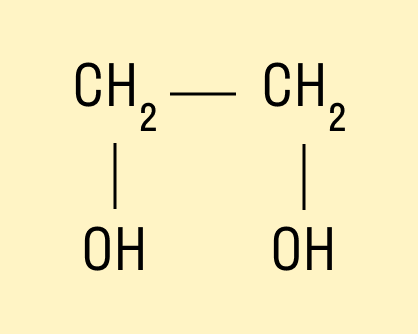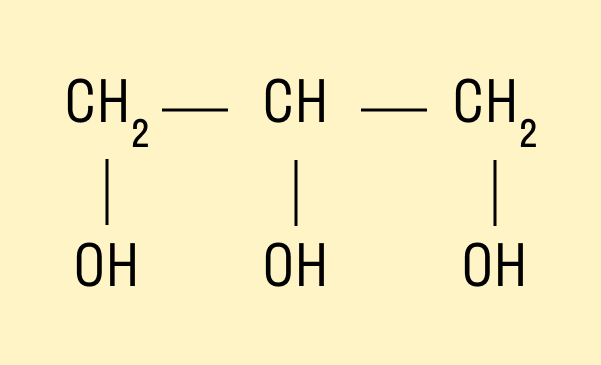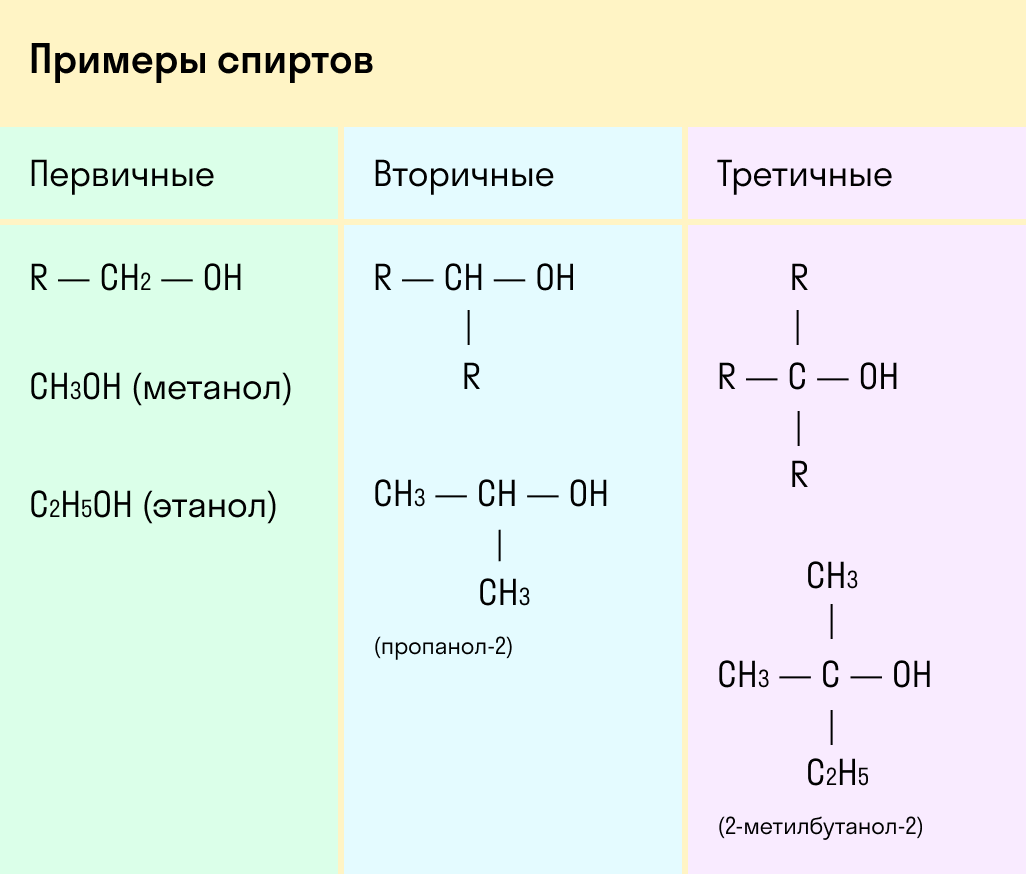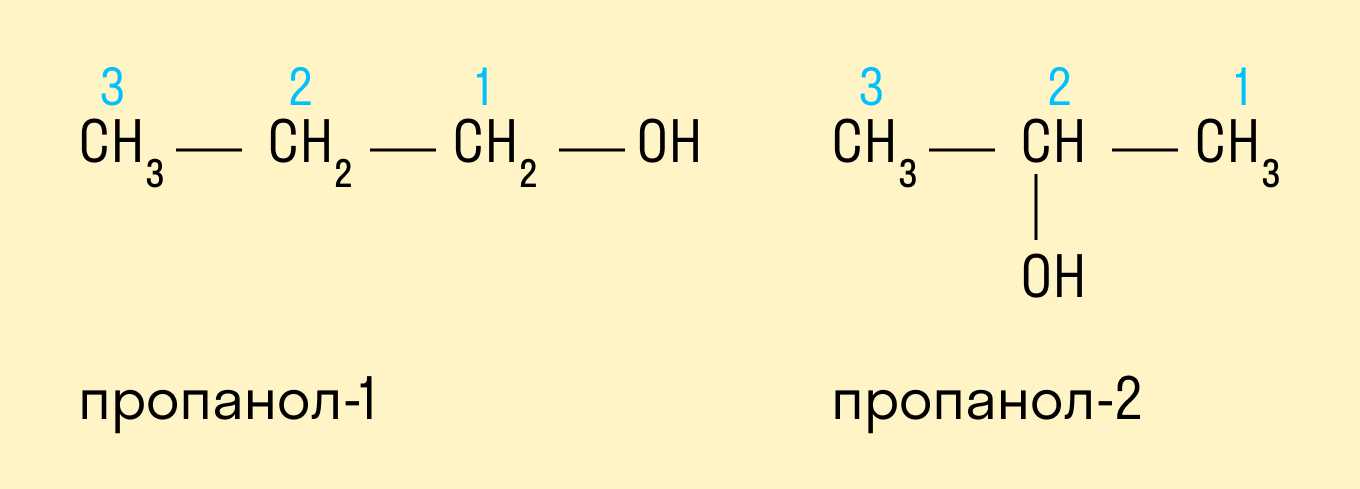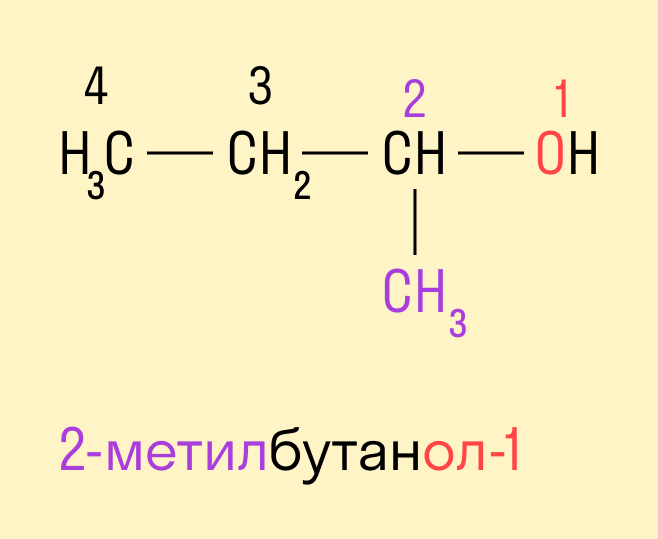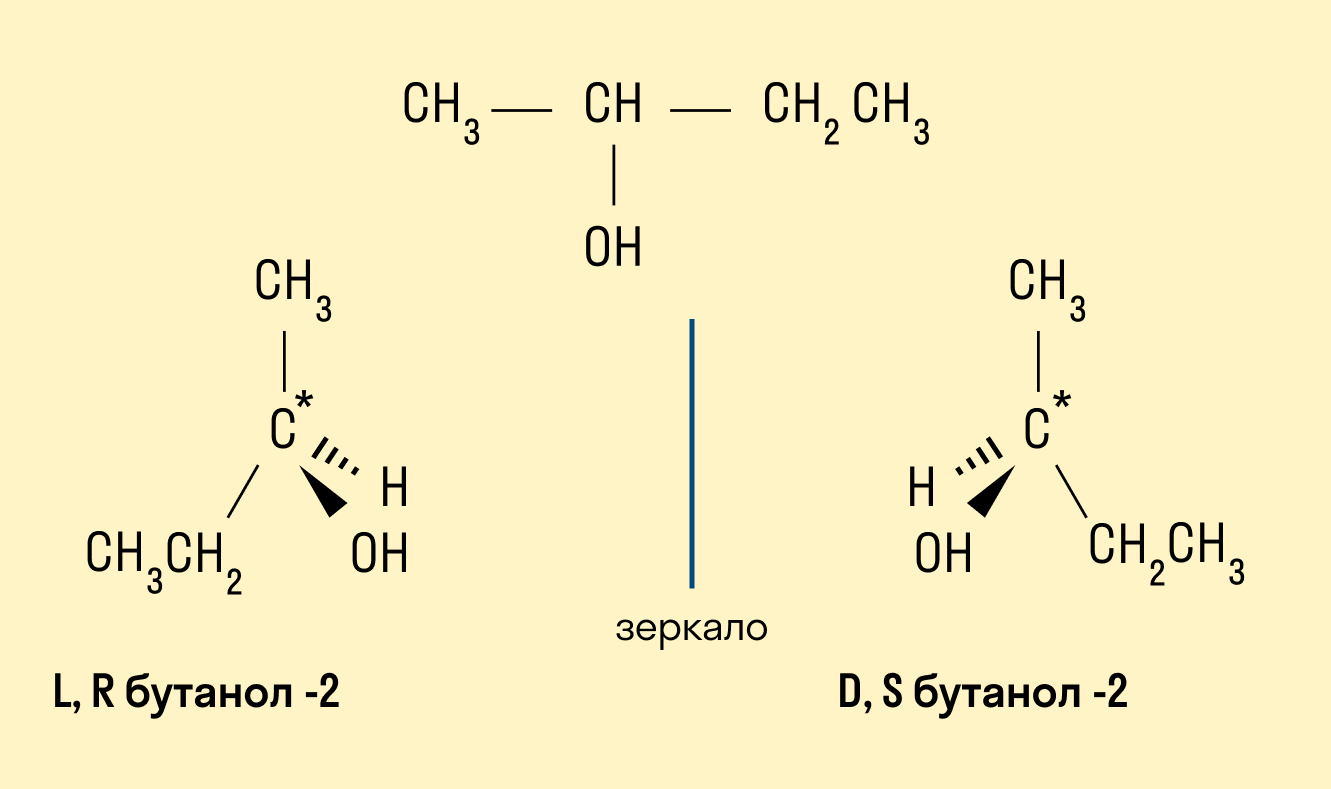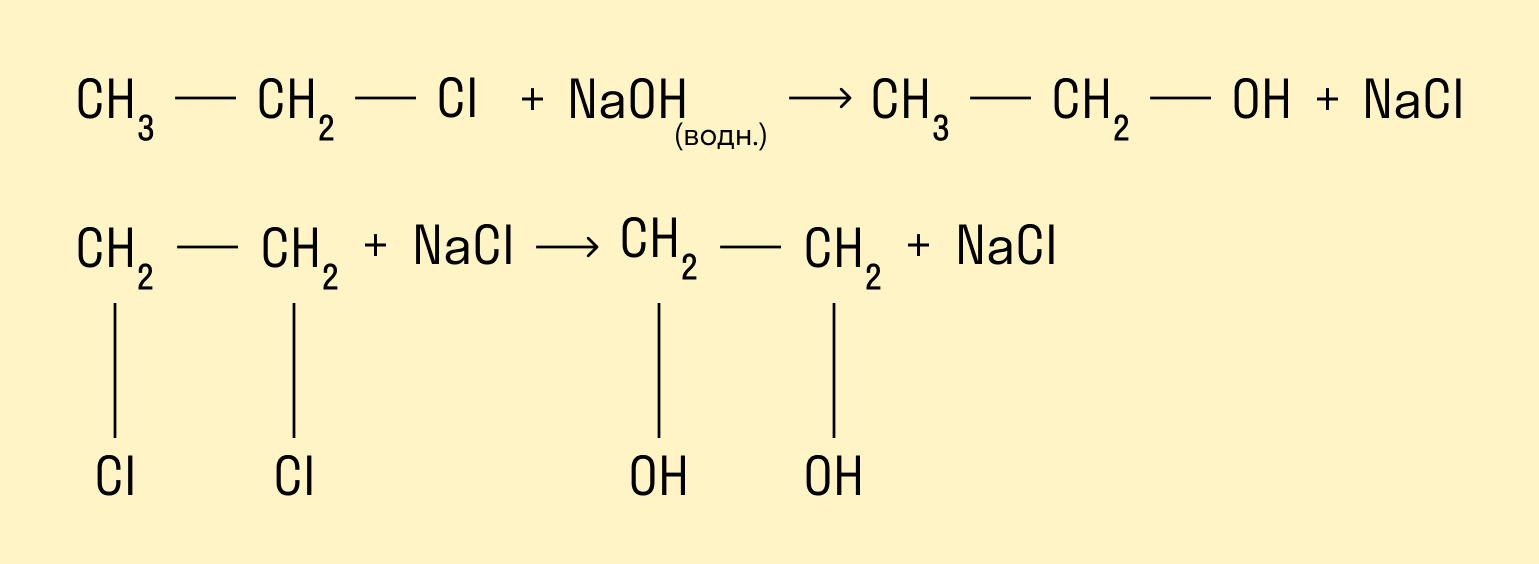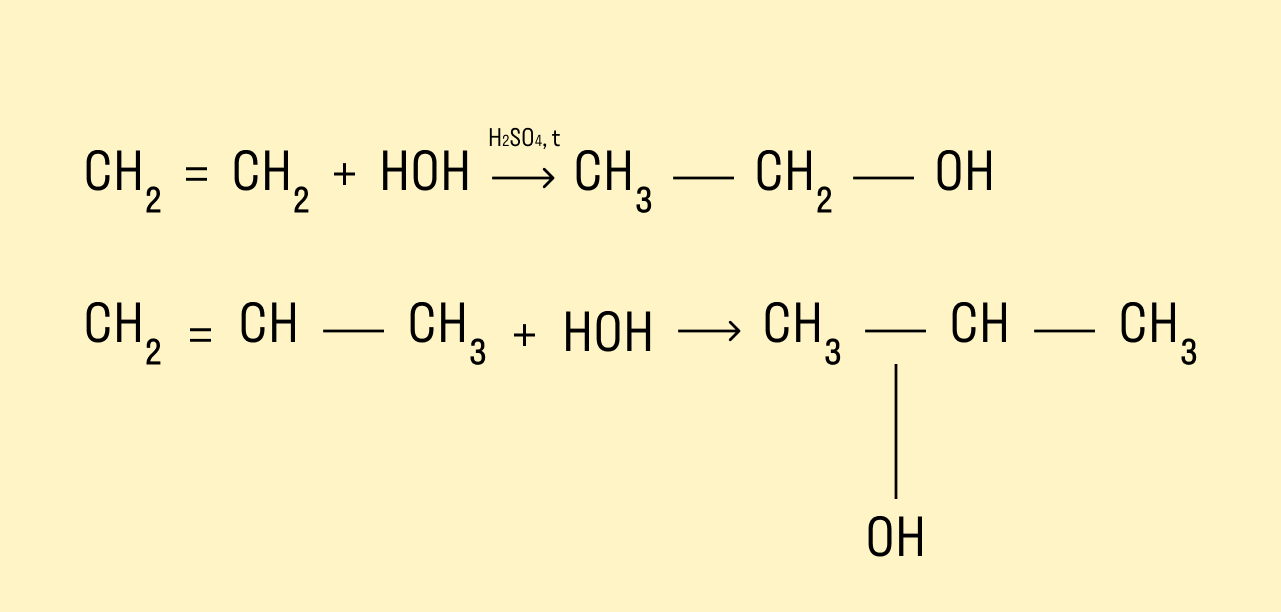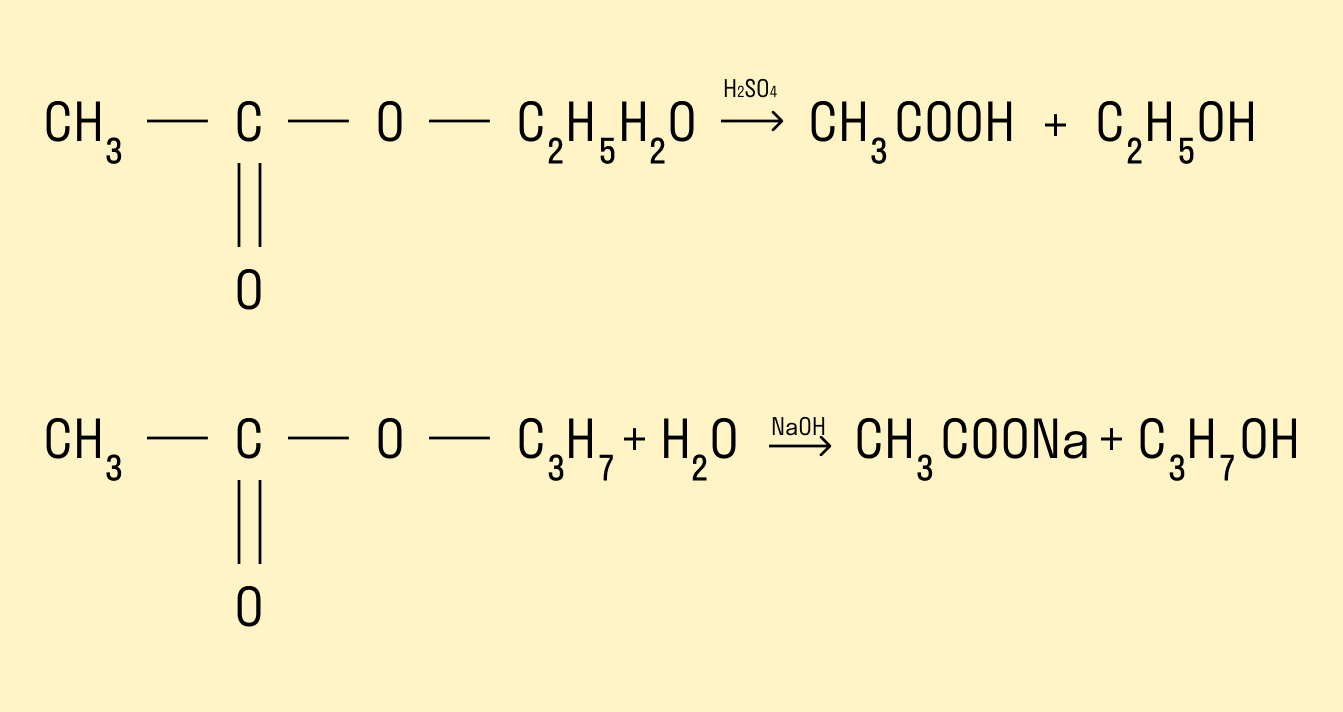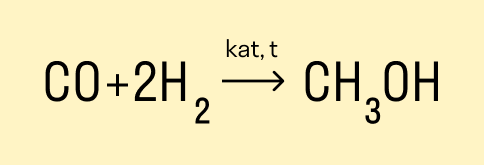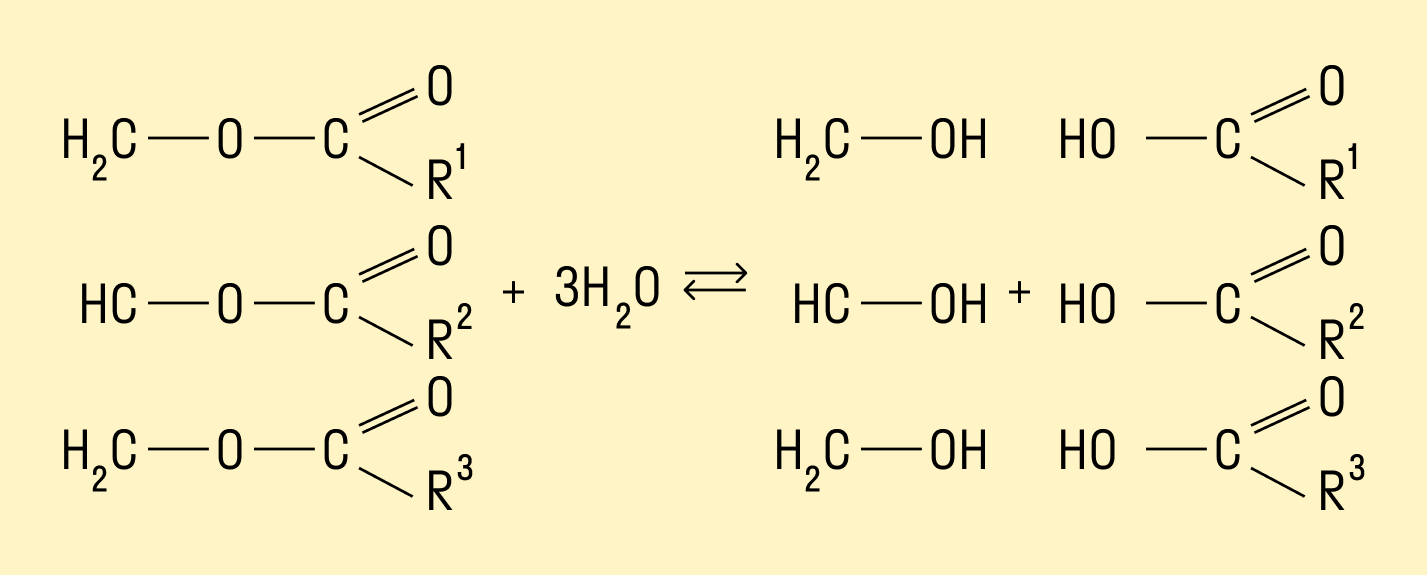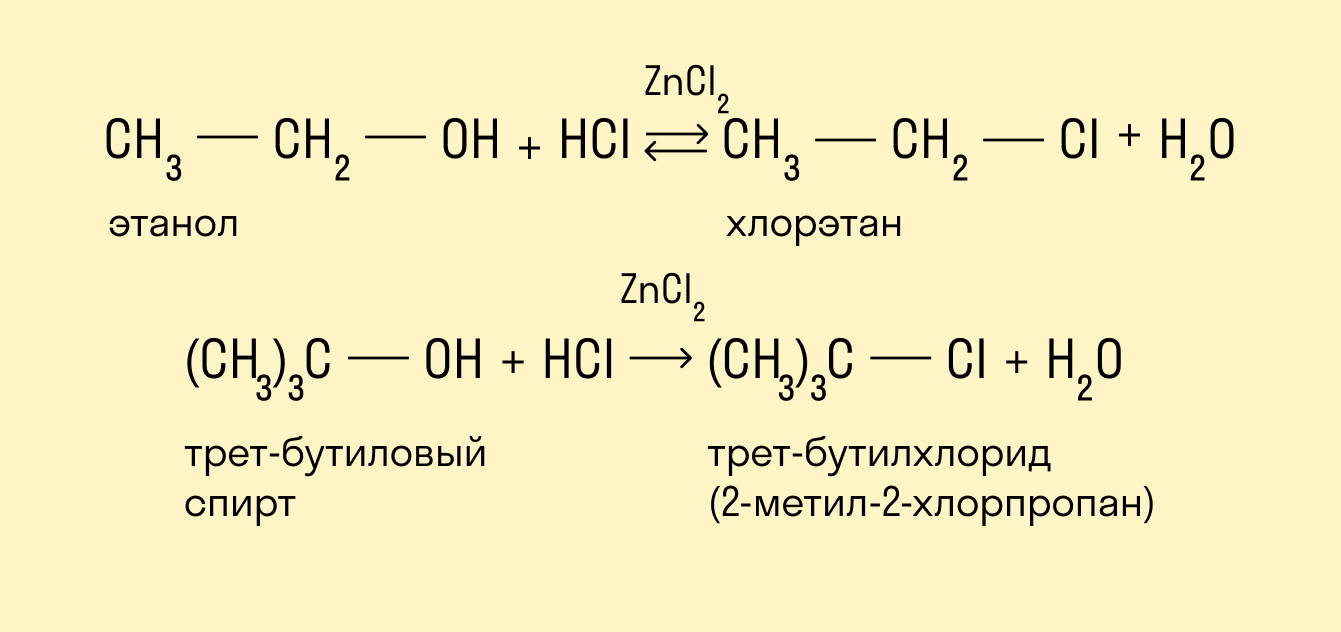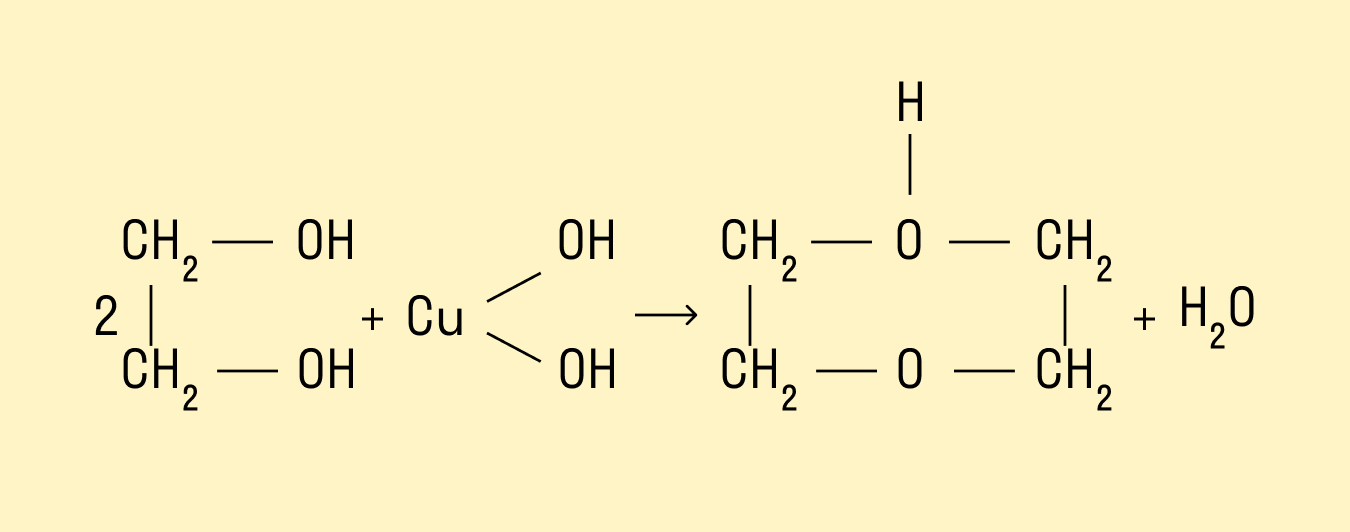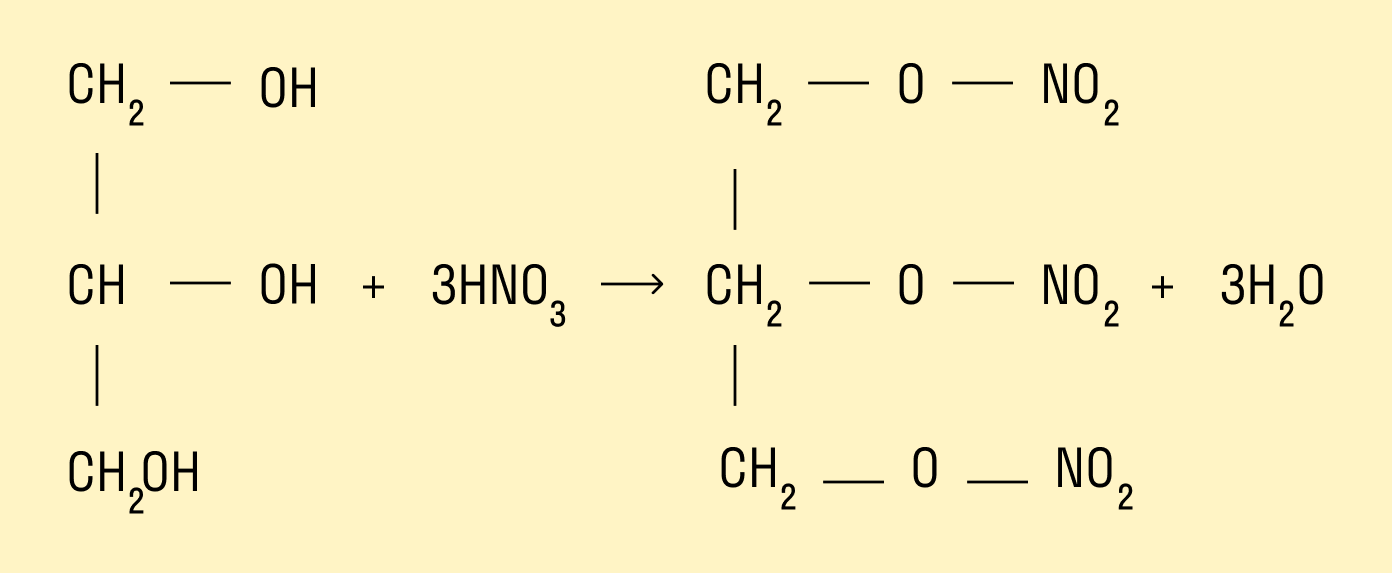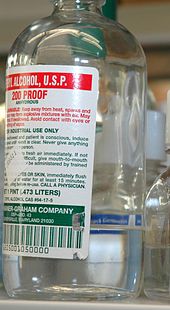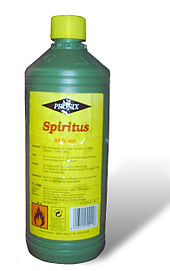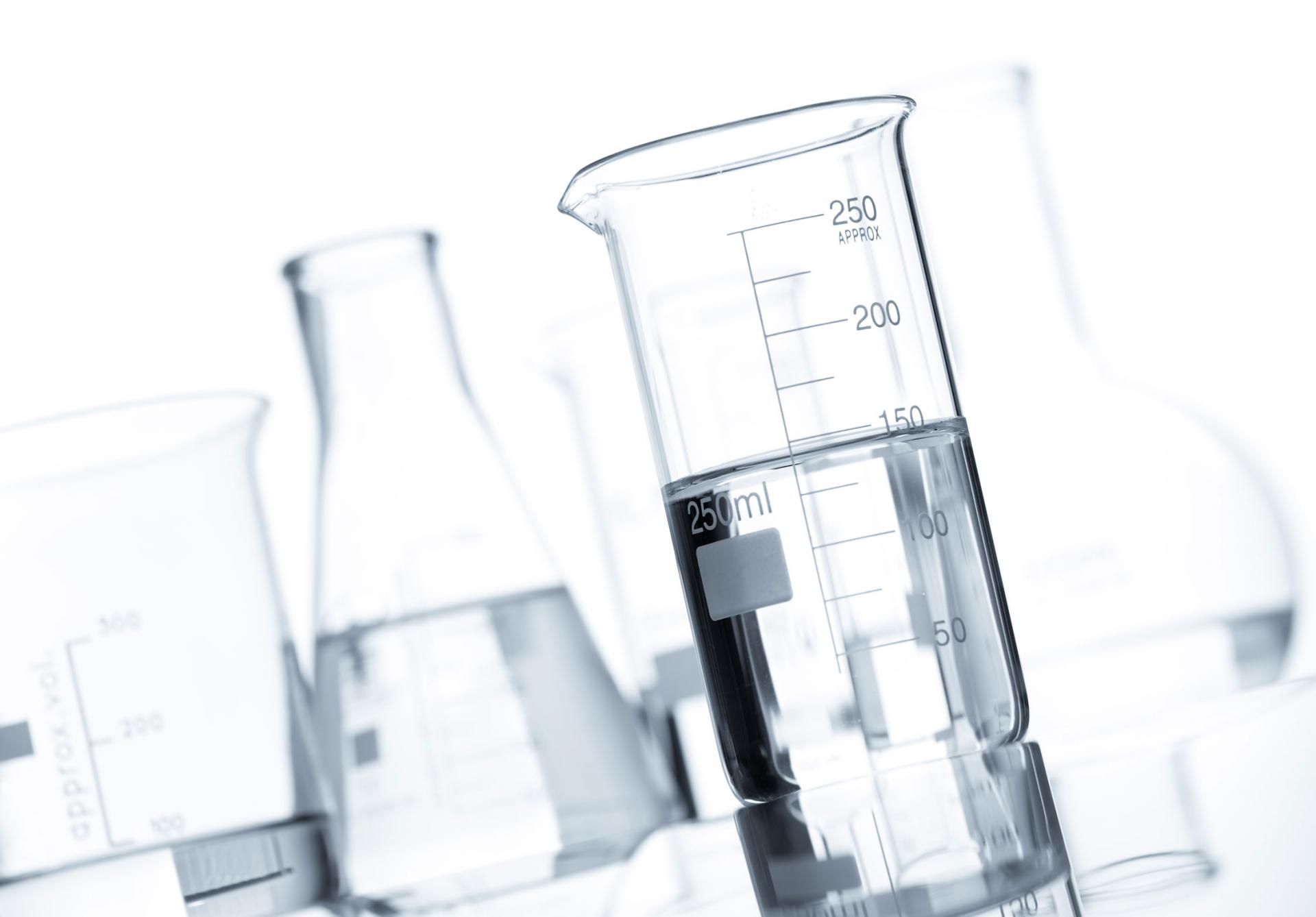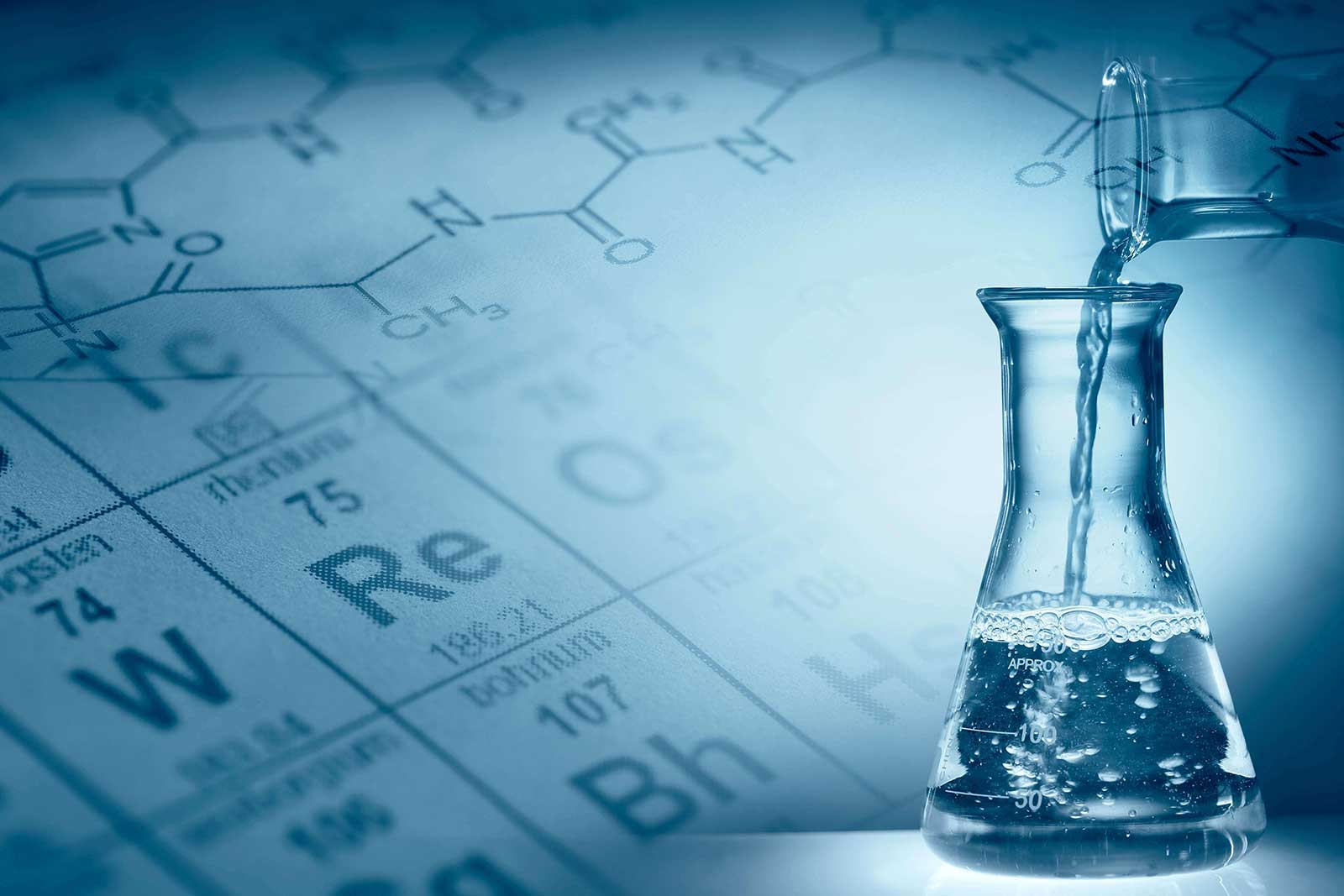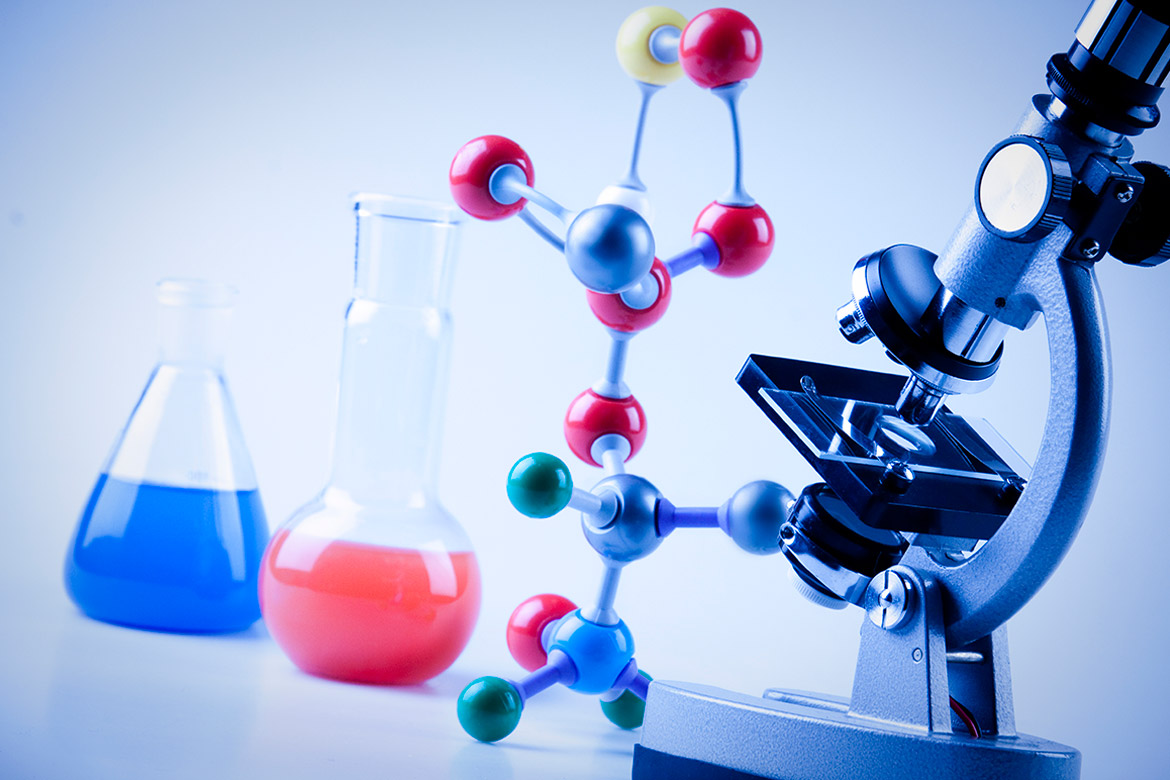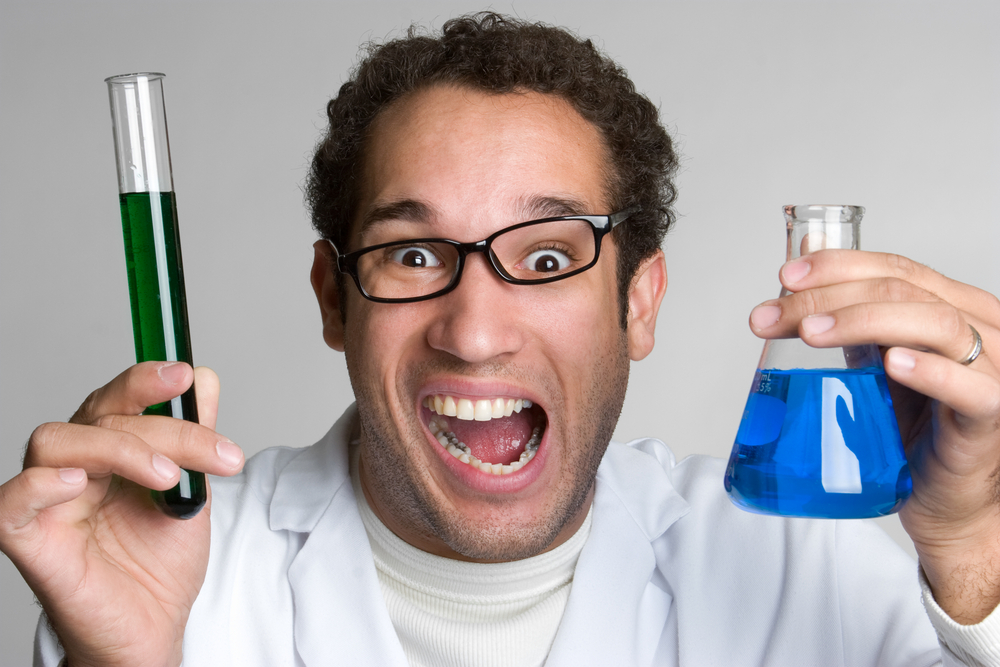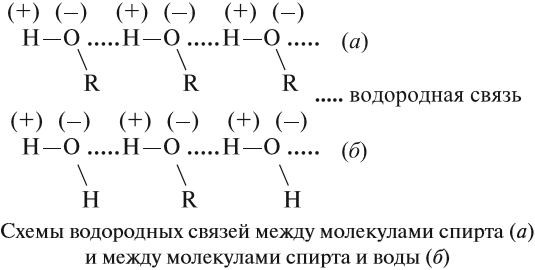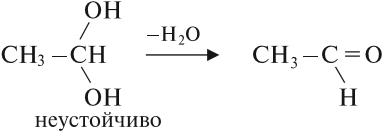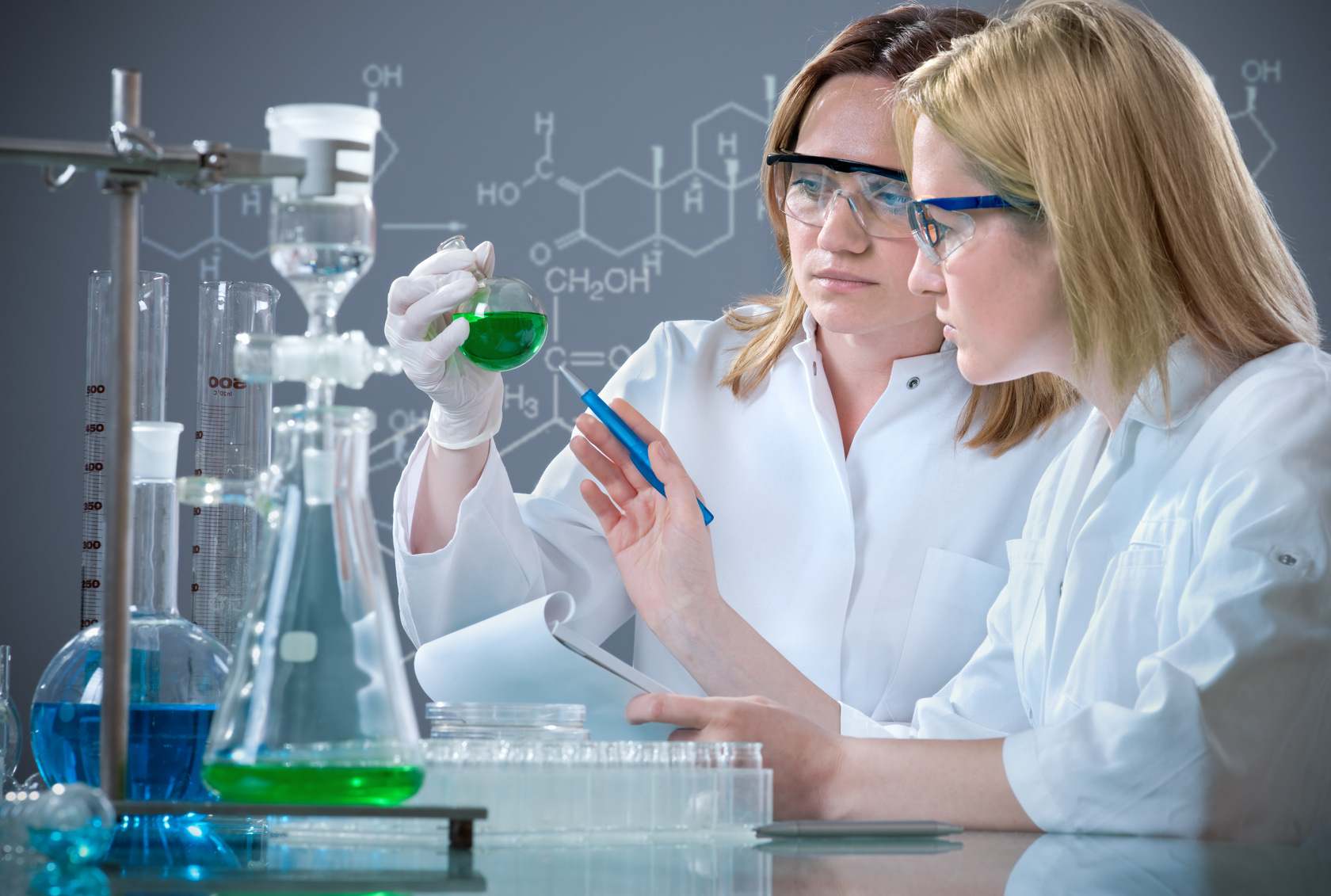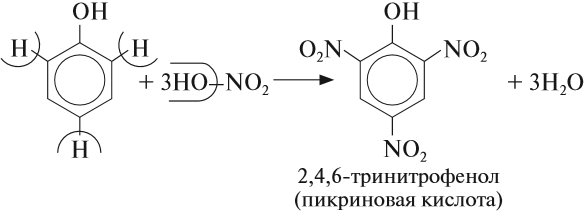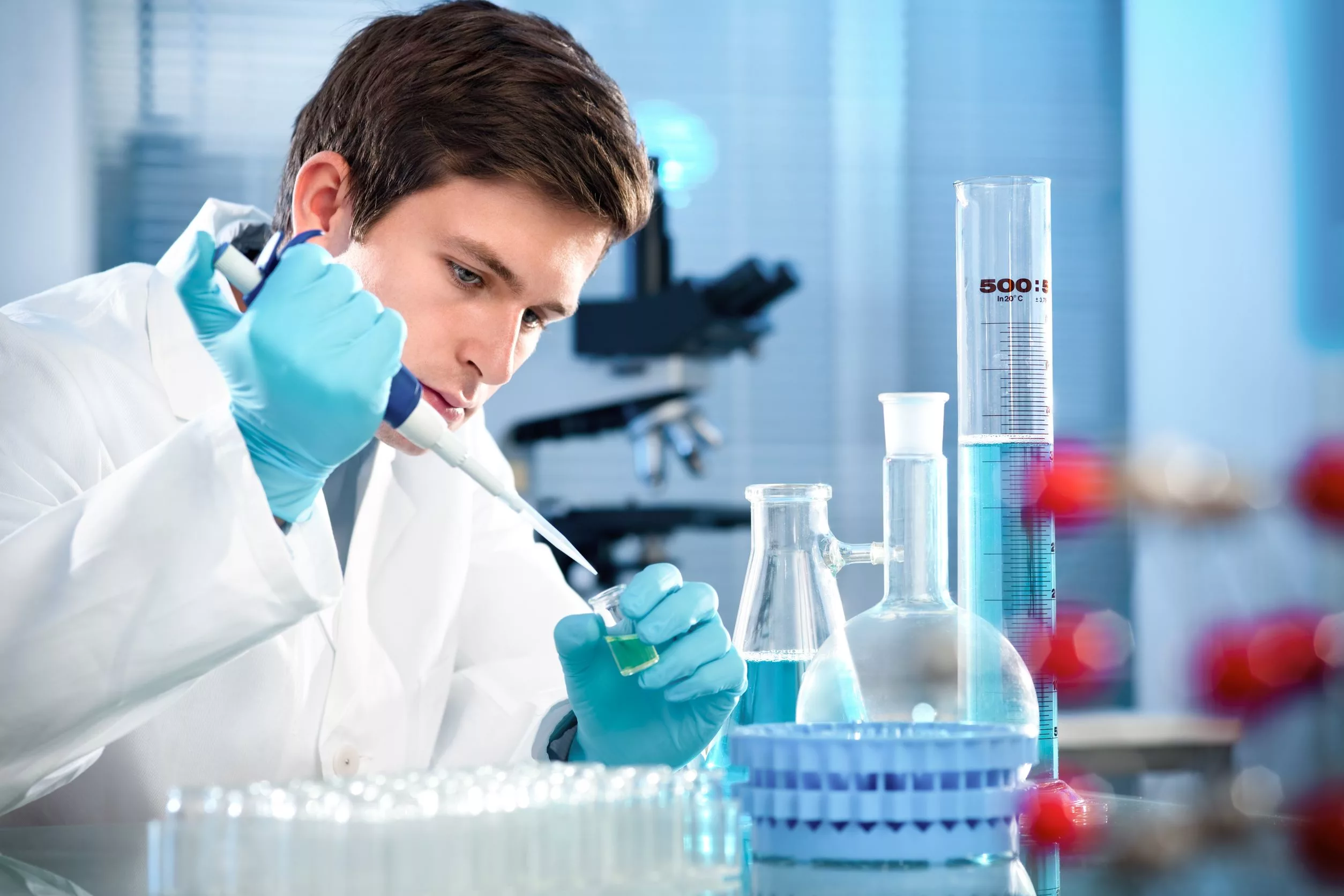Спирты — это большая группа химических соединений, производные углеводородов, у которых один или несколько атомов водорода замещены на гидроксильную группу ОН−.
Гидроксильная группа является функциональной группой спиртов.
Классификация спиртов
Спирты классифицируют по различным признакам: по количеству гидроксильных групп; по типу атома углерода, с которым связана гидроксогруппа; а также по строению углеводородного радикала.
По количеству гидроксогрупп
По этому признаку выделяют одноатомные и многоатомные спирты.
У одноатомных спиртов одна группа ОН−. Пример — этиловый спирт (этанол):
CH3—CH2—OH(C2H5OH).
У многоатомных — несколько групп ОН−.
Например, предельный двухатомный спирт этиленгликоль (этандиол):
HO—CH—CH—OH.
Трехатомный спирт глицерин:
HO—CH2—CH(OH)—CH2—OH.
Современное название многоатомных спиртов — полиолы (диолы, триолы и т. д.).
По типу атома углерода, с которым связана гидроксогруппа
Выделяют первичные, вторичные и третичные спирты. Показали примеры каждого вида спиртов в таблице.
По строению углеводородного радикала
По строению углеводородного радикала спирты бывают:
-
Предельные (этанол СН3—СН2—ОН);
-
Непредельные (пропенол СН2=СН—СН2—ОН);
-
Ароматические (фенилметанол С6Н5—СН2ОН).
Практикующий детский психолог Екатерина Мурашова
Бесплатный курс для современных мам и пап от Екатерины Мурашовой. Запишитесь и участвуйте в розыгрыше 8 уроков
Номенклатура спиртов
По систематической номенклатуре ИЮПАК (IUPAC)
Спиртам дают название по названию углеводорода с добавлением суффикса -ол и цифры, которая показывает положение гидроксильной группы. Для того, чтобы правильно определить, с каким по счету атомом углерода соединена гидроксильная группа, необходимо учитывать следующие правила:
-
Выбрать самую длинную углеводородную цепь, в состав которой входит гидроксильная группа. Таким образом устанавливают число атомов углерода и соответственно формируют название.
-
Нумерацию длинной цепи осуществляют с того края, к которому ближе расположена гидроксильная группа.
-
Местоположение гидроксогруппы в названии определяют написанием цифры после суффикса -ол.
Если в составе спирта присутствуют другие функциональные группы, то нумерация углеродного скелета начинается с того края, где расположена старшая функциональная группа. В таком случае перед названием указывают цифрой, от какого атома углерода идет ответвление.
Радикально-функциональная номенклатура
По такому способу название спирта формируется от названия радикала с добавлением слова «спирт». Например:
-
СH3—OH — метанол или метиловый спирт;
-
C2H5OH — этанол или этиловый спирт;
-
CH3—CH2—CH2—СН2—OH — бутанол или бутиловый спирт.
Тривиальная номенклатура
Тривиальные названия были даны спиртам по источнику природного получения. Например, метанол называют древесным спиртом, а этанол — винным спиртом. Показали некоторые тривиальные названия спиртов в таблице:
Изомерия спиртов
Изомерия — это явление существования соединений, у которых одинаковый качественный и количественный состав, но различное строение, а значит, разные свойства.
Давайте рассмотрим виды изомерии, которые характерны для спиртов.
Структурная
-
Изомерия углеродного скелета характерна для спиртов, в состав которых входит четыре и более атомов углерода.
-
Изомерия положения гидроксильной группы.
Межклассовая
Межклассовые изомеры — это вещества, которые относятся к разным классам и имеют различное строение, но одинаковый состав.
Для спиртов межклассовыми изомерами являются простые эфиры. Общая формула спиртов и простых эфиров — CnH2n+2O.
Пространственная (оптическая)
Например, бутанол-2, в молекуле которого второй атом углерода соединен с четырьмя различными заместителями, существует в форме двух различных оптических изомеров.
Получение спиртов
Гидролиз галогенопроизводных алканов
Галогенпроизводные алканов реагируют с водным раствором щелочей, результатом реакции является образование спиртов. Атом галогена в галогеналкане замещается на гидроксогруппу.
Гидратация алкенов
Присоединение молекул воды происходит в присутствии минеральных кислот и при нагревании.
Если в реакцию вступают несимметричные алкены, то процесс гидратации подчиняется правилу Марковникова. Атом водорода присоединяется к наиболее гидрированному атому углерода, а гидроксогруппа соединяется с соседним атомом углерода, наименее гидрированным.
Восстановление альдегидов и кетонов
Восстановление проводят каталитическим гидрированием карбонильной группы. Катализаторами могут быть никель, платина, палладий. Первичные спирты образуются из альдегидов, вторичные — из кетонов.
СН3—СНО + Н2 → CH3—CH2—OH
CH3—C(O)—CH3 + H2 → CH3—CH(OH)—CH3
Альдегиды и кетоны можно восстанавливать, действуя на них разными восстановителями, например, комплексным алюмогидридом лития LiAlH4.
Реакция Канниццаро
Это окислительно-восстановительная реакция диспропорционирования альдегидов в первичные спирты и карбоновые кислоты под действием оснований.
2СH3—CHO + NaOH → CH3—CH2—OH + CH3—COONa
Гидролиз сложных эфиров
Процесс гидролиза заключается в том, что под действием воды происходит расщепление сложных эфиров. Гидролиз может протекать в кислой и щелочной среде. Гидролиз в щелочной среде является процессом необратимым, так как происходит омыление, т. е. образование солей карбоновых кислот.
Синтез Гриньяра
Синтез с использованием реактива Гриньяра. Реактивы Гриньяра — магнийорганические соединения, содержащие ковалентную связь C—Mg. Чаще всего их получают из органилгалогенидов вида R—X, где X = Cl, Br, I и магния в безводной среде.
-
Первичные спирты получают из муравьиного альдегида.
-
Уксусный альдегид и другие альдегиды дают вторичные спирты.
-
Кетоны и сложные эфиры образуют третичные спирты.
Получение метанола из синтез-газа
Основной промышленный метод получения метанола состоит из двух этапов:
-
Получение синтез-газа с помощью паровой, парокислородной или пароуглекислотной конверсии природного газа.
-
Синтез метанола путем восстановления оксида и диоксида углерода водородом на катализаторе.
Получение этанола
Этанол можно получить путем ферментативного брожения глюкозы (спиртовое брожение).
С6Н12О6 → 2C2H5OH + 2CO2
Реакция Вагнера
Окисление алкенов холодным раствором перманганатом калия в нейтральной среде (реакция Вагнера).
3CH2=CH2 + 2KMnO4 + 4H2O → HO—CH2—CH2—OH + 2MnO2 + 2KOH
Гидролиз жиров
Многоатомные спирты можно получить путем гидролиза жиров. При взаимодействии кислот с жирами происходит образование глицерина и карбоновых кислот.
Физические свойства спиртов
В основном все виды спиртов — это жидкости, имеющие относительно высокие температуры кипения. Температуры кипения выше у многоатомных спиртов и фенолов.
Температуры кипения спиртов
Химические свойства одноатомных спиртов
Общая формула одноатомных предельных спиртов: CnH2n+1OH. В спиртах, одноатомных и многоатомных, помимо связи между углеродом и водородом (С—ОН), есть еще одна связь между кислородом и водородом (О—Н). Поэтому химические реакции проходят с разрывом одной из цепей:
-
реакции восстановления проходят с отщеплением гидроксильной группы от молекулы спирта;
-
реакции окисления — с отщеплением водорода.
Низшие спирты (метанол, этанол, пропанол, изопропанол, этиленгликоль и глицерин) смешиваются с водой в любых соотношениях.
Кислотно-основные свойства
Согласно теории Бренстеда-Лоури спирты — достаточно слабые кислоты. Кислотность спиртов уменьшается по мере усложнения углеродного скелета.
-
Взаимодействие со щелочными металлами:
2С2Н5ОН + 2Na → 2C2H5ONa + H2. -
Взаимодействие со щелочами:
С2H5OH + NaOH ⇄ C2H5ONa + H2O.
Спирты — более слабые кислоты, чем вода, поэтому невозможна реакция с водными растворами щелочей. Взаимодействие с твердыми щелочами возможно, реакция обратима. Равновесие сильно смещено влево.
Основность кислот увеличивается по мере увеличения углеродного скелета.
Замещение гидроксогруппы
Гидроксогруппа является плохо уходящей. Энергия разрыва связи С—О довольно высока, поэтому непосредственное замещение группы ОН на другую группу невозможно.
Для того, чтобы замещение было возможно, группу ОН превращают в хорошо уходящую, т. е. понижают энергию разрыва связи. Для этого:
-
проводят реакцию в кислой среде;
-
переводят гидроксигруппу в сульфогруппу применяя H2SO4;
-
применяют кислоты Льюиса.
R—OH + PCl5 → R—Cl + POCl3 + HCl
R—OH + SOCl2 → R—Cl + SO2 + HCl
R—OH + HCl → R—Cl + H2O
R—OH + PBr → R—Br + H3PO3
R—OH + KBr + H2SO4 → R—Br + KHSO4 + H2O
Реакция с использованием реактива Лукаса
Реактив Лукаса — это смесь ZnCl2 и HCl. Скорость реакции убывает при упрощении углеродного скелета. Внешним признаком реакции служит расслоение реакционной смеси в случае образования хлоруглеводорода R—Cl, представляющего собой маслообразное нерастворимое вещество.
Быстрее всего реагируют третичные спирты, слой нерастворимого алкилгалогенида появляется фактически сразу же после смешения реагентов — меньше чем за минуту.
Вторичные спирты вначале растворяются в реактиве, но затем раствор мутнеет, в течение 5 минут появляются капли алкилгалогенида.
Растворы первичных спиртов остаются прозрачными, они образуют хлориды только при нагревании.
Дегидратация спиртов
При температуре &rt; 140°C и в присутствии серной кислоты происходит внутримолекулярная дегидратация. В результате реакции получается алкен.
При температуре < 140°C и в присутствии серной кислоты происходит межмолекулярная дегидратация. В результате образуется простой эфир.
Реакция этерификации — получение сложных эфиров
Предельные одноатомные спирты вступают в химические реакции с карбоновыми кислотами, продукты таких реакций — сложные эфиры.
Взаимодействие с аммиаком
Эта реакция происходит при нагревании и в присутствии катализатора. Гидроксогруппа замещается на аминогруппу. Продукт реакции — амин.
Окисление
-
Горение спиртов:
C2H5OH + 3O2 → 2CO2 + 3H2O. -
Жидкофазное окисление с применением хромовой смеси K2Cr2O7 + H2SO4:
3C2H5OH + K2Cr2O7 + 4H2SO4 → 3CH3COOH + K2SO4 + Cr2(SO4)3 + H2O. -
Окисление оксидом меди (II) при нагревании:
CH3—CH2—OH + CuO → CH3—CHO + Cu + H2O.
Первичные спирты при окислении образуют альдегиды, вторичные переходят в кетоны, третичные окисляются с разрушением углеродного скелета.
Химические свойства многоатомных спиртов
В целом многоатомные спирты сходны с одноатомными, но имеют особенности: проявляют более сильные кислотные свойства и вступают в специфические реакции.
Кислотные свойства
Многоатомные спирты взаимодействуют с щелочными металлами:
Взаимодействие со свежеосажденным гидроксидом меди (II)
Это качественная реакция на многоатомные спирты:
Окисление йодной кислотой и ее солями
Образование эфиров с азотной кислотой
Вопросы для самопроверки
-
Что такое спирты?
-
Что образуется при межмолекулярной дегидратации спиртов?
-
Какую качественную реакцию имеют многоатомные спирты?
-
Какой характерной реакцией можно получить этанол?
-
Напишите все виды изомерии для пентанола-1.
-
Как классифицируют спирты?
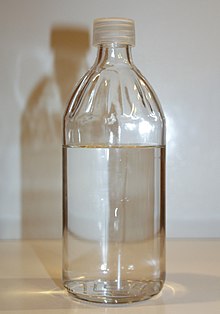
|
||
|
||
|
||
| Names | ||
|---|---|---|
| Pronunciation | ||
| Preferred IUPAC name
Ethanol[1] |
||
| Other names
absolute alcohol |
||
| Identifiers | ||
|
CAS Number |
|
|
|
3D model (JSmol) |
|
|
| 3DMet |
|
|
|
Beilstein Reference |
1718733 | |
| ChEBI |
|
|
| ChEMBL |
|
|
| ChemSpider |
|
|
| DrugBank |
|
|
| ECHA InfoCard | 100.000.526 |
|
|
Gmelin Reference |
787 | |
|
IUPHAR/BPS |
|
|
| KEGG |
|
|
|
PubChem CID |
|
|
| UNII |
|
|
| UN number | UN 1170 | |
|
CompTox Dashboard (EPA) |
|
|
|
InChI
|
||
|
SMILES
|
||
| Properties | ||
|
Chemical formula |
C2H6O | |
| Molar mass | 46.069 g·mol−1 | |
| Appearance | Colourless liquid | |
| Odor | wine-like, pungent[2] | |
| Density | 0.78945 g/cm3 (at 20 °C)[3] | |
| Melting point | −114.14 ± 0.03[3] °C (−173.45 ± 0.05 °F; 159.01 ± 0.03 K) | |
| Boiling point | 78.23 ± 0.09[3] °C (172.81 ± 0.16 °F; 351.38 ± 0.09 K) | |
|
Solubility in water |
Miscible | |
| log P | −0.18 | |
| Vapor pressure | 5.95 kPa (at 20 °C) | |
| Acidity (pKa) | 15.9 (H2O), 29.8 (DMSO)[4][5] | |
|
Magnetic susceptibility (χ) |
−33.60·10−6 cm3/mol | |
|
Refractive index (nD) |
1.3611[3] | |
| Viscosity | 1.2 mPa·s (at 20 °C), 1.074 mPa·s (at 25 °C)[6] | |
|
Dipole moment |
1.69 D[7] | |
| Hazards | ||
| GHS labelling: | ||
|
Pictograms |
 
|
|
|
Signal word |
Danger | |
|
Hazard statements |
H225, H319 | |
|
Precautionary statements |
P210, P280, P305+P351+P338 | |
| NFPA 704 (fire diamond) |
2 3 0 |
|
| Flash point | 14 °C (Absolute)[9] | |
| Lethal dose or concentration (LD, LC): | ||
|
LD50 (median dose) |
7340 mg/kg (oral, rat) 7300 mg/kg (mouse) |
|
| NIOSH (US health exposure limits): | ||
|
PEL (Permissible) |
TWA 1000 ppm (1900 mg/m3)[10] | |
|
REL (Recommended) |
TWA 1000 ppm (1900 mg/m3)[10] | |
|
IDLH (Immediate danger) |
N.D.[10] | |
| Safety data sheet (SDS) | [8] | |
| Related compounds | ||
|
Related compounds |
Ethane Methanol |
|
| Supplementary data page | ||
| Ethanol (data page) | ||
|
Except where otherwise noted, data are given for materials in their standard state (at 25 °C [77 °F], 100 kPa).
Infobox references |
Ethanol (abbr. EtOH; also called ethyl alcohol, grain alcohol, drinking alcohol, or simply alcohol) is an organic compound. It is an alcohol with the chemical formula C2H6O. Its formula can be also written as CH3−CH2−OH or C2H5OH (an ethyl group linked to a hydroxyl group). Ethanol is a volatile, flammable, colorless liquid with a characteristic wine-like odor and pungent taste.[11][12] It is a psychoactive recreational drug, the active ingredient in alcoholic drinks.
Ethanol is naturally produced by the fermentation process of sugars by yeasts or via petrochemical processes such as ethylene hydration. Historically it was used as a general anesthetic, and has modern medical applications as an antiseptic, disinfectant, solvent for some medications, and antidote for methanol poisoning and ethylene glycol poisoning.[13][14] It is used as a chemical solvent and in the synthesis of organic compounds, and as a fuel source. Ethanol also can be dehydrated to make ethylene, an important chemical feedstock. As of 2006, world production of ethanol was 51 gigalitres (1.3×1010 US gallons), coming mostly from Brazil and the U.S.[15]
Etymology[edit]
Ethanol is the systematic name defined by the International Union of Pure and Applied Chemistry for a compound consisting of an alkyl group with two carbon atoms (prefix «eth-«), having a single bond between them (infix «-an-«) and an attached −OH functional group (suffix «-ol»).[16]
The «eth-» prefix and the qualifier «ethyl» in «ethyl alcohol» originally come from the name «ethyl» assigned in 1834 to the group C
2H
5− by Justus Liebig. He coined the word from the German name Aether of the compound C
2H
5−O−C
2H
5 (commonly called «ether» in English, more specifically called «diethyl ether»).[17] According to the Oxford English Dictionary, Ethyl is a contraction of the Ancient Greek αἰθήρ (aithḗr, «upper air») and the Greek word ὕλη (hýlē, «substance»).[18]
The name ethanol was coined as a result of a resolution on naming alcohols and phenols that was adopted at the International Conference on Chemical Nomenclature that was held in April 1892 in Geneva, Switzerland.[19]
The term alcohol now refers to a wider class of substances in chemistry nomenclature, but in common parlance it remains the name of ethanol. It is a medieval loan from Arabic al-kuḥl, a powdered ore of antimony used since antiquity as a cosmetic, and retained that meaning in Middle Latin.[20] The use of ‘alcohol’ for ethanol (in full, «alcohol of wine») is modern and was first recorded in 1753. Before the late 18th century the term «alcohol» generally referred to any sublimated substance.[21]
Uses[edit]
Medical[edit]
Anesthetic[edit]
Ethanol is the oldest known sedative, used as an oral general anesthetic during surgery in ancient Mesopotamia and in medieval times.[13][14] Mild intoxication starts at a blood alcohol concentration of 0.03-0.05% and induces anesthetic coma at 0.4%.[22] However, this use carried the high risk of deadly alcohol intoxication and pulmonary aspiration on vomit, which led to use of alternatives in antiquity, such as opium, cannabis, and later diethyl ether in the late Middle Ages.
Antiseptic[edit]
Ethanol is used in medical wipes and most commonly in antibacterial hand sanitizer gels as an antiseptic for its bactericidal and anti-fungal effects.[23] Ethanol kills microorganisms by dissolving their membrane lipid bilayer and denaturing their proteins, and is effective against most bacteria, fungi and viruses. However, it is ineffective against bacterial spores, but that can be alleviated by using hydrogen peroxide.[24] A solution of 70% ethanol is more effective than pure ethanol because ethanol relies on water molecules for optimal antimicrobial activity. Absolute ethanol may inactivate microbes without destroying them because the alcohol is unable to fully permeate the microbe’s membrane.[25][26] Ethanol can also be used as a disinfectant and antiseptic because it causes cell dehydration by disrupting the osmotic balance across the cell membrane, so water leaves the cell leading to cell death.[27]
Antidote[edit]
Ethanol may be administered as an antidote to ethylene glycol poisoning[28] and methanol poisoning.[29] Ethanol serves this process by acting as a competitive inhibitor against methanol and ethylene glycol for alcohol dehydrogenase.[30] Though it has more side effects, ethanol is less expensive and more readily available than fomepizole, which is also used as an antidote for methanol and ethylene glycol poisoning.[31]
Medicinal solvent[edit]
Ethanol, often in high concentrations, is used to dissolve many water-insoluble medications and related compounds. Liquid preparations of pain medications, cough and cold medicines, and mouth washes, for example, may contain up to 25% ethanol[32] and may need to be avoided in individuals with adverse reactions to ethanol such as alcohol-induced respiratory reactions.[33] Ethanol is present mainly as an antimicrobial preservative in over 700 liquid preparations of medicine including acetaminophen, iron supplements, ranitidine, furosemide, mannitol, phenobarbital, trimethoprim/sulfamethoxazole and over-the-counter cough medicine.[34]
Pharmacology[edit]
In mammals, ethanol is primarily metabolized in the liver and stomach by alcohol dehydrogenase (ADH) enzymes.[35] These enzymes catalyze the oxidation of ethanol into acetaldehyde (ethanal):[36]
- CH3CH2OH + NAD+ → CH3CHO + NADH + H+
When present in significant concentrations, this metabolism of ethanol is additionally aided by the cytochrome P450 enzyme CYP2E1 in humans, while trace amounts are also metabolized by catalase.[37]
The resulting intermediate, acetaldehyde, is a known carcinogen, and poses significantly greater toxicity in humans than ethanol itself. Many of the symptoms typically associated with alcohol intoxication—as well as many of the health hazards typically associated with the long-term consumption of ethanol—can be attributed to acetaldehyde toxicity in humans.[38]
The subsequent oxidation of acetaldehyde into acetate is performed by aldehyde dehydrogenase (ALDH) enzymes. A mutation in the ALDH2 gene that encodes for an inactive or dysfunctional form of this enzyme affects roughly 50% of east Asian populations, contributing to the characteristic alcohol flush reaction that can cause temporary reddening of the skin as well as a number of related, and often unpleasant, symptoms of acetaldehyde toxicity.[39] This mutation is typically accompanied by another mutation in the alcohol dehydrogenase enzyme ADH1B in roughly 80% of east Asians, which improves the catalytic efficiency of converting ethanol into acetaldehyde.[39]
Recreational[edit]
As a central nervous system depressant, ethanol is one of the most commonly consumed psychoactive drugs.[40]
Despite alcohol’s psychoactive and carcinogenic properties, it is readily available and legal for sale in most countries. However, there are laws regulating the sale, exportation/importation, taxation, manufacturing, consumption, and possession of alcoholic beverages. The most common regulation is prohibition for minors.
Fuel[edit]
Corn vs ethanol production in the United States
Total corn production (bushels) (left)
Percent of corn used for Ethanol (right)
Engine fuel[edit]
| Fuel type | MJ/L | MJ/kg | Research octane number |
|---|---|---|---|
| Dry wood (20% moisture) | ~19.5 | ||
| Methanol | 17.9 | 19.9 | 108.7[41] |
| Ethanol | 21.2[42] | 26.8[42] | 108.6[41] |
| E85 (85% ethanol, 15% gasoline) |
25.2 | 33.2 | 105 |
| Liquefied natural gas | 25.3 | ~55 | |
| Autogas (LPG) (60% propane + 40% butane) |
26.8 | 50 | |
| Aviation gasoline (high-octane gasoline, not jet fuel) |
33.5 | 46.8 | 100/130 (lean/rich) |
| Gasohol (90% gasoline + 10% ethanol) |
33.7 | 47.1 | 93/94 |
| Regular gasoline/petrol | 34.8 | 44.4[43] | min. 91 |
| Premium gasoline/petrol | max. 104 | ||
| Diesel | 38.6 | 45.4 | 25 |
| Charcoal, extruded | 50 | 23 |
The largest single use of ethanol is as an engine fuel and fuel additive. Brazil in particular relies heavily upon the use of ethanol as an engine fuel, due in part to its role as one of the world’s leading producers of ethanol.[44][45] Gasoline sold in Brazil contains at least 25% anhydrous ethanol. Hydrous ethanol (about 95% ethanol and 5% water) can be used as fuel in more than 90% of new gasoline-fueled cars sold in the country.
The US and many other countries primarily use E10 (10% ethanol, sometimes known as gasohol) and E85 (85% ethanol) ethanol/gasoline mixtures. Over time, it is believed that a material portion of the ≈150-billion-US-gallon (570,000,000 m3) per year market for gasoline will begin to be replaced with fuel ethanol.[46]
Australian law limits the use of pure ethanol from sugarcane waste to 10% in automobiles. Older cars (and vintage cars designed to use a slower burning fuel) should have the engine valves upgraded or replaced.[47]
According to an industry advocacy group, ethanol as a fuel reduces harmful tailpipe emissions of carbon monoxide, particulate matter, oxides of nitrogen, and other ozone-forming pollutants.[48] Argonne National Laboratory analyzed greenhouse gas emissions of many different engine and fuel combinations, and found that biodiesel/petrodiesel blend (B20) showed a reduction of 8%, conventional E85 ethanol blend a reduction of 17% and cellulosic ethanol 64%, compared with pure gasoline.[49] Ethanol has a much greater research octane number (RON) than gasoline, meaning it is less prone to pre-ignition, allowing for better ignition advance which means more torque, and efficiency in addition to the lower carbon emissions.[50]
Ethanol combustion in an internal combustion engine yields many of the products of incomplete combustion produced by gasoline and significantly larger amounts of formaldehyde and related species such as acetaldehyde.[51] This leads to a significantly larger photochemical reactivity and more ground level ozone.[52] This data has been assembled into The Clean Fuels Report comparison of fuel emissions[53] and show that ethanol exhaust generates 2.14 times as much ozone as gasoline exhaust.[54] When this is added into the custom Localized Pollution Index (LPI) of The Clean Fuels Report, the local pollution of ethanol (pollution that contributes to smog) is rated 1.7, where gasoline is 1.0 and higher numbers signify greater pollution.[55] The California Air Resources Board formalized this issue in 2008 by recognizing control standards for formaldehydes as an emissions control group, much like the conventional NOx and Reactive Organic Gases (ROGs).[56]
More than 20% of Brazilian cars are able to use 100% ethanol as fuel, which includes ethanol-only engines and flex-fuel engines.[57] Flex-fuel engines in Brazil are able to work with all ethanol, all gasoline or any mixture of both. In the U.S. flex-fuel vehicles can run on 0% to 85% ethanol (15% gasoline) since higher ethanol blends are not yet allowed or efficient. Brazil supports this fleet of ethanol-burning automobiles with large national infrastructure that produces ethanol from domestically grown sugarcane.
Ethanol’s high miscibility with water makes it unsuitable for shipping through modern pipelines like liquid hydrocarbons.[58] Mechanics have seen increased cases of damage to small engines (in particular, the carburetor) and attribute the damage to the increased water retention by ethanol in fuel.[59]
Rocket fuel[edit]
Ethanol was commonly used as fuel in early bipropellant rocket (liquid-propelled) vehicles, in conjunction with an oxidizer such as liquid oxygen. The German A-4 ballistic rocket of World War II (better known by its propaganda name V-2),[60] which is credited as having begun the space age, used ethanol as the main constituent of B-Stoff. Under such nomenclature, the ethanol was mixed with 25% water to reduce the combustion chamber temperature.[61][62] The V-2’s design team helped develop U.S. rockets following World War II, including the ethanol-fueled Redstone rocket which launched the first U.S. satellite.[63] Alcohols fell into general disuse as more energy-dense rocket fuels were developed,[62] although ethanol is currently used in lightweight rocket-powered racing aircraft.[64]
Fuel cells[edit]
Commercial fuel cells operate on reformed natural gas, hydrogen or methanol. Ethanol is an attractive alternative due to its wide availability, low cost, high purity and low toxicity. There is a wide range of fuel cell concepts that have entered trials including direct-ethanol fuel cells, auto-thermal reforming systems and thermally integrated systems. The majority of work is being conducted at a research level although there are a number of organizations at the beginning of the commercialization of ethanol fuel cells.[65]
Household heating and cooking[edit]
Ethanol fireplaces can be used for home heating or for decoration. Ethanol can also be used as stove fuel for cooking.[66][67]
Feedstock[edit]
Further information: § Reactions
Ethanol is an important industrial ingredient. It has widespread use as a precursor for other organic compounds such as ethyl halides, ethyl esters, diethyl ether, acetic acid, and ethyl amines.
Solvent[edit]
Ethanol is considered a universal solvent, as its molecular structure allows for the dissolving of both polar, hydrophilic and nonpolar, hydrophobic compounds. As ethanol also has a low boiling point, it is easy to remove from a solution that has been used to dissolve other compounds, making it a popular extracting agent for botanical oils. Cannabis oil extraction methods often use ethanol as an extraction solvent,[68] and also as a post-processing solvent to remove oils, waxes, and chlorophyll from solution in a process known as winterization.
Ethanol is found in paints, tinctures, markers, and personal care products such as mouthwashes, perfumes and deodorants. However, polysaccharides precipitate from aqueous solution in the presence of alcohol, and ethanol precipitation is used for this reason in the purification of DNA and RNA.
Low-temperature liquid[edit]
Because of its low freezing point of −114 °C (−173 °F) and low toxicity, ethanol is sometimes used in laboratories (with dry ice or other coolants) as a cooling bath to keep vessels at temperatures below the freezing point of water. For the same reason, it is also used as the active fluid in alcohol thermometers.
Chemistry[edit]
Chemical formula[edit]
Ethanol is a 2-carbon alcohol. Its molecular formula is CH3CH2OH. An alternative notation is CH3−CH2−OH, which indicates that the carbon of a methyl group (CH3−) is attached to the carbon of a methylene group (−CH2–), which is attached to the oxygen of a hydroxyl group (−OH). It is a constitutional isomer of dimethyl ether. Ethanol is sometimes abbreviated as EtOH, using the common organic chemistry notation of representing the ethyl group (C2H5−) with Et.
Physical properties[edit]
Ethanol burning with its spectrum depicted
Ethanol is a volatile, colorless liquid that has a slight odor. It burns with a smokeless blue flame that is not always visible in normal light. The physical properties of ethanol stem primarily from the presence of its hydroxyl group and the shortness of its carbon chain. Ethanol’s hydroxyl group is able to participate in hydrogen bonding, rendering it more viscous and less volatile than less polar organic compounds of similar molecular weight, such as propane.
Ethanol’s adiabatic flame temperature for combustion in air is 2082 Celsius or 3779 Fahrenheit.[69]
Ethanol is slightly more refractive than water, having a refractive index of 1.36242 (at λ=589.3 nm and 18.35 °C or 65.03 °F).[70] The triple point for ethanol is 150 K at a pressure of 4.3 × 10−4 Pa.[71]
Solvent properties[edit]
Ethanol is a versatile solvent, miscible with water and with many organic solvents, including acetic acid, acetone, benzene, carbon tetrachloride, chloroform, diethyl ether, ethylene glycol, glycerol, nitromethane, pyridine, and toluene. Its main use as a solvent is in making tincture of iodine, cough syrups etc.[70][72] It is also miscible with light aliphatic hydrocarbons, such as pentane and hexane, and with aliphatic chlorides such as trichloroethane and tetrachloroethylene.[72]
Ethanol’s miscibility with water contrasts with the immiscibility of longer-chain alcohols (five or more carbon atoms), whose water miscibility decreases sharply as the number of carbons increases.[73] The miscibility of ethanol with alkanes is limited to alkanes up to undecane: mixtures with dodecane and higher alkanes show a miscibility gap below a certain temperature (about 13 °C for dodecane[74]). The miscibility gap tends to get wider with higher alkanes, and the temperature for complete miscibility increases.
Ethanol-water mixtures have less volume than the sum of their individual components at the given fractions. Mixing equal volumes of ethanol and water results in only 1.92 volumes of mixture.[70][75] Mixing ethanol and water is exothermic, with up to 777 J/mol[76] being released at 298 K.
Mixtures of ethanol and water form an azeotrope at about 89 mole-% ethanol and 11 mole-% water[77] or a mixture of 95.6 percent ethanol by mass (or about 97% alcohol by volume) at normal pressure, which boils at 351K (78 °C). This azeotropic composition is strongly temperature- and pressure-dependent and vanishes at temperatures below 303 K.[78]
Hydrogen bonding in solid ethanol at −186 °C
Hydrogen bonding causes pure ethanol to be hygroscopic to the extent that it readily absorbs water from the air. The polar nature of the hydroxyl group causes ethanol to dissolve many ionic compounds, notably sodium and potassium hydroxides, magnesium chloride, calcium chloride, ammonium chloride, ammonium bromide, and sodium bromide.[72] Sodium and potassium chlorides are slightly soluble in ethanol.[72] Because the ethanol molecule also has a nonpolar end, it will also dissolve nonpolar substances, including most essential oils[79] and numerous flavoring, coloring, and medicinal agents.
The addition of even a few percent of ethanol to water sharply reduces the surface tension of water. This property partially explains the «tears of wine» phenomenon. When wine is swirled in a glass, ethanol evaporates quickly from the thin film of wine on the wall of the glass. As the wine’s ethanol content decreases, its surface tension increases and the thin film «beads up» and runs down the glass in channels rather than as a smooth sheet.
Flammability[edit]
An ethanol–water solution will catch fire if heated above a temperature called its flash point and an ignition source is then applied to it.[80] For 20% alcohol by mass (about 25% by volume), this will occur at about 25 °C (77 °F). The flash point of pure ethanol is 13 °C (55 °F),[81] but may be influenced very slightly by atmospheric composition such as pressure and humidity. Ethanol mixtures can ignite below average room temperature. Ethanol is considered a flammable liquid (Class 3 Hazardous Material) in concentrations above 2.35% by mass (3.0% by volume; 6 proof).[82][83][84]
| Ethanol mass fraction, % |
Temperature | |
|---|---|---|
| °C | °F | |
| 1 | 84.5 | 184.1[83] |
| 2 | 64 | 147[83] |
| 2.35 | 60 | 140[83][82] |
| 3 | 51.5 | 124.7[83] |
| 5 | 43 | 109[85] |
| 6 | 39.5 | 103.1[83] |
| 10 | 31 | 88[85] |
| 20 | 25 | 77[83] |
| 30 | 24 | 75[85] |
| 40 | 21.9 | 71.4[citation needed][85] |
| 50 | 20 | 68[85][83] |
| 60 | 17.9 | 64.2[citation needed][85] |
| 70 | 16 | 61[85] |
| 80 | 15.8 | 60.4[83] |
| 90 | 14 | 57[85] |
| 100 | 12.5 | 54.5[85][83][81] |
Dishes using burning alcohol for culinary effects are called flambé.
Natural occurrence[edit]
Ethanol is a byproduct of the metabolic process of yeast. As such, ethanol will be present in any yeast habitat. Ethanol can commonly be found in overripe fruit.[87] Ethanol produced by symbiotic yeast can be found in bertam palm blossoms. Although some animal species, such as the pentailed treeshrew, exhibit ethanol-seeking behaviors, most show no interest or avoidance of food sources containing ethanol.[88] Ethanol is also produced during the germination of many plants as a result of natural anaerobiosis.[89] Ethanol has been detected in outer space, forming an icy coating around dust grains in interstellar clouds.[90]
Minute quantity amounts (average 196 ppb) of endogenous ethanol and acetaldehyde were found in the exhaled breath of healthy volunteers.[91] Auto-brewery syndrome, also known as gut fermentation syndrome, is a rare medical condition in which intoxicating quantities of ethanol are produced through endogenous fermentation within the digestive system.[92]
Production[edit]
94% denatured ethanol sold in a bottle for household use
Ethanol is produced both as a petrochemical, through the hydration of ethylene and, via biological processes, by fermenting sugars with yeast.[93] Which process is more economical depends on prevailing prices of petroleum and grain feed stocks.
Sources[edit]
World production of ethanol in 2006 was 51 gigalitres (1.3×1010 US gal), with 69% of the world supply coming from Brazil and the U.S.[15] Brazilian ethanol is produced from sugarcane, which has relatively high yields (830% more fuel than the fossil fuels used to produce it) compared to some other energy crops.[94] Sugarcane not only has a greater concentration of sucrose than corn (by about 30%), but is also much easier to extract. The bagasse generated by the process is not discarded, but burned by power plants to produce electricity. Bagasse burning accounts for around 9% of the electricity produced in Brazil.[95]
In the 1970s most industrial ethanol in the U.S. was made as a petrochemical, but in the 1980s the U.S. introduced subsidies for corn-based ethanol.[96] According to the Renewable Fuels Association, as of 30 October 2007, 131 grain ethanol bio-refineries in the U.S. have the capacity to produce 7×109 US gal (26,000,000 m3) of ethanol per year. An additional 72 construction projects underway (in the U.S.) can add 6.4 billion US gallons (24,000,000 m3) of new capacity in the next 18 months.[46]
In India ethanol is made from sugarcane.[97] Sweet sorghum is another potential source of ethanol, and is suitable for growing in dryland conditions. The International Crops Research Institute for the Semi-Arid Tropics is investigating the possibility of growing sorghum as a source of fuel, food, and animal feed in arid parts of Asia and Africa.[98] Sweet sorghum has one-third the water requirement of sugarcane over the same time period. It also requires about 22% less water than corn. The world’s first sweet sorghum ethanol distillery began commercial production in 2007 in Andhra Pradesh, India.[99]
Hydration[edit]
Ethanol can be produced from petrochemical feed stocks, primarily by the acid-catalyzed hydration of ethylene. It is often referred to as synthetic ethanol.
C
2H
4 + H
2O → CH
3CH
2OH
The catalyst is most commonly phosphoric acid,[100][101] adsorbed onto a porous support such as silica gel or diatomaceous earth. This catalyst was first used for large-scale ethanol production by the Shell Oil Company in 1947.[102] The reaction is carried out in the presence of high pressure steam at 300 °C (572 °F) where a 5:3 ethylene to steam ratio is maintained.[103][104] This process was used on an industrial scale by Union Carbide Corporation and others. It is no longer practiced in the US as fermentation ethanol produced from corn is more economical.[105]
In an older process, first practiced on the industrial scale in 1930 by Union Carbide[106] but now almost entirely obsolete, ethylene was hydrated indirectly by reacting it with concentrated sulfuric acid to produce ethyl sulfate, which was hydrolyzed to yield ethanol and regenerate the sulfuric acid:[107]
From carbon dioxide[edit]
Ethanol has been produced in the laboratory by converting carbon dioxide via biological and electrochemical reactions.[108][109]
CO2 + H
2O → CH
3CH
2OH + side products
Fermentation[edit]
Ethanol in alcoholic beverages and fuel is produced by fermentation. Certain species of yeast (e.g., Saccharomyces cerevisiae) metabolize sugar, producing ethanol and carbon dioxide. The chemical equations below summarize the conversion:
Fermentation is the process of culturing yeast under favorable thermal conditions to produce alcohol. This process is carried out at around 35–40 °C (95–104 °F). Toxicity of ethanol to yeast limits the ethanol concentration obtainable by brewing; higher concentrations, therefore, are obtained by fortification or distillation. The most ethanol-tolerant yeast strains can survive up to approximately 18% ethanol by volume.
To produce ethanol from starchy materials such as cereals, the starch must first be converted into sugars. In brewing beer, this has traditionally been accomplished by allowing the grain to germinate, or malt, which produces the enzyme amylase. When the malted grain is mashed, the amylase converts the remaining starches into sugars.
Cellulose[edit]
Sugars for ethanol fermentation can be obtained from cellulose. Deployment of this technology could turn a number of cellulose-containing agricultural by-products, such as corncobs, straw, and sawdust, into renewable energy resources. Other agricultural residues such as sugarcane bagasse and energy crops such as switchgrass may also be fermentable sugar sources.[110]
Testing[edit]
Infrared reflection spectra of liquid ethanol, showing the −OH band centered near 3300 cm−1 and C−H bands near 2950 cm−1
Breweries and biofuel plants employ two methods for measuring ethanol concentration. Infrared ethanol sensors measure the vibrational frequency of dissolved ethanol using the C−H band at 2900 cm−1. This method uses a relatively inexpensive solid-state sensor that compares the C−H band with a reference band to calculate the ethanol content. The calculation makes use of the Beer–Lambert law. Alternatively, by measuring the density of the starting material and the density of the product, using a hydrometer, the change in specific gravity during fermentation indicates the alcohol content. This inexpensive and indirect method has a long history in the beer brewing industry.
Purification[edit]
Distillation[edit]
Ethylene hydration or brewing produces an ethanol–water mixture. For most industrial and fuel uses, the ethanol must be purified. Fractional distillation at atmospheric pressure can concentrate ethanol to 95.6% by weight (89.5 mole%). This mixture is an azeotrope with a boiling point of 78.1 °C (172.6 °F), and cannot be further purified by distillation. Addition of an entraining agent, such as benzene, cyclohexane, or heptane, allows a new ternary azeotrope comprising the ethanol, water, and the entraining agent to be formed. This lower-boiling ternary azeotrope is removed preferentially, leading to water-free ethanol.[101]
Molecular sieves and desiccants[edit]
Apart from distillation, ethanol may be dried by addition of a desiccant, such as molecular sieves, cellulose, or cornmeal. The desiccants can be dried and reused.[101] Molecular sieves can be used to selectively absorb the water from the 95.6% ethanol solution.[111] Molecular sieves of pore-size 3 Ångstrom, a type of zeolite, effectively sequester water molecules while excluding ethanol molecules. Heating the wet sieves drives out the water, allowing regeneration of their dessicant capability.[112]
Membranes and reverse osmosis[edit]
Membranes can also be used to separate ethanol and water. Membrane-based separations are not subject to the limitations of the water-ethanol azeotrope because the separations are not based on vapor-liquid equilibria. Membranes are often used in the so-called hybrid membrane distillation process. This process uses a pre-concentration distillation column as the first separating step. The further separation is then accomplished with a membrane operated either in vapor permeation or pervaporation mode. Vapor permeation uses a vapor membrane feed and pervaporation uses a liquid membrane feed.
Other techniques[edit]
A variety of other techniques have been discussed, including the following:[101]
- Salting using potassium carbonate to exploit its insolubility will cause a phase separation with ethanol and water. This offers a very small potassium carbonate impurity to the alcohol that can be removed by distillation. This method is very useful in purification of ethanol by distillation, as ethanol forms an azeotrope with water.
- Direct electrochemical reduction of carbon dioxide to ethanol under ambient conditions using copper nanoparticles on a carbon nanospike film as the catalyst;[113]
- Extraction of ethanol from grain mash by supercritical carbon dioxide;
- Pervaporation;
- Fractional freezing is also used to concentrate fermented alcoholic solutions, such as traditionally made Applejack (beverage);
- Pressure swing adsorption.[114]
Grades of ethanol[edit]
Denatured alcohol[edit]
Pure ethanol and alcoholic beverages are heavily taxed as psychoactive drugs, but ethanol has many uses that do not involve its consumption. To relieve the tax burden on these uses, most jurisdictions waive the tax when an agent has been added to the ethanol to render it unfit to drink. These include bittering agents such as denatonium benzoate and toxins such as methanol, naphtha, and pyridine. Products of this kind are called denatured alcohol.[115][116]
Absolute alcohol[edit]
Absolute or anhydrous alcohol refers to ethanol with a low water content. There are various grades with maximum water contents ranging from 1% to a few parts per million (ppm). If azeotropic distillation is used to remove water, it will contain trace amounts of the material separation agent (e.g. benzene).[117] Absolute alcohol is not intended for human consumption. Absolute ethanol is used as a solvent for laboratory and industrial applications, where water will react with other chemicals, and as fuel alcohol. Spectroscopic ethanol is an absolute ethanol with a low absorbance in ultraviolet and visible light, fit for use as a solvent in ultraviolet-visible spectroscopy.[118]
Pure ethanol is classed as 200 proof in the US, equivalent to 175 degrees proof in the UK system.[119]
Rectified spirits[edit]
Rectified spirit, an azeotropic composition of 96% ethanol containing 4% water, is used instead of anhydrous ethanol for various purposes. Spirits of wine are about 94% ethanol (188 proof). The impurities are different from those in 95% (190 proof) laboratory ethanol.[120]
Reactions[edit]
Ethanol is classified as a primary alcohol, meaning that the carbon that its hydroxyl group attaches to has at least two hydrogen atoms attached to it as well. Many ethanol reactions occur at its hydroxyl group.
Ester formation[edit]
In the presence of acid catalysts, ethanol reacts with carboxylic acids to produce ethyl esters and water:
- RCOOH + HOCH2CH3 → RCOOCH2CH3 + H2O
This reaction, which is conducted on large scale industrially, requires the removal of the water from the reaction mixture as it is formed. Esters react in the presence of an acid or base to give back the alcohol and a salt. This reaction is known as saponification because it is used in the preparation of soap. Ethanol can also form esters with inorganic acids. Diethyl sulfate and triethyl phosphate are prepared by treating ethanol with sulfur trioxide and phosphorus pentoxide respectively. Diethyl sulfate is a useful ethylating agent in organic synthesis. Ethyl nitrite, prepared from the reaction of ethanol with sodium nitrite and sulfuric acid, was formerly used as a diuretic.
Dehydration[edit]
In the presence of acid catalysts, alcohols can be converted to alkenes such as ethanol to ethylene. Typically solid acids such as alumina are used.[121]
- CH3CH2OH → H2C=CH2 + H2O
Since water is removed from the same molecule, the reaction is known as intramolecular dehydration. Intramolecular dehydration of an alcohol requires a high temperature and the presence of an acid catalyst such as sulphuric acid.[122]
Ethylene produced from sugar-derived ethanol (primarily in Brazil) competes with ethylene produced from petrochemical feedstocks such as naphtha and ethane.
At a lower temperature than that of intramolecular dehydration, intermolecular alcohol dehydration may occur producing a symmetrical ether. This is a condensation reaction. In the following example, diethyl ether is produced from ethanol:
- 2 CH3CH2OH → CH3CH2OCH2CH3 + H2O[123]
Combustion[edit]
Complete combustion of ethanol forms carbon dioxide and water:
- C2H5OH (l) + 3 O2 (g) → 2 CO2 (g) + 3 H2O (l); −ΔHc = 1371 kJ/mol[124] = 29.8 kJ/g = 327 kcal/mol = 7.1 kcal/g
- C2H5OH (l) + 3 O2 (g) → 2 CO2 (g) + 3 H2O (g); −ΔHc = 1236 kJ/mol = 26.8 kJ/g = 295.4 kcal/mol = 6.41 kcal/g[125]
Specific heat = 2.44 kJ/(kg·K)
Acid-base chemistry[edit]
Ethanol is a neutral molecule and the pH of a solution of ethanol in water is nearly 7.00. Ethanol can be quantitatively converted to its conjugate base, the ethoxide ion (CH3CH2O−), by reaction with an alkali metal such as sodium:[73]
- 2 CH3CH2OH + 2 Na → 2 CH3CH2ONa + H2
or a very strong base such as sodium hydride:
- CH3CH2OH + NaH → CH3CH2ONa + H2
The acidities of water and ethanol are nearly the same, as indicated by their pKa of 15.7 and 16 respectively. Thus, sodium ethoxide and sodium hydroxide exist in an equilibrium that is closely balanced:
- CH3CH2OH + NaOH ⇌ CH3CH2ONa + H2O
Halogenation[edit]
Ethanol is not used industrially as a precursor to ethyl halides, but the reactions are illustrative. Ethanol reacts with hydrogen halides to produce ethyl halides such as ethyl chloride and ethyl bromide via an SN2 reaction:
- CH3CH2OH + HCl → CH3CH2Cl + H2O
These reactions require a catalyst such as zinc chloride.[107]
HBr requires refluxing with a sulfuric acid catalyst.[107] Ethyl halides can, in principle, also be produced by treating ethanol with more specialized halogenating agents, such as thionyl chloride or phosphorus tribromide.[73][107]
- CH3CH2OH + SOCl2 → CH3CH2Cl + SO2 + HCl
Upon treatment with halogens in the presence of base, ethanol gives the corresponding haloform (CHX3, where X = Cl, Br, I). This conversion is called the haloform reaction.[126]
An intermediate in the reaction with chlorine is the aldehyde called chloral, which forms chloral hydrate upon reaction with water:[127]
- 4 Cl2 + CH3CH2OH → CCl3CHO + 5 HCl
- CCl3CHO + H2O → CCl3C(OH)2H
Oxidation[edit]
Ethanol can be oxidized to acetaldehyde and further oxidized to acetic acid, depending on the reagents and conditions.[107] This oxidation is of no importance industrially, but in the human body, these oxidation reactions are catalyzed by the enzyme liver alcohol dehydrogenase. The oxidation product of ethanol, acetic acid, is a nutrient for humans, being a precursor to acetyl CoA, where the acetyl group can be spent as energy or used for biosynthesis.
Metabolism[edit]
Ethanol is similar to macronutrients such as proteins, fats, and carbohydrates in that it provides calories. When consumed and metabolized, it contributes 7 calories per gram via ethanol metabolism.[128]
Safety[edit]
Pure ethanol will irritate the skin and eyes.[129] Nausea, vomiting, and intoxication are symptoms of ingestion. Long-term use by ingestion can result in serious liver damage.[130] Atmospheric concentrations above one part per thousand are above the European Union occupational exposure limits.[130]
History[edit]
Further information: Liquor
The fermentation of sugar into ethanol is one of the earliest biotechnologies employed by humans. Ethanol has historically been identified variously as spirit of wine or ardent spirits,[131] and as aqua vitae or aqua vita. The intoxicating effects of its consumption have been known since ancient times. Ethanol has been used by humans since prehistory as the intoxicating ingredient of alcoholic beverages. Dried residue on 9,000-year-old pottery found in China suggests that Neolithic people consumed alcoholic beverages.[132]
The inflammable nature of the exhalations of wine was already known to ancient natural philosophers such as Aristotle (384–322 BCE), Theophrastus (c. 371–287 BCE), and Pliny the Elder (23/24–79 CE).[133] However, this did not immediately lead to the isolation of ethanol, even despite the development of more advanced distillation techniques in second- and third-century Roman Egypt.[134] An important recognition, first found in one of the writings attributed to Jābir ibn Ḥayyān (ninth century CE), was that by adding salt to boiling wine, which increases the wine’s relative volatility, the flammability of the resulting vapors may be enhanced.[135] The distillation of wine is attested in Arabic works attributed to al-Kindī (c. 801–873 CE) and to al-Fārābī (c. 872–950), and in the 28th book of al-Zahrāwī’s (Latin: Abulcasis, 936–1013) Kitāb al-Taṣrīf (later translated into Latin as Liber servatoris).[136] In the twelfth century, recipes for the production of aqua ardens («burning water», i.e., ethanol) by distilling wine with salt started to appear in a number of Latin works, and by the end of the thirteenth century it had become a widely known substance among Western European chemists.[137]
The works of Taddeo Alderotti (1223–1296) describe a method for concentrating ethanol involving repeated fractional distillation through a water-cooled still, by which an ethanol purity of 90% could be obtained.[138] The medicinal properties of ethanol were studied by Arnald of Villanova (1240–1311 CE) and John of Rupescissa (c. 1310–1366), the latter of whom regarded it as a life-preserving substance able to prevent all diseases (the aqua vitae or «water of life», also called by John the quintessence of wine).[139]
In China, archaeological evidence indicates that the true distillation of alcohol began during the Jin (1115–1234) or Southern Song (1127–1279) dynasties.[140] A still has been found at an archaeological site in Qinglong, Hebei, dating to the 12th century.[140] In India, the true distillation of alcohol was introduced from the Middle East, and was in wide use in the Delhi Sultanate by the 14th century.[141]
In 1796, German-Russian chemist Johann Tobias Lowitz obtained pure ethanol by mixing partially purified ethanol (the alcohol-water azeotrope) with an excess of anhydrous alkali and then distilling the mixture over low heat.[142] French chemist Antoine Lavoisier described ethanol as a compound of carbon, hydrogen, and oxygen, and in 1807 Nicolas-Théodore de Saussure determined ethanol’s chemical formula.[143][144] Fifty years later, Archibald Scott Couper published the structural formula of ethanol. It was one of the first structural formulas determined.[145]
Ethanol was first prepared synthetically in 1825 by Michael Faraday. He found that sulfuric acid could absorb large volumes of coal gas.[146] He gave the resulting solution to Henry Hennell, a British chemist, who found in 1826 that it contained «sulphovinic acid» (ethyl hydrogen sulfate).[147] In 1828, Hennell and the French chemist Georges-Simon Serullas independently discovered that sulphovinic acid could be decomposed into ethanol.[148][149] Thus, in 1825 Faraday had unwittingly discovered that ethanol could be produced from ethylene (a component of coal gas) by acid-catalyzed hydration, a process similar to current industrial ethanol synthesis.[150]
Ethanol was used as lamp fuel in the U.S. as early as 1840, but a tax levied on industrial alcohol during the Civil War made this use uneconomical. The tax was repealed in 1906.[151] Use as an automotive fuel dates back to 1908, with the Ford Model T able to run on petrol (gasoline) or ethanol.[152] It fuels some spirit lamps.
Ethanol intended for industrial use is often produced from ethylene.[153] Ethanol has widespread use as a solvent of substances intended for human contact or consumption, including scents, flavorings, colorings, and medicines. In chemistry, it is both a solvent and a feedstock for the synthesis of other products. It has a long history as a fuel for heat and light, and more recently as a fuel for internal combustion engines.
See also[edit]
- 1-Propanol
- Butanol fuel
- Ethanol-induced non-lamellar phases in phospholipids
- Isopropyl alcohol
- Rubbing alcohol
- tert-Butyl alcohol
- Timeline of alcohol fuel
References[edit]
- ^ Nomenclature of Organic Chemistry : IUPAC Recommendations and Preferred Names 2013 (Blue Book). Cambridge, UK: The Royal Society of Chemistry. 2014. p. 30. doi:10.1039/9781849733069-00001. ISBN 978-0-85404-182-4.
- ^ «Ethanol». PubChem. PubChem. Retrieved 29 December 2022.
- ^ a b c d Haynes, William M., ed. (2011). CRC Handbook of Chemistry and Physics (92nd ed.). Boca Raton, FL: CRC Press. p. 3.246. ISBN 1-4398-5511-0.
- ^ Ballinger P, Long FA (1960). «Acid Ionization Constants of Alcohols. II. Acidities of Some Substituted Methanols and Related Compounds1,2». Journal of the American Chemical Society. 82 (4): 795–798. doi:10.1021/ja01489a008.
- ^ Arnett EM, Venkatasubramaniam KG (1983). «Thermochemical acidities in three superbase systems». J. Org. Chem. 48 (10): 1569–1578. doi:10.1021/jo00158a001.
- ^ Lide DR, ed. (2012). CRC Handbook of Chemistry and Physics (92 ed.). Boca Raton, FL: CRC Press/Taylor and Francis. pp. 6–232.
- ^ Lide DR, ed. (2008). CRC Handbook of Chemistry and Physics (89 ed.). Boca Raton, FL: CRC Press. pp. 9–55.
- ^ «MSDS Ethanol» (PDF). Archived from the original (PDF) on 25 March 2012. Retrieved 8 July 2018.
- ^ «Ethanol». webwiser.nlm.nih.gov. Retrieved 25 June 2021.
- ^ a b c NIOSH Pocket Guide to Chemical Hazards. «#0262». National Institute for Occupational Safety and Health (NIOSH).
- ^ «Ethanol». PubChem. National Library of Medicine. Retrieved 28 September 2021.
{{cite web}}: CS1 maint: url-status (link) - ^ «Ethyl Alcohol» (PDF). Hazardous Substance Fact Sheet. New Jersey Department of Health. Retrieved 28 September 2021.
{{cite web}}: CS1 maint: url-status (link) - ^ a b Powell MA (2004). «9: Wine and the vine in ancient Mesopotamia: the cuneiform evidence». In McGovern PE, Fleming SJ, Katz SH (eds.). The Origins and Ancient History of Wine. Food and Nutrition in History and Anthropology. Vol. 11 (1 ed.). Amsterdam: Taylor & Francis. pp. 96–124. ISBN 978-0-203-39283-6. ISSN 0275-5769. Retrieved 15 September 2010.
- ^ a b Schnelle, Norbert (August 1965). «Alcohol Given Intravenously for General Anesthesia». Surgical Clinics of North America. 45 (4): 1041–1049. doi:10.1016/S0039-6109(16)37650-2. PMID 14312998. Retrieved 30 December 2022.
- ^ a b «2008 World Fuel Ethanol Production». Ellisville, Missouri: Renewable Fuels Association. Archived from the original on 24 September 2015. Retrieved 21 February 2011.
- ^ «Ethanol – Compound Summary». The PubChem Project. Bethesda, MD: National Center for Biotechnology Information.
- ^ Liebig J (1834). «Ueber die Constitution des Aethers und seiner Verbindungen» [On the constitution of ether and its compounds]. Annalen der Pharmacie (in German). 9 (22): 1–39. Bibcode:1834AnP…107..337L. doi:10.1002/andp.18341072202.
From page 18: «Bezeichnen wir die Kohlenwasserstoffverbindung 4C + 10H als das Radikal des Aethers mit E2 und nennen es Ethyl, …» (Let us designate the hydrocarbon compound 4C + 10H as the radical of ether with E2 and name it ethyl …).
- ^ Harper, Douglas. «ethyl». Online Etymology Dictionary.
- ^ For a report on the 1892 International Conference on Chemical Nomenclature, see:
- Armstrong H (1892). «The International Conference on Chemical Nomenclature». Nature. 46 (1177): 56–59. Bibcode:1892Natur..46…56A. doi:10.1038/046056c0.
- Armstrong’s report is reprinted with the resolutions in English in: Armstrong H (1892). «The International Conference on Chemical Nomenclature». The Journal of Analytical and Applied Chemistry. 6 (1177): 390–400 (398). Bibcode:1892Natur..46…56A. doi:10.1038/046056c0.
The alcohols and the phenols will be called after the name of the hydrocarbon from which they are derived, terminated with the suffix ol (ex. pentanol, pentynol, etc.)
- ^ Multhauf, Robert P. (1966). The Origins of Chemistry. London: Oldbourne. ISBN 9782881245947. p. 205; OED; etymonline.com
- ^ Berthelot, Marcellin; Houdas, Octave V. (1893). La Chimie au Moyen Âge. Vol. I. Paris: Imprimerie nationale. p. 136.
- ^ Kaveh, Anthony. «3 Natural, Ancient Anesthetics No One Talks About: Opium, Alcohol, Marijuana». Dr. Anthony Kaveh, MD. Retrieved 30 December 2022.
- ^ Pohorecky, Larissa A.; Brick, John (January 1988). «Pharmacology of ethanol». Pharmacology & Therapeutics. 36 (2–3): 335–427. doi:10.1016/0163-7258(88)90109-X. PMID 3279433.
- ^ McDonnell G, Russell AD (January 1999). «Antiseptics and disinfectants: activity, action, and resistance». Clinical Microbiology Reviews. 12 (1): 147–179. doi:10.1128/CMR.12.1.147. PMC 88911. PMID 9880479.
- ^ «Chemical Disinfectants | Disinfection & Sterilization Guidelines | Guidelines Library | Infection Control | CDC». www.cdc.gov. Retrieved 29 January 2018.
- ^ «Why is 70% ethanol used for wiping microbiological working areas?». ResearchGate. Retrieved 29 January 2018.
- ^ «Ethanol». www.drugbank.ca. Retrieved 28 January 2019.
- ^ Scalley R (September 2002). «Treatment of Ethylene Glycol Poisoning». American Family Physician. 66 (5): 807–813. PMID 12322772. Retrieved 15 January 2018.
- ^ Beauchamp, GA; Valento, M (September 2016). «Toxic Alcohol Ingestion: Prompt Recognition And Management In The Emergency Department». Emergency Medicine Practice. 18 (9): 1–20. PMID 27538060.
- ^ Sasanami, Misa; Yamada, Taihei; Obara, Takafumi; Nakao, Atsunori; Naito, Hiromichi (2020). «Oral Ethanol Treatment for Ethylene Glycol Intoxication». Cureus. 12 (12): e12268. doi:10.7759/cureus.12268. ISSN 2168-8184. PMC 7827791. PMID 33510981.
- ^ Anseeuw, Kurt; Sabbe, Marc B.; Legrand, Annemie (April 2008). «Methanol poisoning: the duality between ‘fast and cheap’ and ‘slow and expensive’«. European Journal of Emergency Medicine. 15 (2): 107–109. doi:10.1097/MEJ.0b013e3282f3c13b. ISSN 0969-9546. PMID 18446077. S2CID 23861841.
- ^ «Alcohol Content in Common Preparations» (PDF). Medical Society of the State of New York. Retrieved 8 October 2019.
- ^ Adams KE, Rans TS (December 2013). «Adverse reactions to alcohol and alcoholic beverages». Annals of Allergy, Asthma & Immunology. 111 (6): 439–445. doi:10.1016/j.anai.2013.09.016. PMID 24267355.
- ^ Zuccotti GV, Fabiano V (July 2011). «Safety issues with ethanol as an excipient in drugs intended for pediatric use». Expert Opinion on Drug Safety. 10 (4): 499–502. doi:10.1517/14740338.2011.565328. PMID 21417862. S2CID 41876817.
- ^ Farrés J, Moreno A, Crosas B, Peralba JM, Allali-Hassani A, Hjelmqvist L, et al. (September 1994). «Alcohol dehydrogenase of class IV (sigma sigma-ADH) from human stomach. cDNA sequence and structure/function relationships». European Journal of Biochemistry. 224 (2): 549–557. doi:10.1111/j.1432-1033.1994.00549.x. PMID 7925371.
- ^ Edenberg HJ, McClintick JN (December 2018). «Alcohol Dehydrogenases, Aldehyde Dehydrogenases, and Alcohol Use Disorders: A Critical Review». Alcoholism: Clinical and Experimental Research. 42 (12): 2281–2297. doi:10.1111/acer.13904. PMC 6286250. PMID 30320893.
- ^ Heit, C.; Dong, H.; Chen, Y.; Thompson, D.C.; Dietrich, R.A.; Vasiliou, V.K. (2013). «The Role of CYP2E1 in Alcohol Metabolism and Sensitivity in the Central Nervous System». Sub-cellular Biochemistry. 67: 235–237. doi:10.1007/978-94-007-5881-0_8. ISBN 978-94-007-5880-3. PMC 4314297. PMID 23400924.
- ^ «Alcohol Metabolism: An Update». NIAA Publications. National Institute of Health. Retrieved 10 March 2021.
- ^ a b Eng MY, Luczak SE, Wall TL (2007). «ALDH2, ADH1B, and ADH1C genotypes in Asians: a literature review». Alcohol Research & Health. 30 (1): 22–27. PMC 3860439. PMID 17718397.
- ^ Alcohol use and safe drinking Archived 5 July 2016 at the Wayback Machine. US National Institutes of Health.
- ^ a b Eyidogan M, Ozsezen AN, Canakci M, Turkcan A (2010). «Impact of alcohol–gasoline fuel blends on the performance and combustion characteristics of an SI engine». Fuel. 89 (10): 2713–2720. doi:10.1016/j.fuel.2010.01.032.
- ^ a b Thomas, George (2000). «Overview of Storage Development DOE Hydrogen Program» (PDF). Livermore, California: Sandia National Laboratories. Archived from the original (PDF) on 21 February 2007.
- ^ Thomas G (2000). «Overview of Storage Development DOE Hydrogen Program» (PDF). Sandia National Laboratories. Retrieved 1 August 2009.
- ^ «Availability of Sources of E85». Clean Air Trust. Retrieved 27 July 2015.
- ^ «Fuel ethanol production worldwide». Statista. Retrieved 2 June 2021.
- ^ a b «First Commercial U.S. Cellulosic Ethanol Biorefinery Announced». Renewable Fuels Association. 20 November 2006. Retrieved 31 May 2011.
- ^ Green R. «Model T Ford Club Australia (Inc.)». Archived from the original on 14 January 2014. Retrieved 24 June 2011.
- ^ «Ethanol 101». American Coalition for Ethanol.
- ^ Energy Future Coalition. «The Biofuels FAQs». The Biofuels Source Book. United Nations Foundation. Archived from the original on 19 February 2011.
- ^ Malaquias, Augusto César Teixeira; Netto, Nilton Antonio Diniz; Filho, Fernando Antonio Rodrigues; da Costa, Roberto Berlini Rodrigues; Langeani, Marcos; Baêta, José Guilherme Coelho (18 November 2019). «The misleading total replacement of internal combustion engines by electric motors and a study of the Brazilian ethanol importance for the sustainable future of mobility: a review». Journal of the Brazilian Society of Mechanical Sciences and Engineering. 41 (12): 567. doi:10.1007/s40430-019-2076-1. ISSN 1806-3691.
- ^ California Air Resources Board (October 1989). «Definition of a Low Emission Motor Vehicle in Compliance with the Mandates of Health and Safety Code Section 39037.05, second release». Archived from the original on 18 February 2018. Retrieved 18 February 2018.
- ^ Lowi A, Carter WP (March 1990). A Method for Evaluating the Atmospheric Ozone Impact of Actual Vehicle emissions. S.A.E. Technical Paper. Warrendale, Pennsylvania.
- ^ Jones TT (2008). «The Clean Fuels Report: A Quantitative Comparison Of Motor (engine) Fuels, Related Pollution and Technologies». researchandmarkets.com. Archived from the original on 9 September 2012.
- ^ Tao R (16–20 August 2010). Electro-rheological Fluids and Magneto-rheological Suspensions. Proceedings of the 12th International Conference. Philadelphia: World Scientific. ISBN 9789814340229.
- ^ Biello D. «Want to Reduce Air Pollution? Don’t Rely on Ethanol Necessarily». Scientific American. Retrieved 11 July 2017.
- ^ «Adoption of the Airborne Toxic Control Measure to Reduce Formaldehyde Emissions from Composite Wood Products». Chicago & Washington, DC: Window and Door Manufacturers Association. 30 July 2008. Archived from the original on 9 March 2010.
- ^ «Tecnologia flex atrai estrangeiros» (in Brazilian Portuguese). Agência Estado.
- ^ Horn M, Krupp F (16 March 2009). Earth: The Sequel: The Race to Reinvent Energy and Stop Global Warming. Physics Today. Vol. 62. pp. 63–65. Bibcode:2009PhT….62d..63K. doi:10.1063/1.3120901. ISBN 978-0-393-06810-8. S2CID 153892198.
- ^ «Mechanics see ethanol damaging small engines»Archived 23 September 2020 at the Wayback Machine, NBC News, 8 January 2008
- ^ Clark, John D. (2017). Ingnition! An Informal History of Liquid Rocket Propellants. New Brunswick, New Jersey: Rutgers University Press. p. 9. ISBN 978-0-8135-9583-2.
- ^ Darling D. «The Internet Encyclopedia of Science: V-2».
- ^ a b Braeunig, Robert A. «Rocket Propellants» Archived 15 June 2012 at the Wayback Machine. Rocket & Space Technology, 2006. Retrieved 23 August 2007.
- ^ «A Brief History of Rocketry». Archived 5 August 2006 at the Wayback Machine NASA Historical Archive.
- ^ Chow D (26 April 2010). «Rocket Racing League Unveils New Flying Hot Rod». Space.com. Retrieved 27 April 2010.
- ^ Badwal SP, Giddey S, Kulkarni A, Goel J, Basu S (May 2015). «Direct ethanol fuel cells for transport and stationary applications – A comprehensive review». Applied Energy. 145: 80–103. doi:10.1016/j.apenergy.2015.02.002.
- ^ Immergut, Debra Jo (3 December 2015). «Can Ethanol Fireplaces Be Cozy?». The Wall Street Journal. Retrieved 2 March 2016.
- ^ Rajvanshi AK, Patil SM, Mendonca B (March 2007). «Low-concentration ethanol stove for rural areas in India». Energy for Sustainable Development. 11 (1): 94–99. CiteSeerX 10.1.1.142.5846. doi:10.1016/S0973-0826(08)60568-2.
- ^ «Your Guide to Ethanol Extraction». Cannabis Business Times. Retrieved 9 April 2019.
- ^ «Flame Temperature Analysis and NOx Emissions for Different Fuels». Mississippi State Department of Chemical Engineering.
- ^ a b c Lide DR, ed. (2000). CRC Handbook of Chemistry and Physics 81st edition. CRC press. ISBN 978-0-8493-0481-1.
- ^ «What is the triple point of alcohol?». Webanswers.com. 31 December 2010. Archived from the original on 14 May 2013.[scientific citation needed]
- ^ a b c d Windholz M (1976). The Merck index: an encyclopedia of chemicals and drugs (9th ed.). Rahway, NJ: Merck. ISBN 978-0-911910-26-1.[page needed]
- ^ a b c Morrison RT, Boyd RN (1972). Organic Chemistry (2nd ed.). Allyn and Bacon, inc. ISBN 978-0-205-08452-4.[page needed]
- ^ Dahlmann U, Schneider GM (1989). «(Liquid + liquid) phase equilibria and critical curves of (ethanol + dodecane or tetradecane or hexadecane or 2,2,4,4,6,8,8-heptamethylnonane) from 0.1 MPa to 120.0 MPa». J Chem Thermodyn. 21 (9): 997–1004. doi:10.1016/0021-9614(89)90160-2.
- ^ «Ethanol». Encyclopedia of chemical technology. Vol. 9. 1991. p. 813.
- ^ Costigan MJ, Hodges LJ, Marsh KN, Stokes RH, Tuxford CW (1980). «The Isothermal Displacement Calorimeter: Design Modifications for Measuring Exothermic Enthalpies of Mixing». Aust. J. Chem. 33 (10): 2103. Bibcode:1982AuJCh..35.1971I. doi:10.1071/CH9802103.
- ^ Lei Z, Wang H, Zhou R, Duan Z (2002). «Influence of salt added to solvent on extractive distillation». Chem. Eng. J. 87 (2): 149–156. doi:10.1016/S1385-8947(01)00211-X.
- ^ Pemberton RC, Mash CJ (1978). «Thermodynamic properties of aqueous non-electrolyte mixtures II. Vapour pressures and excess Gibbs energies for water + ethanol at 303.15 to 363.15 K determined by an accurate static method». J Chem Thermodyn. 10 (9): 867–888. doi:10.1016/0021-9614(78)90160-X.
- ^ Merck Index of Chemicals and Drugs, 9th ed.; monographs 6575 through 6669
- ^ «Flash Point and Fire Point». Nttworldwide.com. Archived from the original on 14 December 2010.
- ^ a b NFPA 325: Guide to Fire Hazard Properties of Flammable Liquids, Gases, and Volatile Solids. Quincy, Massachusetts: National Fire Protection Association (NFPA). 1 January 1994.
- ^ a b «49 CFR § 173.120 – Class 3 – Definitions». Legal Information Institute.
a flammable liquid (Class 3) means a liquid having a flash point of not more than 60 °C (140 °F)
- ^ a b c d e f g h i j k Martínez, P. J.; Rus, E.; Compaña, J. M. «Flash Point Determination of Binary Mixtures of Alcohols, Ketones and Water». Departamento de Ingeniería Química, Facultad de Ciencias. p. 3, Table 4.
- ^ «49 CFR § 172.101 – Purpose and use of hazardous materials table». Legal Information Institute, Cornell University.
Hazardous materials descriptions and proper shipping names: Ethanol or Ethyl alcohol or Ethanol solutions or Ethyl alcohol solutions; Hazard class or Division: 3; Identification Numbers: UN1170; PG: II; Label Codes: 3;
- ^ a b c d e f g h i j Ha, Dong-Myeong; Park, Sang Hun; Lee, Sungjin (April 2015). «The Measurement of Flash Point of Water-Methanol and Water-Ethanol Systems Using Seta Flash Closed Cup Tester». Fire Science and Engineering. 29 (2): 39–43. doi:10.7731/KIFSE.2015.29.2.039.
Page 4, Table 3
- ^ «Flash points of ethanol-based water solutions». Engineeringtoolbox.com. Retrieved 23 June 2011.
- ^ Dudley R (August 2004). «Ethanol, fruit ripening, and the historical origins of human alcoholism in primate frugivory». Integrative and Comparative Biology. 44 (4): 315–323. doi:10.1093/icb/44.4.315. PMID 21676715.
- ^ Graber C (2008). «Fact or Fiction?: Animals Like to Get Drunk». Scientific American. Retrieved 23 July 2010.
- ^ Leblová S, Sinecká E, Vaníčková V (1974). «Pyruvate metabolism in germinating seeds during natural anaerobiosis». Biologia Plantarum. 16 (6): 406–411. doi:10.1007/BF02922229. S2CID 34605254.
- ^ Schriver A, Schriver-Mazzuoli L, Ehrenfreund P, d’Hendecourt L (2007). «One possible origin of ethanol in interstellar medium: Photochemistry of mixed CO2–C2H6 films at 11 K. A FTIR study». Chemical Physics. 334 (1–3): 128–137. Bibcode:2007CP….334..128S. doi:10.1016/j.chemphys.2007.02.018.
- ^ Turner C, Spanel P, Smith D (2006). «A longitudinal study of ethanol and acetaldehyde in the exhaled breath of healthy volunteers using selected-ion flow-tube mass spectrometry». Rapid Communications in Mass Spectrometry. 20 (1): 61–68. Bibcode:2006RCMS…20…61T. doi:10.1002/rcm.2275. PMID 16312013.
- ^ Doucleff M (17 September 2013). «Auto-Brewery Syndrome: Apparently, You Can Make Beer In Your Gut». NPR.
- ^ Mills GA, Ecklund EE (1987). «Alcohols as Components of Transportation Fuels». Annual Review of Energy. 12: 47–80. doi:10.1146/annurev.eg.12.110187.000403.
- ^ Reel M (19 August 2006). «Brazil’s Road to Energy Independence». The Washington Post.
- ^ Rossi, Liane M.; Gallo, Jean Marcel R.; Mattoso, Luiz H. C.; Buckeridge, Marcos S.; Licence, Peter; Allen, David T. (29 March 2021). «Ethanol from Sugarcane and the Brazilian Biomass-Based Energy and Chemicals Sector». ACS Sustainable Chemistry & Engineering. 9 (12): 4293–4295. doi:10.1021/acssuschemeng.1c01678. ISSN 2168-0485. S2CID 233676614.
- ^ Wittcoff HA, Reuben BG, Plotkin JS (2004). Industrial Organic Chemicals. John Wiley & Sons. pp. 136–. ISBN 978-0-471-44385-8.
- ^ Swami, V. N. (2020). विद्याभराती जिल्हा मध्यवर्ती सहकारी बँक भारती परीक्षा मार्गदर्शक [Vidyabharti District Co-operative Bank recruitment examination guide (Bank clerk grade examination)] (in Marathi). Latur, Maharashtra, India: Vidyabharti Publication. p. 119.
- ^ «Sweet sorghum for food, feed and fuel». New Agriculturalist, January 2008.
- ^ «Developing a sweet sorghum ethanol value chain» Archived 23 February 2014 at the Wayback Machine. ICRISAT, 2013
- ^ Roberts JD, Caserio MC (1977). Basic Principles of Organic Chemistry. W. A. Benjamin. ISBN 978-0-8053-8329-4.[page needed]
- ^ a b c d Kosaric N, Duvnjak Z, Farkas A, Sahm H, Bringer-Meyer S, Goebel O, Mayer D (2011). «Ethanol». Ullmann’s Encyclopedia of Industrial Chemistry. Weinheim: Wiley-VCH. pp. 1–72. doi:10.1002/14356007.a09_587.pub2. ISBN 978-3-527-30673-2.(subscription required)
- ^ «Ethanol». Encyclopedia of chemical technology. Vol. 9. 1991. p. 82.
- ^ «Ethanol» Archived 13 January 2015 at the Wayback Machine. Essential Chemical Industry.
- ^ Harrison, Tim (May 2014). «Catalysis Web Pages for Pre-University Students V1_0» Archived 5 March 2021 at the Wayback Machine. Bristol ChemLabs, School of Chemistry, University of Bristol
- ^ Tullo, Alexander (26 August 2021). «Last synthetic ethanol plant in US to close». cen.acs.org. Retrieved 22 November 2022.
- ^ Lodgsdon JE (1991). «Ethanol». In Howe-Grant M, Kirk RE, Othmer DF, Kroschwitz JI (eds.). Encyclopedia of chemical technology. Vol. 9 (4th ed.). New York: Wiley. p. 817. ISBN 978-0-471-52669-8.
- ^ a b c d e Streitwieser A, Heathcock CH (1976). Introduction to Organic Chemistry. MacMillan. ISBN 978-0-02-418010-0.
- ^ Liew F, Henstra AM, Köpke M, Winzer K, Simpson SD, Minton NP (March 2017). «Metabolic engineering of Clostridium autoethanogenum for selective alcohol production». Metabolic Engineering. 40: 104–114. doi:10.1016/j.ymben.2017.01.007. PMC 5367853. PMID 28111249.
- ^ «Solar-to-Fuel System Recycles CO2 for Ethanol and Ethylene». News Center. 18 September 2017. Retrieved 19 September 2017.
- ^ Clines T (July 2006). «Brew Better Ethanol». Popular Science Online. Archived from the original on 3 November 2007.
- ^ Chemists, American Association of Cereal (1986). Advances in Cereal Science and Technology. American Association of Cereal Chemists, Incorporated. ISBN 978-0-913250-45-7.
- ^ Dale Callaham, Molecular Sieve Information
- ^ Song Y, Peng R, Hensley DK, Bonnesen PV, Liang L, Wu Z, Meyer HM, Chi M, Ma C, Sumpter BG, Rondinone AJ (2016). «High-Selectivity Electrochemical Conversion of CO2 to Ethanol using a Copper Nanoparticle/N-Doped Graphene Electrode». ChemistrySelect. 1 (Preprint): 6055–6061. doi:10.1002/slct.201601169.
- ^ Jeong J, Jeon H, Ko K, Chung B, Choi G (2012). «Production of anhydrous ethanol using various PSA (Pressure Swing Adsorption) processes in pilot plant». Renewable Energy. 42: 41–45. doi:10.1016/j.renene.2011.09.027.
- ^ «U-M Program to Reduce the Consumption of Tax-free Alcohol; Denatured Alcohol a Safer, Less Expensive Alternative» (PDF). University of Michigan. Archived from the original (PDF) on 27 November 2007. Retrieved 29 September 2007.
- ^ Great Britain (2005). The Denatured Alcohol Regulations 2005 Archived 9 December 2009 at the Wayback Machine. Statutory Instrument 2005 No. 1524.
- ^ Bansal RK, Bernthsen A (2003). A Textbook of Organic Chemistry. New Age International Limited. pp. 402–. ISBN 978-81-224-1459-2.
- ^ Christian GD (2004). «Solvents for Spectrometry». Analytical chemistry. Vol. 1 (6th ed.). Hoboken, NJ: John Wiley & Sons. p. 473. ISBN 978-0-471-21472-4.
- ^ Andrews S (1 August 2007). Textbook Of Food & Bevrge Mgmt. Tata McGraw-Hill Education. pp. 268–. ISBN 978-0-07-065573-7.
- ^ Kunkee RE, Amerine MA (July 1968). «Sugar and alcohol stabilization of yeast in sweet wine». Applied Microbiology. 16 (7): 1067–1075. doi:10.1128/AEM.16.7.1067-1075.1968. PMC 547590. PMID 5664123.
- ^ Zimmermann, Heinz; Walz, Roland (2008). «Ethylene». Ullmann’s Encyclopedia of Industrial Chemistry. Weinheim: Wiley-VCH. doi:10.1002/14356007.a10_045.pub3. ISBN 978-3-527-30673-2.
- ^ «14.4: Dehydration Reactions of Alcohols». Chemistry LibreTexts. 9 February 2016. Retrieved 9 May 2022.
- ^ «Alkenes from Dehydration of Alcohols». Chemistry LibreTexts. 2 October 2013. Retrieved 9 May 2022.
- ^ Rossini FD (1937). «Heats of Formation of Simple Organic Molecules». Ind. Eng. Chem. 29 (12): 1424–1430. doi:10.1021/ie50336a024.
- ^ Calculated from heats of formation from CRC Handbook of Chemistry and Physics, 49th Edition, 1968–1969.
- ^ Chakrabartty SK (1978). Trahanovsky WS (ed.). Oxidation in Organic Chemistry. New York: Academic Press. pp. 343–370.
- ^ Reinhard J, Kopp E, McKusick BC, Röderer G, Bosch A, Fleischmann G (2007). «Chloroacetaldehydes». Ullmann’s Encyclopedia of Industrial Chemistry. Weinheim: Wiley-VCH. doi:10.1002/14356007.a06_527.pub2. ISBN 978-3-527-30673-2.
- ^ Cederbaum, Arthur I (16 November 2012). «Alcohol Metabolism». Clinics in Liver Disease. 16 (4): 667–685. doi:10.1016/j.cld.2012.08.002. ISSN 1089-3261. PMC 3484320. PMID 23101976.
- ^ Minutes of Meeting Archived 16 April 2021 at the Wayback Machine. Technical Committee on Classification and Properties of Hazardous Chemical Data (12–13 January 2010).
- ^ a b «Safety data for ethyl alcohol». University of Oxford. 9 May 2008. Retrieved 3 January 2011.
- ^ William Campbell Ottley, A Dictionary of Chemistry, and of Mineralogy Archived 16 October 2022 at the Wayback Machine (1826) see entry «Alcohol»
- ^ Roach J (18 July 2005). «9,000-Year-Old Beer Re-Created From Chinese Recipe». National Geographic News. Retrieved 3 September 2007.
- ^ Berthelot & Houdas 1893, vol. I, p. 137.
- ^ Berthelot & Houdas 1893, vol. I, pp. 138-139.
- ^ al-Hassan, Ahmad Y. (2009). «Alcohol and the Distillation of Wine in Arabic Sources from the 8th Century». Studies in al-Kimya’: Critical Issues in Latin and Arabic Alchemy and Chemistry. Hildesheim: Georg Olms Verlag. pp. 283–298. (same content also available on the author’s website Archived 29 December 2015 at the Wayback Machine).
- ^ al-Hassan 2009 (same content also available on the author’s website Archived 29 December 2015 at the Wayback Machine); cf. Berthelot & Houdas 1893, vol. I, pp. 141, 143. Sometimes, sulfur was also added to the wine (see Berthelot & Houdas 1893, vol. I, p. 143).
- ^ Multhauf 1966, pp. 204–206.
- ^ Holmyard, Eric John (1957). Alchemy. Harmondsworth: Penguin Books. ISBN 978-0-486-26298-7. pp. 51–52.
- ^ Principe, Lawrence M. (2013). The Secrets of Alchemy. Chicago: The University of Chicago Press. ISBN 978-0-226-10379-2. pp. 69-71.
- ^ a b Haw SG (2006). «Wine, women and poison». Marco Polo in China. Routledge. pp. 147–148. ISBN 978-1-134-27542-7. Retrieved 10 July 2016.
The earliest possible period seems to be the Eastern Han dynasty… the most likely period for the beginning of true distillation of spirits for drinking in China is during the Jin and Southern Song dynasties
- ^ Habib, Irfan (2011). Economic History of Medieval India, 1200–1500. Pearson Education India. pp. 55–. ISBN 978-81-317-2791-1.
- ^ Lowitz T (1796). «Anzeige eines, zur volkommen Entwasserung des Weingeistes nothwendig zu beobachtenden, Handgriffs» [Report of a task that must be done for the complete dehydration of wine spirits [i.e., alcohol-water azeotrope])]. Chemische Annalen für die Freunde der Naturlehre, Aerznengelartheit, Haushaltungskunde und Manufakturen (in German). 1: 195–204.
See pp. 197–198: Lowitz dehydrated the azeotrope by mixing it with a 2:1 excess of anhydrous alkali and then distilling the mixture over low heat.
- ^ Chisholm, Hugh, ed. (1911). «Alcohol» . Encyclopædia Britannica. Vol. 1 (11th ed.). Cambridge University Press. pp. 525–527.
- ^ de Saussure T (1807). «Mémoire sur la composition de l’alcohol et de l’éther sulfurique». Journal de Physique, de Chimie, d’Histoire Naturelle et des Arts. 64: 316–354. In his 1807 paper, Saussure determined ethanol’s composition only roughly; a more accurate analysis of ethanol appears on page 300 of his 1814 paper: de Saussure, Théodore (1814). «Nouvelles observations sur la composition de l’alcool et de l’éther sulfurique». Annales de Chimie et de Physique. 89: 273–305.
- ^ Couper AS (1858). «On a new chemical theory» (online reprint). Philosophical Magazine. 16 (104–116). Retrieved 3 September 2007.
- ^ Faraday M (1825). «On new compounds of carbon and hydrogen, and on certain other products obtained during the decomposition of oil by heat». Philosophical Transactions of the Royal Society of London. 115: 440–466. doi:10.1098/rstl.1825.0022. In a footnote on page 448, Faraday notes the action of sulfuric acid on coal gas and coal-gas distillate; specifically, «The [sulfuric] acid combines directly with carbon and hydrogen; and I find when [the resulting compound is] united with bases [it] forms a peculiar class of salts, somewhat resembling the sulphovinates [i.e., ethyl sulfates], but still different from them.»
- ^ Hennell H (1826). «On the mutual action of sulphuric acid and alcohol, with observations on the composition and properties of the resulting compound». Philosophical Transactions of the Royal Society of London. 116: 240–249. doi:10.1098/rstl.1826.0021. S2CID 98278290. On page 248, Hennell mentions that Faraday gave him some sulfuric acid in which coal gas had dissolved and that he (Hennell) found that it contained «sulphovinic acid» (ethyl hydrogen sulfate).
- ^ Hennell H (1828). «On the mutual action of sulfuric acid and alcohol, and on the nature of the process by which ether is formed». Philosophical Transactions of the Royal Society of London. 118: 365–371. doi:10.1098/rstl.1828.0021. S2CID 98483646. On page 368, Hennell produces ethanol from «sulfovinic acid» (ethyl hydrogen sulfate).
- ^ Sérullas G (1828). Guyton de Morveau L, Gay-Lussac JL, Arago F, Michel Eugène Chevreul, Marcellin Berthelot, Éleuthère Élie Nicolas Mascart, Albin Haller (eds.). «De l’action de l’acide sulfurique sur l’alcool, et des produits qui en résultent». Annales de Chimie et de Physique. 39: 152–186. On page 158, Sérullas mentions the production of alcohol from «sulfate acid d’hydrogène carboné» (hydrocarbon acid sulfate).
- ^ In 1855, the French chemist Marcellin Berthelot confirmed Faraday’s discovery by preparing ethanol from pure ethylene. Berthelot M (1855). Arago F, Gay-Lussac JL (eds.). «Sur la formation de l’alcool au moyen du bicarbure d’hydrogène (On the formation of alcohol by means of ethylene)». Annales de Chimie et de Physique. 43: 385–405. (Note: The chemical formulas in Berthelot’s paper are wrong because chemists at that time used the wrong atomic masses for the elements; e.g., carbon (6 instead of 12), oxygen (8 instead of 16), etc.)
- ^ Siegel R (15 February 2007). «Ethanol, Once Bypassed, Now Surging Ahead». NPR. Retrieved 22 September 2007.
- ^ DiPardo J. «Outlook for Biomass Ethanol Production and Demand» (PDF). United States Department of Energy. Archived from the original (PDF) on 24 September 2015. Retrieved 22 September 2007.
- ^ Myers RL, Myers RL (2007). The 100 most important chemical compounds: a reference guide. Westport, CN: Greenwood Press. p. 122. ISBN 978-0-313-33758-1.
Further reading[edit]
- Boyce JM, Pittet D (2003). «Hand Hygiene in Healthcare Settings». Atlanta, GA: Centers for Disease Control..
- Onuki S, Koziel JA, van Leeuwen J, Jenks WS, Grewell D, Cai L (June 2008). Ethanol production, purification, and analysis techniques: a review. 2008 ASABE Annual International Meeting. Providence, RI. Retrieved 16 February 2013.
- «Explanation of US denatured alcohol designations». Sci-toys.
- Lange, Norbert Adolph (1967). John Aurie Dean (ed.). Lange’s Handbook of Chemistry (10th ed.). McGraw-Hill.
External links[edit]
Wikimedia Commons has media related to Ethanol.
- Alcohol (Ethanol) at The Periodic Table of Videos (University of Nottingham)
- International Labour Organization ethanol safety information
- National Pollutant Inventory – Ethanol Fact Sheet
- CDC – NIOSH Pocket Guide to Chemical Hazards – Ethyl Alcohol
- National Institute of Standards and Technology chemical data on ethanol
- Chicago Board of Trade news and market data on ethanol futures
- Calculation of vapor pressure, liquid density, dynamic liquid viscosity, surface tension of ethanol
- Ethanol History A look into the history of ethanol
- ChemSub Online: Ethyl alcohol
- Industrial ethanol production process flow diagram using ethylene and sulphuric acid

|
||
|
||
|
||
| Names | ||
|---|---|---|
| Pronunciation | ||
| Preferred IUPAC name
Ethanol[1] |
||
| Other names
absolute alcohol |
||
| Identifiers | ||
|
CAS Number |
|
|
|
3D model (JSmol) |
|
|
| 3DMet |
|
|
|
Beilstein Reference |
1718733 | |
| ChEBI |
|
|
| ChEMBL |
|
|
| ChemSpider |
|
|
| DrugBank |
|
|
| ECHA InfoCard | 100.000.526 |
|
|
Gmelin Reference |
787 | |
|
IUPHAR/BPS |
|
|
| KEGG |
|
|
|
PubChem CID |
|
|
| UNII |
|
|
| UN number | UN 1170 | |
|
CompTox Dashboard (EPA) |
|
|
|
InChI
|
||
|
SMILES
|
||
| Properties | ||
|
Chemical formula |
C2H6O | |
| Molar mass | 46.069 g·mol−1 | |
| Appearance | Colourless liquid | |
| Odor | wine-like, pungent[2] | |
| Density | 0.78945 g/cm3 (at 20 °C)[3] | |
| Melting point | −114.14 ± 0.03[3] °C (−173.45 ± 0.05 °F; 159.01 ± 0.03 K) | |
| Boiling point | 78.23 ± 0.09[3] °C (172.81 ± 0.16 °F; 351.38 ± 0.09 K) | |
|
Solubility in water |
Miscible | |
| log P | −0.18 | |
| Vapor pressure | 5.95 kPa (at 20 °C) | |
| Acidity (pKa) | 15.9 (H2O), 29.8 (DMSO)[4][5] | |
|
Magnetic susceptibility (χ) |
−33.60·10−6 cm3/mol | |
|
Refractive index (nD) |
1.3611[3] | |
| Viscosity | 1.2 mPa·s (at 20 °C), 1.074 mPa·s (at 25 °C)[6] | |
|
Dipole moment |
1.69 D[7] | |
| Hazards | ||
| GHS labelling: | ||
|
Pictograms |
 
|
|
|
Signal word |
Danger | |
|
Hazard statements |
H225, H319 | |
|
Precautionary statements |
P210, P280, P305+P351+P338 | |
| NFPA 704 (fire diamond) |
2 3 0 |
|
| Flash point | 14 °C (Absolute)[9] | |
| Lethal dose or concentration (LD, LC): | ||
|
LD50 (median dose) |
7340 mg/kg (oral, rat) 7300 mg/kg (mouse) |
|
| NIOSH (US health exposure limits): | ||
|
PEL (Permissible) |
TWA 1000 ppm (1900 mg/m3)[10] | |
|
REL (Recommended) |
TWA 1000 ppm (1900 mg/m3)[10] | |
|
IDLH (Immediate danger) |
N.D.[10] | |
| Safety data sheet (SDS) | [8] | |
| Related compounds | ||
|
Related compounds |
Ethane Methanol |
|
| Supplementary data page | ||
| Ethanol (data page) | ||
|
Except where otherwise noted, data are given for materials in their standard state (at 25 °C [77 °F], 100 kPa).
Infobox references |
Ethanol (abbr. EtOH; also called ethyl alcohol, grain alcohol, drinking alcohol, or simply alcohol) is an organic compound. It is an alcohol with the chemical formula C2H6O. Its formula can be also written as CH3−CH2−OH or C2H5OH (an ethyl group linked to a hydroxyl group). Ethanol is a volatile, flammable, colorless liquid with a characteristic wine-like odor and pungent taste.[11][12] It is a psychoactive recreational drug, the active ingredient in alcoholic drinks.
Ethanol is naturally produced by the fermentation process of sugars by yeasts or via petrochemical processes such as ethylene hydration. Historically it was used as a general anesthetic, and has modern medical applications as an antiseptic, disinfectant, solvent for some medications, and antidote for methanol poisoning and ethylene glycol poisoning.[13][14] It is used as a chemical solvent and in the synthesis of organic compounds, and as a fuel source. Ethanol also can be dehydrated to make ethylene, an important chemical feedstock. As of 2006, world production of ethanol was 51 gigalitres (1.3×1010 US gallons), coming mostly from Brazil and the U.S.[15]
Etymology[edit]
Ethanol is the systematic name defined by the International Union of Pure and Applied Chemistry for a compound consisting of an alkyl group with two carbon atoms (prefix «eth-«), having a single bond between them (infix «-an-«) and an attached −OH functional group (suffix «-ol»).[16]
The «eth-» prefix and the qualifier «ethyl» in «ethyl alcohol» originally come from the name «ethyl» assigned in 1834 to the group C
2H
5− by Justus Liebig. He coined the word from the German name Aether of the compound C
2H
5−O−C
2H
5 (commonly called «ether» in English, more specifically called «diethyl ether»).[17] According to the Oxford English Dictionary, Ethyl is a contraction of the Ancient Greek αἰθήρ (aithḗr, «upper air») and the Greek word ὕλη (hýlē, «substance»).[18]
The name ethanol was coined as a result of a resolution on naming alcohols and phenols that was adopted at the International Conference on Chemical Nomenclature that was held in April 1892 in Geneva, Switzerland.[19]
The term alcohol now refers to a wider class of substances in chemistry nomenclature, but in common parlance it remains the name of ethanol. It is a medieval loan from Arabic al-kuḥl, a powdered ore of antimony used since antiquity as a cosmetic, and retained that meaning in Middle Latin.[20] The use of ‘alcohol’ for ethanol (in full, «alcohol of wine») is modern and was first recorded in 1753. Before the late 18th century the term «alcohol» generally referred to any sublimated substance.[21]
Uses[edit]
Medical[edit]
Anesthetic[edit]
Ethanol is the oldest known sedative, used as an oral general anesthetic during surgery in ancient Mesopotamia and in medieval times.[13][14] Mild intoxication starts at a blood alcohol concentration of 0.03-0.05% and induces anesthetic coma at 0.4%.[22] However, this use carried the high risk of deadly alcohol intoxication and pulmonary aspiration on vomit, which led to use of alternatives in antiquity, such as opium, cannabis, and later diethyl ether in the late Middle Ages.
Antiseptic[edit]
Ethanol is used in medical wipes and most commonly in antibacterial hand sanitizer gels as an antiseptic for its bactericidal and anti-fungal effects.[23] Ethanol kills microorganisms by dissolving their membrane lipid bilayer and denaturing their proteins, and is effective against most bacteria, fungi and viruses. However, it is ineffective against bacterial spores, but that can be alleviated by using hydrogen peroxide.[24] A solution of 70% ethanol is more effective than pure ethanol because ethanol relies on water molecules for optimal antimicrobial activity. Absolute ethanol may inactivate microbes without destroying them because the alcohol is unable to fully permeate the microbe’s membrane.[25][26] Ethanol can also be used as a disinfectant and antiseptic because it causes cell dehydration by disrupting the osmotic balance across the cell membrane, so water leaves the cell leading to cell death.[27]
Antidote[edit]
Ethanol may be administered as an antidote to ethylene glycol poisoning[28] and methanol poisoning.[29] Ethanol serves this process by acting as a competitive inhibitor against methanol and ethylene glycol for alcohol dehydrogenase.[30] Though it has more side effects, ethanol is less expensive and more readily available than fomepizole, which is also used as an antidote for methanol and ethylene glycol poisoning.[31]
Medicinal solvent[edit]
Ethanol, often in high concentrations, is used to dissolve many water-insoluble medications and related compounds. Liquid preparations of pain medications, cough and cold medicines, and mouth washes, for example, may contain up to 25% ethanol[32] and may need to be avoided in individuals with adverse reactions to ethanol such as alcohol-induced respiratory reactions.[33] Ethanol is present mainly as an antimicrobial preservative in over 700 liquid preparations of medicine including acetaminophen, iron supplements, ranitidine, furosemide, mannitol, phenobarbital, trimethoprim/sulfamethoxazole and over-the-counter cough medicine.[34]
Pharmacology[edit]
In mammals, ethanol is primarily metabolized in the liver and stomach by alcohol dehydrogenase (ADH) enzymes.[35] These enzymes catalyze the oxidation of ethanol into acetaldehyde (ethanal):[36]
- CH3CH2OH + NAD+ → CH3CHO + NADH + H+
When present in significant concentrations, this metabolism of ethanol is additionally aided by the cytochrome P450 enzyme CYP2E1 in humans, while trace amounts are also metabolized by catalase.[37]
The resulting intermediate, acetaldehyde, is a known carcinogen, and poses significantly greater toxicity in humans than ethanol itself. Many of the symptoms typically associated with alcohol intoxication—as well as many of the health hazards typically associated with the long-term consumption of ethanol—can be attributed to acetaldehyde toxicity in humans.[38]
The subsequent oxidation of acetaldehyde into acetate is performed by aldehyde dehydrogenase (ALDH) enzymes. A mutation in the ALDH2 gene that encodes for an inactive or dysfunctional form of this enzyme affects roughly 50% of east Asian populations, contributing to the characteristic alcohol flush reaction that can cause temporary reddening of the skin as well as a number of related, and often unpleasant, symptoms of acetaldehyde toxicity.[39] This mutation is typically accompanied by another mutation in the alcohol dehydrogenase enzyme ADH1B in roughly 80% of east Asians, which improves the catalytic efficiency of converting ethanol into acetaldehyde.[39]
Recreational[edit]
As a central nervous system depressant, ethanol is one of the most commonly consumed psychoactive drugs.[40]
Despite alcohol’s psychoactive and carcinogenic properties, it is readily available and legal for sale in most countries. However, there are laws regulating the sale, exportation/importation, taxation, manufacturing, consumption, and possession of alcoholic beverages. The most common regulation is prohibition for minors.
Fuel[edit]
Corn vs ethanol production in the United States
Total corn production (bushels) (left)
Percent of corn used for Ethanol (right)
Engine fuel[edit]
| Fuel type | MJ/L | MJ/kg | Research octane number |
|---|---|---|---|
| Dry wood (20% moisture) | ~19.5 | ||
| Methanol | 17.9 | 19.9 | 108.7[41] |
| Ethanol | 21.2[42] | 26.8[42] | 108.6[41] |
| E85 (85% ethanol, 15% gasoline) |
25.2 | 33.2 | 105 |
| Liquefied natural gas | 25.3 | ~55 | |
| Autogas (LPG) (60% propane + 40% butane) |
26.8 | 50 | |
| Aviation gasoline (high-octane gasoline, not jet fuel) |
33.5 | 46.8 | 100/130 (lean/rich) |
| Gasohol (90% gasoline + 10% ethanol) |
33.7 | 47.1 | 93/94 |
| Regular gasoline/petrol | 34.8 | 44.4[43] | min. 91 |
| Premium gasoline/petrol | max. 104 | ||
| Diesel | 38.6 | 45.4 | 25 |
| Charcoal, extruded | 50 | 23 |
The largest single use of ethanol is as an engine fuel and fuel additive. Brazil in particular relies heavily upon the use of ethanol as an engine fuel, due in part to its role as one of the world’s leading producers of ethanol.[44][45] Gasoline sold in Brazil contains at least 25% anhydrous ethanol. Hydrous ethanol (about 95% ethanol and 5% water) can be used as fuel in more than 90% of new gasoline-fueled cars sold in the country.
The US and many other countries primarily use E10 (10% ethanol, sometimes known as gasohol) and E85 (85% ethanol) ethanol/gasoline mixtures. Over time, it is believed that a material portion of the ≈150-billion-US-gallon (570,000,000 m3) per year market for gasoline will begin to be replaced with fuel ethanol.[46]
Australian law limits the use of pure ethanol from sugarcane waste to 10% in automobiles. Older cars (and vintage cars designed to use a slower burning fuel) should have the engine valves upgraded or replaced.[47]
According to an industry advocacy group, ethanol as a fuel reduces harmful tailpipe emissions of carbon monoxide, particulate matter, oxides of nitrogen, and other ozone-forming pollutants.[48] Argonne National Laboratory analyzed greenhouse gas emissions of many different engine and fuel combinations, and found that biodiesel/petrodiesel blend (B20) showed a reduction of 8%, conventional E85 ethanol blend a reduction of 17% and cellulosic ethanol 64%, compared with pure gasoline.[49] Ethanol has a much greater research octane number (RON) than gasoline, meaning it is less prone to pre-ignition, allowing for better ignition advance which means more torque, and efficiency in addition to the lower carbon emissions.[50]
Ethanol combustion in an internal combustion engine yields many of the products of incomplete combustion produced by gasoline and significantly larger amounts of formaldehyde and related species such as acetaldehyde.[51] This leads to a significantly larger photochemical reactivity and more ground level ozone.[52] This data has been assembled into The Clean Fuels Report comparison of fuel emissions[53] and show that ethanol exhaust generates 2.14 times as much ozone as gasoline exhaust.[54] When this is added into the custom Localized Pollution Index (LPI) of The Clean Fuels Report, the local pollution of ethanol (pollution that contributes to smog) is rated 1.7, where gasoline is 1.0 and higher numbers signify greater pollution.[55] The California Air Resources Board formalized this issue in 2008 by recognizing control standards for formaldehydes as an emissions control group, much like the conventional NOx and Reactive Organic Gases (ROGs).[56]
More than 20% of Brazilian cars are able to use 100% ethanol as fuel, which includes ethanol-only engines and flex-fuel engines.[57] Flex-fuel engines in Brazil are able to work with all ethanol, all gasoline or any mixture of both. In the U.S. flex-fuel vehicles can run on 0% to 85% ethanol (15% gasoline) since higher ethanol blends are not yet allowed or efficient. Brazil supports this fleet of ethanol-burning automobiles with large national infrastructure that produces ethanol from domestically grown sugarcane.
Ethanol’s high miscibility with water makes it unsuitable for shipping through modern pipelines like liquid hydrocarbons.[58] Mechanics have seen increased cases of damage to small engines (in particular, the carburetor) and attribute the damage to the increased water retention by ethanol in fuel.[59]
Rocket fuel[edit]
Ethanol was commonly used as fuel in early bipropellant rocket (liquid-propelled) vehicles, in conjunction with an oxidizer such as liquid oxygen. The German A-4 ballistic rocket of World War II (better known by its propaganda name V-2),[60] which is credited as having begun the space age, used ethanol as the main constituent of B-Stoff. Under such nomenclature, the ethanol was mixed with 25% water to reduce the combustion chamber temperature.[61][62] The V-2’s design team helped develop U.S. rockets following World War II, including the ethanol-fueled Redstone rocket which launched the first U.S. satellite.[63] Alcohols fell into general disuse as more energy-dense rocket fuels were developed,[62] although ethanol is currently used in lightweight rocket-powered racing aircraft.[64]
Fuel cells[edit]
Commercial fuel cells operate on reformed natural gas, hydrogen or methanol. Ethanol is an attractive alternative due to its wide availability, low cost, high purity and low toxicity. There is a wide range of fuel cell concepts that have entered trials including direct-ethanol fuel cells, auto-thermal reforming systems and thermally integrated systems. The majority of work is being conducted at a research level although there are a number of organizations at the beginning of the commercialization of ethanol fuel cells.[65]
Household heating and cooking[edit]
Ethanol fireplaces can be used for home heating or for decoration. Ethanol can also be used as stove fuel for cooking.[66][67]
Feedstock[edit]
Further information: § Reactions
Ethanol is an important industrial ingredient. It has widespread use as a precursor for other organic compounds such as ethyl halides, ethyl esters, diethyl ether, acetic acid, and ethyl amines.
Solvent[edit]
Ethanol is considered a universal solvent, as its molecular structure allows for the dissolving of both polar, hydrophilic and nonpolar, hydrophobic compounds. As ethanol also has a low boiling point, it is easy to remove from a solution that has been used to dissolve other compounds, making it a popular extracting agent for botanical oils. Cannabis oil extraction methods often use ethanol as an extraction solvent,[68] and also as a post-processing solvent to remove oils, waxes, and chlorophyll from solution in a process known as winterization.
Ethanol is found in paints, tinctures, markers, and personal care products such as mouthwashes, perfumes and deodorants. However, polysaccharides precipitate from aqueous solution in the presence of alcohol, and ethanol precipitation is used for this reason in the purification of DNA and RNA.
Low-temperature liquid[edit]
Because of its low freezing point of −114 °C (−173 °F) and low toxicity, ethanol is sometimes used in laboratories (with dry ice or other coolants) as a cooling bath to keep vessels at temperatures below the freezing point of water. For the same reason, it is also used as the active fluid in alcohol thermometers.
Chemistry[edit]
Chemical formula[edit]
Ethanol is a 2-carbon alcohol. Its molecular formula is CH3CH2OH. An alternative notation is CH3−CH2−OH, which indicates that the carbon of a methyl group (CH3−) is attached to the carbon of a methylene group (−CH2–), which is attached to the oxygen of a hydroxyl group (−OH). It is a constitutional isomer of dimethyl ether. Ethanol is sometimes abbreviated as EtOH, using the common organic chemistry notation of representing the ethyl group (C2H5−) with Et.
Physical properties[edit]
Ethanol burning with its spectrum depicted
Ethanol is a volatile, colorless liquid that has a slight odor. It burns with a smokeless blue flame that is not always visible in normal light. The physical properties of ethanol stem primarily from the presence of its hydroxyl group and the shortness of its carbon chain. Ethanol’s hydroxyl group is able to participate in hydrogen bonding, rendering it more viscous and less volatile than less polar organic compounds of similar molecular weight, such as propane.
Ethanol’s adiabatic flame temperature for combustion in air is 2082 Celsius or 3779 Fahrenheit.[69]
Ethanol is slightly more refractive than water, having a refractive index of 1.36242 (at λ=589.3 nm and 18.35 °C or 65.03 °F).[70] The triple point for ethanol is 150 K at a pressure of 4.3 × 10−4 Pa.[71]
Solvent properties[edit]
Ethanol is a versatile solvent, miscible with water and with many organic solvents, including acetic acid, acetone, benzene, carbon tetrachloride, chloroform, diethyl ether, ethylene glycol, glycerol, nitromethane, pyridine, and toluene. Its main use as a solvent is in making tincture of iodine, cough syrups etc.[70][72] It is also miscible with light aliphatic hydrocarbons, such as pentane and hexane, and with aliphatic chlorides such as trichloroethane and tetrachloroethylene.[72]
Ethanol’s miscibility with water contrasts with the immiscibility of longer-chain alcohols (five or more carbon atoms), whose water miscibility decreases sharply as the number of carbons increases.[73] The miscibility of ethanol with alkanes is limited to alkanes up to undecane: mixtures with dodecane and higher alkanes show a miscibility gap below a certain temperature (about 13 °C for dodecane[74]). The miscibility gap tends to get wider with higher alkanes, and the temperature for complete miscibility increases.
Ethanol-water mixtures have less volume than the sum of their individual components at the given fractions. Mixing equal volumes of ethanol and water results in only 1.92 volumes of mixture.[70][75] Mixing ethanol and water is exothermic, with up to 777 J/mol[76] being released at 298 K.
Mixtures of ethanol and water form an azeotrope at about 89 mole-% ethanol and 11 mole-% water[77] or a mixture of 95.6 percent ethanol by mass (or about 97% alcohol by volume) at normal pressure, which boils at 351K (78 °C). This azeotropic composition is strongly temperature- and pressure-dependent and vanishes at temperatures below 303 K.[78]
Hydrogen bonding in solid ethanol at −186 °C
Hydrogen bonding causes pure ethanol to be hygroscopic to the extent that it readily absorbs water from the air. The polar nature of the hydroxyl group causes ethanol to dissolve many ionic compounds, notably sodium and potassium hydroxides, magnesium chloride, calcium chloride, ammonium chloride, ammonium bromide, and sodium bromide.[72] Sodium and potassium chlorides are slightly soluble in ethanol.[72] Because the ethanol molecule also has a nonpolar end, it will also dissolve nonpolar substances, including most essential oils[79] and numerous flavoring, coloring, and medicinal agents.
The addition of even a few percent of ethanol to water sharply reduces the surface tension of water. This property partially explains the «tears of wine» phenomenon. When wine is swirled in a glass, ethanol evaporates quickly from the thin film of wine on the wall of the glass. As the wine’s ethanol content decreases, its surface tension increases and the thin film «beads up» and runs down the glass in channels rather than as a smooth sheet.
Flammability[edit]
An ethanol–water solution will catch fire if heated above a temperature called its flash point and an ignition source is then applied to it.[80] For 20% alcohol by mass (about 25% by volume), this will occur at about 25 °C (77 °F). The flash point of pure ethanol is 13 °C (55 °F),[81] but may be influenced very slightly by atmospheric composition such as pressure and humidity. Ethanol mixtures can ignite below average room temperature. Ethanol is considered a flammable liquid (Class 3 Hazardous Material) in concentrations above 2.35% by mass (3.0% by volume; 6 proof).[82][83][84]
| Ethanol mass fraction, % |
Temperature | |
|---|---|---|
| °C | °F | |
| 1 | 84.5 | 184.1[83] |
| 2 | 64 | 147[83] |
| 2.35 | 60 | 140[83][82] |
| 3 | 51.5 | 124.7[83] |
| 5 | 43 | 109[85] |
| 6 | 39.5 | 103.1[83] |
| 10 | 31 | 88[85] |
| 20 | 25 | 77[83] |
| 30 | 24 | 75[85] |
| 40 | 21.9 | 71.4[citation needed][85] |
| 50 | 20 | 68[85][83] |
| 60 | 17.9 | 64.2[citation needed][85] |
| 70 | 16 | 61[85] |
| 80 | 15.8 | 60.4[83] |
| 90 | 14 | 57[85] |
| 100 | 12.5 | 54.5[85][83][81] |
Dishes using burning alcohol for culinary effects are called flambé.
Natural occurrence[edit]
Ethanol is a byproduct of the metabolic process of yeast. As such, ethanol will be present in any yeast habitat. Ethanol can commonly be found in overripe fruit.[87] Ethanol produced by symbiotic yeast can be found in bertam palm blossoms. Although some animal species, such as the pentailed treeshrew, exhibit ethanol-seeking behaviors, most show no interest or avoidance of food sources containing ethanol.[88] Ethanol is also produced during the germination of many plants as a result of natural anaerobiosis.[89] Ethanol has been detected in outer space, forming an icy coating around dust grains in interstellar clouds.[90]
Minute quantity amounts (average 196 ppb) of endogenous ethanol and acetaldehyde were found in the exhaled breath of healthy volunteers.[91] Auto-brewery syndrome, also known as gut fermentation syndrome, is a rare medical condition in which intoxicating quantities of ethanol are produced through endogenous fermentation within the digestive system.[92]
Production[edit]
94% denatured ethanol sold in a bottle for household use
Ethanol is produced both as a petrochemical, through the hydration of ethylene and, via biological processes, by fermenting sugars with yeast.[93] Which process is more economical depends on prevailing prices of petroleum and grain feed stocks.
Sources[edit]
World production of ethanol in 2006 was 51 gigalitres (1.3×1010 US gal), with 69% of the world supply coming from Brazil and the U.S.[15] Brazilian ethanol is produced from sugarcane, which has relatively high yields (830% more fuel than the fossil fuels used to produce it) compared to some other energy crops.[94] Sugarcane not only has a greater concentration of sucrose than corn (by about 30%), but is also much easier to extract. The bagasse generated by the process is not discarded, but burned by power plants to produce electricity. Bagasse burning accounts for around 9% of the electricity produced in Brazil.[95]
In the 1970s most industrial ethanol in the U.S. was made as a petrochemical, but in the 1980s the U.S. introduced subsidies for corn-based ethanol.[96] According to the Renewable Fuels Association, as of 30 October 2007, 131 grain ethanol bio-refineries in the U.S. have the capacity to produce 7×109 US gal (26,000,000 m3) of ethanol per year. An additional 72 construction projects underway (in the U.S.) can add 6.4 billion US gallons (24,000,000 m3) of new capacity in the next 18 months.[46]
In India ethanol is made from sugarcane.[97] Sweet sorghum is another potential source of ethanol, and is suitable for growing in dryland conditions. The International Crops Research Institute for the Semi-Arid Tropics is investigating the possibility of growing sorghum as a source of fuel, food, and animal feed in arid parts of Asia and Africa.[98] Sweet sorghum has one-third the water requirement of sugarcane over the same time period. It also requires about 22% less water than corn. The world’s first sweet sorghum ethanol distillery began commercial production in 2007 in Andhra Pradesh, India.[99]
Hydration[edit]
Ethanol can be produced from petrochemical feed stocks, primarily by the acid-catalyzed hydration of ethylene. It is often referred to as synthetic ethanol.
C
2H
4 + H
2O → CH
3CH
2OH
The catalyst is most commonly phosphoric acid,[100][101] adsorbed onto a porous support such as silica gel or diatomaceous earth. This catalyst was first used for large-scale ethanol production by the Shell Oil Company in 1947.[102] The reaction is carried out in the presence of high pressure steam at 300 °C (572 °F) where a 5:3 ethylene to steam ratio is maintained.[103][104] This process was used on an industrial scale by Union Carbide Corporation and others. It is no longer practiced in the US as fermentation ethanol produced from corn is more economical.[105]
In an older process, first practiced on the industrial scale in 1930 by Union Carbide[106] but now almost entirely obsolete, ethylene was hydrated indirectly by reacting it with concentrated sulfuric acid to produce ethyl sulfate, which was hydrolyzed to yield ethanol and regenerate the sulfuric acid:[107]
From carbon dioxide[edit]
Ethanol has been produced in the laboratory by converting carbon dioxide via biological and electrochemical reactions.[108][109]
CO2 + H
2O → CH
3CH
2OH + side products
Fermentation[edit]
Ethanol in alcoholic beverages and fuel is produced by fermentation. Certain species of yeast (e.g., Saccharomyces cerevisiae) metabolize sugar, producing ethanol and carbon dioxide. The chemical equations below summarize the conversion:
Fermentation is the process of culturing yeast under favorable thermal conditions to produce alcohol. This process is carried out at around 35–40 °C (95–104 °F). Toxicity of ethanol to yeast limits the ethanol concentration obtainable by brewing; higher concentrations, therefore, are obtained by fortification or distillation. The most ethanol-tolerant yeast strains can survive up to approximately 18% ethanol by volume.
To produce ethanol from starchy materials such as cereals, the starch must first be converted into sugars. In brewing beer, this has traditionally been accomplished by allowing the grain to germinate, or malt, which produces the enzyme amylase. When the malted grain is mashed, the amylase converts the remaining starches into sugars.
Cellulose[edit]
Sugars for ethanol fermentation can be obtained from cellulose. Deployment of this technology could turn a number of cellulose-containing agricultural by-products, such as corncobs, straw, and sawdust, into renewable energy resources. Other agricultural residues such as sugarcane bagasse and energy crops such as switchgrass may also be fermentable sugar sources.[110]
Testing[edit]
Infrared reflection spectra of liquid ethanol, showing the −OH band centered near 3300 cm−1 and C−H bands near 2950 cm−1
Breweries and biofuel plants employ two methods for measuring ethanol concentration. Infrared ethanol sensors measure the vibrational frequency of dissolved ethanol using the C−H band at 2900 cm−1. This method uses a relatively inexpensive solid-state sensor that compares the C−H band with a reference band to calculate the ethanol content. The calculation makes use of the Beer–Lambert law. Alternatively, by measuring the density of the starting material and the density of the product, using a hydrometer, the change in specific gravity during fermentation indicates the alcohol content. This inexpensive and indirect method has a long history in the beer brewing industry.
Purification[edit]
Distillation[edit]
Ethylene hydration or brewing produces an ethanol–water mixture. For most industrial and fuel uses, the ethanol must be purified. Fractional distillation at atmospheric pressure can concentrate ethanol to 95.6% by weight (89.5 mole%). This mixture is an azeotrope with a boiling point of 78.1 °C (172.6 °F), and cannot be further purified by distillation. Addition of an entraining agent, such as benzene, cyclohexane, or heptane, allows a new ternary azeotrope comprising the ethanol, water, and the entraining agent to be formed. This lower-boiling ternary azeotrope is removed preferentially, leading to water-free ethanol.[101]
Molecular sieves and desiccants[edit]
Apart from distillation, ethanol may be dried by addition of a desiccant, such as molecular sieves, cellulose, or cornmeal. The desiccants can be dried and reused.[101] Molecular sieves can be used to selectively absorb the water from the 95.6% ethanol solution.[111] Molecular sieves of pore-size 3 Ångstrom, a type of zeolite, effectively sequester water molecules while excluding ethanol molecules. Heating the wet sieves drives out the water, allowing regeneration of their dessicant capability.[112]
Membranes and reverse osmosis[edit]
Membranes can also be used to separate ethanol and water. Membrane-based separations are not subject to the limitations of the water-ethanol azeotrope because the separations are not based on vapor-liquid equilibria. Membranes are often used in the so-called hybrid membrane distillation process. This process uses a pre-concentration distillation column as the first separating step. The further separation is then accomplished with a membrane operated either in vapor permeation or pervaporation mode. Vapor permeation uses a vapor membrane feed and pervaporation uses a liquid membrane feed.
Other techniques[edit]
A variety of other techniques have been discussed, including the following:[101]
- Salting using potassium carbonate to exploit its insolubility will cause a phase separation with ethanol and water. This offers a very small potassium carbonate impurity to the alcohol that can be removed by distillation. This method is very useful in purification of ethanol by distillation, as ethanol forms an azeotrope with water.
- Direct electrochemical reduction of carbon dioxide to ethanol under ambient conditions using copper nanoparticles on a carbon nanospike film as the catalyst;[113]
- Extraction of ethanol from grain mash by supercritical carbon dioxide;
- Pervaporation;
- Fractional freezing is also used to concentrate fermented alcoholic solutions, such as traditionally made Applejack (beverage);
- Pressure swing adsorption.[114]
Grades of ethanol[edit]
Denatured alcohol[edit]
Pure ethanol and alcoholic beverages are heavily taxed as psychoactive drugs, but ethanol has many uses that do not involve its consumption. To relieve the tax burden on these uses, most jurisdictions waive the tax when an agent has been added to the ethanol to render it unfit to drink. These include bittering agents such as denatonium benzoate and toxins such as methanol, naphtha, and pyridine. Products of this kind are called denatured alcohol.[115][116]
Absolute alcohol[edit]
Absolute or anhydrous alcohol refers to ethanol with a low water content. There are various grades with maximum water contents ranging from 1% to a few parts per million (ppm). If azeotropic distillation is used to remove water, it will contain trace amounts of the material separation agent (e.g. benzene).[117] Absolute alcohol is not intended for human consumption. Absolute ethanol is used as a solvent for laboratory and industrial applications, where water will react with other chemicals, and as fuel alcohol. Spectroscopic ethanol is an absolute ethanol with a low absorbance in ultraviolet and visible light, fit for use as a solvent in ultraviolet-visible spectroscopy.[118]
Pure ethanol is classed as 200 proof in the US, equivalent to 175 degrees proof in the UK system.[119]
Rectified spirits[edit]
Rectified spirit, an azeotropic composition of 96% ethanol containing 4% water, is used instead of anhydrous ethanol for various purposes. Spirits of wine are about 94% ethanol (188 proof). The impurities are different from those in 95% (190 proof) laboratory ethanol.[120]
Reactions[edit]
Ethanol is classified as a primary alcohol, meaning that the carbon that its hydroxyl group attaches to has at least two hydrogen atoms attached to it as well. Many ethanol reactions occur at its hydroxyl group.
Ester formation[edit]
In the presence of acid catalysts, ethanol reacts with carboxylic acids to produce ethyl esters and water:
- RCOOH + HOCH2CH3 → RCOOCH2CH3 + H2O
This reaction, which is conducted on large scale industrially, requires the removal of the water from the reaction mixture as it is formed. Esters react in the presence of an acid or base to give back the alcohol and a salt. This reaction is known as saponification because it is used in the preparation of soap. Ethanol can also form esters with inorganic acids. Diethyl sulfate and triethyl phosphate are prepared by treating ethanol with sulfur trioxide and phosphorus pentoxide respectively. Diethyl sulfate is a useful ethylating agent in organic synthesis. Ethyl nitrite, prepared from the reaction of ethanol with sodium nitrite and sulfuric acid, was formerly used as a diuretic.
Dehydration[edit]
In the presence of acid catalysts, alcohols can be converted to alkenes such as ethanol to ethylene. Typically solid acids such as alumina are used.[121]
- CH3CH2OH → H2C=CH2 + H2O
Since water is removed from the same molecule, the reaction is known as intramolecular dehydration. Intramolecular dehydration of an alcohol requires a high temperature and the presence of an acid catalyst such as sulphuric acid.[122]
Ethylene produced from sugar-derived ethanol (primarily in Brazil) competes with ethylene produced from petrochemical feedstocks such as naphtha and ethane.
At a lower temperature than that of intramolecular dehydration, intermolecular alcohol dehydration may occur producing a symmetrical ether. This is a condensation reaction. In the following example, diethyl ether is produced from ethanol:
- 2 CH3CH2OH → CH3CH2OCH2CH3 + H2O[123]
Combustion[edit]
Complete combustion of ethanol forms carbon dioxide and water:
- C2H5OH (l) + 3 O2 (g) → 2 CO2 (g) + 3 H2O (l); −ΔHc = 1371 kJ/mol[124] = 29.8 kJ/g = 327 kcal/mol = 7.1 kcal/g
- C2H5OH (l) + 3 O2 (g) → 2 CO2 (g) + 3 H2O (g); −ΔHc = 1236 kJ/mol = 26.8 kJ/g = 295.4 kcal/mol = 6.41 kcal/g[125]
Specific heat = 2.44 kJ/(kg·K)
Acid-base chemistry[edit]
Ethanol is a neutral molecule and the pH of a solution of ethanol in water is nearly 7.00. Ethanol can be quantitatively converted to its conjugate base, the ethoxide ion (CH3CH2O−), by reaction with an alkali metal such as sodium:[73]
- 2 CH3CH2OH + 2 Na → 2 CH3CH2ONa + H2
or a very strong base such as sodium hydride:
- CH3CH2OH + NaH → CH3CH2ONa + H2
The acidities of water and ethanol are nearly the same, as indicated by their pKa of 15.7 and 16 respectively. Thus, sodium ethoxide and sodium hydroxide exist in an equilibrium that is closely balanced:
- CH3CH2OH + NaOH ⇌ CH3CH2ONa + H2O
Halogenation[edit]
Ethanol is not used industrially as a precursor to ethyl halides, but the reactions are illustrative. Ethanol reacts with hydrogen halides to produce ethyl halides such as ethyl chloride and ethyl bromide via an SN2 reaction:
- CH3CH2OH + HCl → CH3CH2Cl + H2O
These reactions require a catalyst such as zinc chloride.[107]
HBr requires refluxing with a sulfuric acid catalyst.[107] Ethyl halides can, in principle, also be produced by treating ethanol with more specialized halogenating agents, such as thionyl chloride or phosphorus tribromide.[73][107]
- CH3CH2OH + SOCl2 → CH3CH2Cl + SO2 + HCl
Upon treatment with halogens in the presence of base, ethanol gives the corresponding haloform (CHX3, where X = Cl, Br, I). This conversion is called the haloform reaction.[126]
An intermediate in the reaction with chlorine is the aldehyde called chloral, which forms chloral hydrate upon reaction with water:[127]
- 4 Cl2 + CH3CH2OH → CCl3CHO + 5 HCl
- CCl3CHO + H2O → CCl3C(OH)2H
Oxidation[edit]
Ethanol can be oxidized to acetaldehyde and further oxidized to acetic acid, depending on the reagents and conditions.[107] This oxidation is of no importance industrially, but in the human body, these oxidation reactions are catalyzed by the enzyme liver alcohol dehydrogenase. The oxidation product of ethanol, acetic acid, is a nutrient for humans, being a precursor to acetyl CoA, where the acetyl group can be spent as energy or used for biosynthesis.
Metabolism[edit]
Ethanol is similar to macronutrients such as proteins, fats, and carbohydrates in that it provides calories. When consumed and metabolized, it contributes 7 calories per gram via ethanol metabolism.[128]
Safety[edit]
Pure ethanol will irritate the skin and eyes.[129] Nausea, vomiting, and intoxication are symptoms of ingestion. Long-term use by ingestion can result in serious liver damage.[130] Atmospheric concentrations above one part per thousand are above the European Union occupational exposure limits.[130]
History[edit]
Further information: Liquor
The fermentation of sugar into ethanol is one of the earliest biotechnologies employed by humans. Ethanol has historically been identified variously as spirit of wine or ardent spirits,[131] and as aqua vitae or aqua vita. The intoxicating effects of its consumption have been known since ancient times. Ethanol has been used by humans since prehistory as the intoxicating ingredient of alcoholic beverages. Dried residue on 9,000-year-old pottery found in China suggests that Neolithic people consumed alcoholic beverages.[132]
The inflammable nature of the exhalations of wine was already known to ancient natural philosophers such as Aristotle (384–322 BCE), Theophrastus (c. 371–287 BCE), and Pliny the Elder (23/24–79 CE).[133] However, this did not immediately lead to the isolation of ethanol, even despite the development of more advanced distillation techniques in second- and third-century Roman Egypt.[134] An important recognition, first found in one of the writings attributed to Jābir ibn Ḥayyān (ninth century CE), was that by adding salt to boiling wine, which increases the wine’s relative volatility, the flammability of the resulting vapors may be enhanced.[135] The distillation of wine is attested in Arabic works attributed to al-Kindī (c. 801–873 CE) and to al-Fārābī (c. 872–950), and in the 28th book of al-Zahrāwī’s (Latin: Abulcasis, 936–1013) Kitāb al-Taṣrīf (later translated into Latin as Liber servatoris).[136] In the twelfth century, recipes for the production of aqua ardens («burning water», i.e., ethanol) by distilling wine with salt started to appear in a number of Latin works, and by the end of the thirteenth century it had become a widely known substance among Western European chemists.[137]
The works of Taddeo Alderotti (1223–1296) describe a method for concentrating ethanol involving repeated fractional distillation through a water-cooled still, by which an ethanol purity of 90% could be obtained.[138] The medicinal properties of ethanol were studied by Arnald of Villanova (1240–1311 CE) and John of Rupescissa (c. 1310–1366), the latter of whom regarded it as a life-preserving substance able to prevent all diseases (the aqua vitae or «water of life», also called by John the quintessence of wine).[139]
In China, archaeological evidence indicates that the true distillation of alcohol began during the Jin (1115–1234) or Southern Song (1127–1279) dynasties.[140] A still has been found at an archaeological site in Qinglong, Hebei, dating to the 12th century.[140] In India, the true distillation of alcohol was introduced from the Middle East, and was in wide use in the Delhi Sultanate by the 14th century.[141]
In 1796, German-Russian chemist Johann Tobias Lowitz obtained pure ethanol by mixing partially purified ethanol (the alcohol-water azeotrope) with an excess of anhydrous alkali and then distilling the mixture over low heat.[142] French chemist Antoine Lavoisier described ethanol as a compound of carbon, hydrogen, and oxygen, and in 1807 Nicolas-Théodore de Saussure determined ethanol’s chemical formula.[143][144] Fifty years later, Archibald Scott Couper published the structural formula of ethanol. It was one of the first structural formulas determined.[145]
Ethanol was first prepared synthetically in 1825 by Michael Faraday. He found that sulfuric acid could absorb large volumes of coal gas.[146] He gave the resulting solution to Henry Hennell, a British chemist, who found in 1826 that it contained «sulphovinic acid» (ethyl hydrogen sulfate).[147] In 1828, Hennell and the French chemist Georges-Simon Serullas independently discovered that sulphovinic acid could be decomposed into ethanol.[148][149] Thus, in 1825 Faraday had unwittingly discovered that ethanol could be produced from ethylene (a component of coal gas) by acid-catalyzed hydration, a process similar to current industrial ethanol synthesis.[150]
Ethanol was used as lamp fuel in the U.S. as early as 1840, but a tax levied on industrial alcohol during the Civil War made this use uneconomical. The tax was repealed in 1906.[151] Use as an automotive fuel dates back to 1908, with the Ford Model T able to run on petrol (gasoline) or ethanol.[152] It fuels some spirit lamps.
Ethanol intended for industrial use is often produced from ethylene.[153] Ethanol has widespread use as a solvent of substances intended for human contact or consumption, including scents, flavorings, colorings, and medicines. In chemistry, it is both a solvent and a feedstock for the synthesis of other products. It has a long history as a fuel for heat and light, and more recently as a fuel for internal combustion engines.
See also[edit]
- 1-Propanol
- Butanol fuel
- Ethanol-induced non-lamellar phases in phospholipids
- Isopropyl alcohol
- Rubbing alcohol
- tert-Butyl alcohol
- Timeline of alcohol fuel
References[edit]
- ^ Nomenclature of Organic Chemistry : IUPAC Recommendations and Preferred Names 2013 (Blue Book). Cambridge, UK: The Royal Society of Chemistry. 2014. p. 30. doi:10.1039/9781849733069-00001. ISBN 978-0-85404-182-4.
- ^ «Ethanol». PubChem. PubChem. Retrieved 29 December 2022.
- ^ a b c d Haynes, William M., ed. (2011). CRC Handbook of Chemistry and Physics (92nd ed.). Boca Raton, FL: CRC Press. p. 3.246. ISBN 1-4398-5511-0.
- ^ Ballinger P, Long FA (1960). «Acid Ionization Constants of Alcohols. II. Acidities of Some Substituted Methanols and Related Compounds1,2». Journal of the American Chemical Society. 82 (4): 795–798. doi:10.1021/ja01489a008.
- ^ Arnett EM, Venkatasubramaniam KG (1983). «Thermochemical acidities in three superbase systems». J. Org. Chem. 48 (10): 1569–1578. doi:10.1021/jo00158a001.
- ^ Lide DR, ed. (2012). CRC Handbook of Chemistry and Physics (92 ed.). Boca Raton, FL: CRC Press/Taylor and Francis. pp. 6–232.
- ^ Lide DR, ed. (2008). CRC Handbook of Chemistry and Physics (89 ed.). Boca Raton, FL: CRC Press. pp. 9–55.
- ^ «MSDS Ethanol» (PDF). Archived from the original (PDF) on 25 March 2012. Retrieved 8 July 2018.
- ^ «Ethanol». webwiser.nlm.nih.gov. Retrieved 25 June 2021.
- ^ a b c NIOSH Pocket Guide to Chemical Hazards. «#0262». National Institute for Occupational Safety and Health (NIOSH).
- ^ «Ethanol». PubChem. National Library of Medicine. Retrieved 28 September 2021.
{{cite web}}: CS1 maint: url-status (link) - ^ «Ethyl Alcohol» (PDF). Hazardous Substance Fact Sheet. New Jersey Department of Health. Retrieved 28 September 2021.
{{cite web}}: CS1 maint: url-status (link) - ^ a b Powell MA (2004). «9: Wine and the vine in ancient Mesopotamia: the cuneiform evidence». In McGovern PE, Fleming SJ, Katz SH (eds.). The Origins and Ancient History of Wine. Food and Nutrition in History and Anthropology. Vol. 11 (1 ed.). Amsterdam: Taylor & Francis. pp. 96–124. ISBN 978-0-203-39283-6. ISSN 0275-5769. Retrieved 15 September 2010.
- ^ a b Schnelle, Norbert (August 1965). «Alcohol Given Intravenously for General Anesthesia». Surgical Clinics of North America. 45 (4): 1041–1049. doi:10.1016/S0039-6109(16)37650-2. PMID 14312998. Retrieved 30 December 2022.
- ^ a b «2008 World Fuel Ethanol Production». Ellisville, Missouri: Renewable Fuels Association. Archived from the original on 24 September 2015. Retrieved 21 February 2011.
- ^ «Ethanol – Compound Summary». The PubChem Project. Bethesda, MD: National Center for Biotechnology Information.
- ^ Liebig J (1834). «Ueber die Constitution des Aethers und seiner Verbindungen» [On the constitution of ether and its compounds]. Annalen der Pharmacie (in German). 9 (22): 1–39. Bibcode:1834AnP…107..337L. doi:10.1002/andp.18341072202.
From page 18: «Bezeichnen wir die Kohlenwasserstoffverbindung 4C + 10H als das Radikal des Aethers mit E2 und nennen es Ethyl, …» (Let us designate the hydrocarbon compound 4C + 10H as the radical of ether with E2 and name it ethyl …).
- ^ Harper, Douglas. «ethyl». Online Etymology Dictionary.
- ^ For a report on the 1892 International Conference on Chemical Nomenclature, see:
- Armstrong H (1892). «The International Conference on Chemical Nomenclature». Nature. 46 (1177): 56–59. Bibcode:1892Natur..46…56A. doi:10.1038/046056c0.
- Armstrong’s report is reprinted with the resolutions in English in: Armstrong H (1892). «The International Conference on Chemical Nomenclature». The Journal of Analytical and Applied Chemistry. 6 (1177): 390–400 (398). Bibcode:1892Natur..46…56A. doi:10.1038/046056c0.
The alcohols and the phenols will be called after the name of the hydrocarbon from which they are derived, terminated with the suffix ol (ex. pentanol, pentynol, etc.)
- ^ Multhauf, Robert P. (1966). The Origins of Chemistry. London: Oldbourne. ISBN 9782881245947. p. 205; OED; etymonline.com
- ^ Berthelot, Marcellin; Houdas, Octave V. (1893). La Chimie au Moyen Âge. Vol. I. Paris: Imprimerie nationale. p. 136.
- ^ Kaveh, Anthony. «3 Natural, Ancient Anesthetics No One Talks About: Opium, Alcohol, Marijuana». Dr. Anthony Kaveh, MD. Retrieved 30 December 2022.
- ^ Pohorecky, Larissa A.; Brick, John (January 1988). «Pharmacology of ethanol». Pharmacology & Therapeutics. 36 (2–3): 335–427. doi:10.1016/0163-7258(88)90109-X. PMID 3279433.
- ^ McDonnell G, Russell AD (January 1999). «Antiseptics and disinfectants: activity, action, and resistance». Clinical Microbiology Reviews. 12 (1): 147–179. doi:10.1128/CMR.12.1.147. PMC 88911. PMID 9880479.
- ^ «Chemical Disinfectants | Disinfection & Sterilization Guidelines | Guidelines Library | Infection Control | CDC». www.cdc.gov. Retrieved 29 January 2018.
- ^ «Why is 70% ethanol used for wiping microbiological working areas?». ResearchGate. Retrieved 29 January 2018.
- ^ «Ethanol». www.drugbank.ca. Retrieved 28 January 2019.
- ^ Scalley R (September 2002). «Treatment of Ethylene Glycol Poisoning». American Family Physician. 66 (5): 807–813. PMID 12322772. Retrieved 15 January 2018.
- ^ Beauchamp, GA; Valento, M (September 2016). «Toxic Alcohol Ingestion: Prompt Recognition And Management In The Emergency Department». Emergency Medicine Practice. 18 (9): 1–20. PMID 27538060.
- ^ Sasanami, Misa; Yamada, Taihei; Obara, Takafumi; Nakao, Atsunori; Naito, Hiromichi (2020). «Oral Ethanol Treatment for Ethylene Glycol Intoxication». Cureus. 12 (12): e12268. doi:10.7759/cureus.12268. ISSN 2168-8184. PMC 7827791. PMID 33510981.
- ^ Anseeuw, Kurt; Sabbe, Marc B.; Legrand, Annemie (April 2008). «Methanol poisoning: the duality between ‘fast and cheap’ and ‘slow and expensive’«. European Journal of Emergency Medicine. 15 (2): 107–109. doi:10.1097/MEJ.0b013e3282f3c13b. ISSN 0969-9546. PMID 18446077. S2CID 23861841.
- ^ «Alcohol Content in Common Preparations» (PDF). Medical Society of the State of New York. Retrieved 8 October 2019.
- ^ Adams KE, Rans TS (December 2013). «Adverse reactions to alcohol and alcoholic beverages». Annals of Allergy, Asthma & Immunology. 111 (6): 439–445. doi:10.1016/j.anai.2013.09.016. PMID 24267355.
- ^ Zuccotti GV, Fabiano V (July 2011). «Safety issues with ethanol as an excipient in drugs intended for pediatric use». Expert Opinion on Drug Safety. 10 (4): 499–502. doi:10.1517/14740338.2011.565328. PMID 21417862. S2CID 41876817.
- ^ Farrés J, Moreno A, Crosas B, Peralba JM, Allali-Hassani A, Hjelmqvist L, et al. (September 1994). «Alcohol dehydrogenase of class IV (sigma sigma-ADH) from human stomach. cDNA sequence and structure/function relationships». European Journal of Biochemistry. 224 (2): 549–557. doi:10.1111/j.1432-1033.1994.00549.x. PMID 7925371.
- ^ Edenberg HJ, McClintick JN (December 2018). «Alcohol Dehydrogenases, Aldehyde Dehydrogenases, and Alcohol Use Disorders: A Critical Review». Alcoholism: Clinical and Experimental Research. 42 (12): 2281–2297. doi:10.1111/acer.13904. PMC 6286250. PMID 30320893.
- ^ Heit, C.; Dong, H.; Chen, Y.; Thompson, D.C.; Dietrich, R.A.; Vasiliou, V.K. (2013). «The Role of CYP2E1 in Alcohol Metabolism and Sensitivity in the Central Nervous System». Sub-cellular Biochemistry. 67: 235–237. doi:10.1007/978-94-007-5881-0_8. ISBN 978-94-007-5880-3. PMC 4314297. PMID 23400924.
- ^ «Alcohol Metabolism: An Update». NIAA Publications. National Institute of Health. Retrieved 10 March 2021.
- ^ a b Eng MY, Luczak SE, Wall TL (2007). «ALDH2, ADH1B, and ADH1C genotypes in Asians: a literature review». Alcohol Research & Health. 30 (1): 22–27. PMC 3860439. PMID 17718397.
- ^ Alcohol use and safe drinking Archived 5 July 2016 at the Wayback Machine. US National Institutes of Health.
- ^ a b Eyidogan M, Ozsezen AN, Canakci M, Turkcan A (2010). «Impact of alcohol–gasoline fuel blends on the performance and combustion characteristics of an SI engine». Fuel. 89 (10): 2713–2720. doi:10.1016/j.fuel.2010.01.032.
- ^ a b Thomas, George (2000). «Overview of Storage Development DOE Hydrogen Program» (PDF). Livermore, California: Sandia National Laboratories. Archived from the original (PDF) on 21 February 2007.
- ^ Thomas G (2000). «Overview of Storage Development DOE Hydrogen Program» (PDF). Sandia National Laboratories. Retrieved 1 August 2009.
- ^ «Availability of Sources of E85». Clean Air Trust. Retrieved 27 July 2015.
- ^ «Fuel ethanol production worldwide». Statista. Retrieved 2 June 2021.
- ^ a b «First Commercial U.S. Cellulosic Ethanol Biorefinery Announced». Renewable Fuels Association. 20 November 2006. Retrieved 31 May 2011.
- ^ Green R. «Model T Ford Club Australia (Inc.)». Archived from the original on 14 January 2014. Retrieved 24 June 2011.
- ^ «Ethanol 101». American Coalition for Ethanol.
- ^ Energy Future Coalition. «The Biofuels FAQs». The Biofuels Source Book. United Nations Foundation. Archived from the original on 19 February 2011.
- ^ Malaquias, Augusto César Teixeira; Netto, Nilton Antonio Diniz; Filho, Fernando Antonio Rodrigues; da Costa, Roberto Berlini Rodrigues; Langeani, Marcos; Baêta, José Guilherme Coelho (18 November 2019). «The misleading total replacement of internal combustion engines by electric motors and a study of the Brazilian ethanol importance for the sustainable future of mobility: a review». Journal of the Brazilian Society of Mechanical Sciences and Engineering. 41 (12): 567. doi:10.1007/s40430-019-2076-1. ISSN 1806-3691.
- ^ California Air Resources Board (October 1989). «Definition of a Low Emission Motor Vehicle in Compliance with the Mandates of Health and Safety Code Section 39037.05, second release». Archived from the original on 18 February 2018. Retrieved 18 February 2018.
- ^ Lowi A, Carter WP (March 1990). A Method for Evaluating the Atmospheric Ozone Impact of Actual Vehicle emissions. S.A.E. Technical Paper. Warrendale, Pennsylvania.
- ^ Jones TT (2008). «The Clean Fuels Report: A Quantitative Comparison Of Motor (engine) Fuels, Related Pollution and Technologies». researchandmarkets.com. Archived from the original on 9 September 2012.
- ^ Tao R (16–20 August 2010). Electro-rheological Fluids and Magneto-rheological Suspensions. Proceedings of the 12th International Conference. Philadelphia: World Scientific. ISBN 9789814340229.
- ^ Biello D. «Want to Reduce Air Pollution? Don’t Rely on Ethanol Necessarily». Scientific American. Retrieved 11 July 2017.
- ^ «Adoption of the Airborne Toxic Control Measure to Reduce Formaldehyde Emissions from Composite Wood Products». Chicago & Washington, DC: Window and Door Manufacturers Association. 30 July 2008. Archived from the original on 9 March 2010.
- ^ «Tecnologia flex atrai estrangeiros» (in Brazilian Portuguese). Agência Estado.
- ^ Horn M, Krupp F (16 March 2009). Earth: The Sequel: The Race to Reinvent Energy and Stop Global Warming. Physics Today. Vol. 62. pp. 63–65. Bibcode:2009PhT….62d..63K. doi:10.1063/1.3120901. ISBN 978-0-393-06810-8. S2CID 153892198.
- ^ «Mechanics see ethanol damaging small engines»Archived 23 September 2020 at the Wayback Machine, NBC News, 8 January 2008
- ^ Clark, John D. (2017). Ingnition! An Informal History of Liquid Rocket Propellants. New Brunswick, New Jersey: Rutgers University Press. p. 9. ISBN 978-0-8135-9583-2.
- ^ Darling D. «The Internet Encyclopedia of Science: V-2».
- ^ a b Braeunig, Robert A. «Rocket Propellants» Archived 15 June 2012 at the Wayback Machine. Rocket & Space Technology, 2006. Retrieved 23 August 2007.
- ^ «A Brief History of Rocketry». Archived 5 August 2006 at the Wayback Machine NASA Historical Archive.
- ^ Chow D (26 April 2010). «Rocket Racing League Unveils New Flying Hot Rod». Space.com. Retrieved 27 April 2010.
- ^ Badwal SP, Giddey S, Kulkarni A, Goel J, Basu S (May 2015). «Direct ethanol fuel cells for transport and stationary applications – A comprehensive review». Applied Energy. 145: 80–103. doi:10.1016/j.apenergy.2015.02.002.
- ^ Immergut, Debra Jo (3 December 2015). «Can Ethanol Fireplaces Be Cozy?». The Wall Street Journal. Retrieved 2 March 2016.
- ^ Rajvanshi AK, Patil SM, Mendonca B (March 2007). «Low-concentration ethanol stove for rural areas in India». Energy for Sustainable Development. 11 (1): 94–99. CiteSeerX 10.1.1.142.5846. doi:10.1016/S0973-0826(08)60568-2.
- ^ «Your Guide to Ethanol Extraction». Cannabis Business Times. Retrieved 9 April 2019.
- ^ «Flame Temperature Analysis and NOx Emissions for Different Fuels». Mississippi State Department of Chemical Engineering.
- ^ a b c Lide DR, ed. (2000). CRC Handbook of Chemistry and Physics 81st edition. CRC press. ISBN 978-0-8493-0481-1.
- ^ «What is the triple point of alcohol?». Webanswers.com. 31 December 2010. Archived from the original on 14 May 2013.[scientific citation needed]
- ^ a b c d Windholz M (1976). The Merck index: an encyclopedia of chemicals and drugs (9th ed.). Rahway, NJ: Merck. ISBN 978-0-911910-26-1.[page needed]
- ^ a b c Morrison RT, Boyd RN (1972). Organic Chemistry (2nd ed.). Allyn and Bacon, inc. ISBN 978-0-205-08452-4.[page needed]
- ^ Dahlmann U, Schneider GM (1989). «(Liquid + liquid) phase equilibria and critical curves of (ethanol + dodecane or tetradecane or hexadecane or 2,2,4,4,6,8,8-heptamethylnonane) from 0.1 MPa to 120.0 MPa». J Chem Thermodyn. 21 (9): 997–1004. doi:10.1016/0021-9614(89)90160-2.
- ^ «Ethanol». Encyclopedia of chemical technology. Vol. 9. 1991. p. 813.
- ^ Costigan MJ, Hodges LJ, Marsh KN, Stokes RH, Tuxford CW (1980). «The Isothermal Displacement Calorimeter: Design Modifications for Measuring Exothermic Enthalpies of Mixing». Aust. J. Chem. 33 (10): 2103. Bibcode:1982AuJCh..35.1971I. doi:10.1071/CH9802103.
- ^ Lei Z, Wang H, Zhou R, Duan Z (2002). «Influence of salt added to solvent on extractive distillation». Chem. Eng. J. 87 (2): 149–156. doi:10.1016/S1385-8947(01)00211-X.
- ^ Pemberton RC, Mash CJ (1978). «Thermodynamic properties of aqueous non-electrolyte mixtures II. Vapour pressures and excess Gibbs energies for water + ethanol at 303.15 to 363.15 K determined by an accurate static method». J Chem Thermodyn. 10 (9): 867–888. doi:10.1016/0021-9614(78)90160-X.
- ^ Merck Index of Chemicals and Drugs, 9th ed.; monographs 6575 through 6669
- ^ «Flash Point and Fire Point». Nttworldwide.com. Archived from the original on 14 December 2010.
- ^ a b NFPA 325: Guide to Fire Hazard Properties of Flammable Liquids, Gases, and Volatile Solids. Quincy, Massachusetts: National Fire Protection Association (NFPA). 1 January 1994.
- ^ a b «49 CFR § 173.120 – Class 3 – Definitions». Legal Information Institute.
a flammable liquid (Class 3) means a liquid having a flash point of not more than 60 °C (140 °F)
- ^ a b c d e f g h i j k Martínez, P. J.; Rus, E.; Compaña, J. M. «Flash Point Determination of Binary Mixtures of Alcohols, Ketones and Water». Departamento de Ingeniería Química, Facultad de Ciencias. p. 3, Table 4.
- ^ «49 CFR § 172.101 – Purpose and use of hazardous materials table». Legal Information Institute, Cornell University.
Hazardous materials descriptions and proper shipping names: Ethanol or Ethyl alcohol or Ethanol solutions or Ethyl alcohol solutions; Hazard class or Division: 3; Identification Numbers: UN1170; PG: II; Label Codes: 3;
- ^ a b c d e f g h i j Ha, Dong-Myeong; Park, Sang Hun; Lee, Sungjin (April 2015). «The Measurement of Flash Point of Water-Methanol and Water-Ethanol Systems Using Seta Flash Closed Cup Tester». Fire Science and Engineering. 29 (2): 39–43. doi:10.7731/KIFSE.2015.29.2.039.
Page 4, Table 3
- ^ «Flash points of ethanol-based water solutions». Engineeringtoolbox.com. Retrieved 23 June 2011.
- ^ Dudley R (August 2004). «Ethanol, fruit ripening, and the historical origins of human alcoholism in primate frugivory». Integrative and Comparative Biology. 44 (4): 315–323. doi:10.1093/icb/44.4.315. PMID 21676715.
- ^ Graber C (2008). «Fact or Fiction?: Animals Like to Get Drunk». Scientific American. Retrieved 23 July 2010.
- ^ Leblová S, Sinecká E, Vaníčková V (1974). «Pyruvate metabolism in germinating seeds during natural anaerobiosis». Biologia Plantarum. 16 (6): 406–411. doi:10.1007/BF02922229. S2CID 34605254.
- ^ Schriver A, Schriver-Mazzuoli L, Ehrenfreund P, d’Hendecourt L (2007). «One possible origin of ethanol in interstellar medium: Photochemistry of mixed CO2–C2H6 films at 11 K. A FTIR study». Chemical Physics. 334 (1–3): 128–137. Bibcode:2007CP….334..128S. doi:10.1016/j.chemphys.2007.02.018.
- ^ Turner C, Spanel P, Smith D (2006). «A longitudinal study of ethanol and acetaldehyde in the exhaled breath of healthy volunteers using selected-ion flow-tube mass spectrometry». Rapid Communications in Mass Spectrometry. 20 (1): 61–68. Bibcode:2006RCMS…20…61T. doi:10.1002/rcm.2275. PMID 16312013.
- ^ Doucleff M (17 September 2013). «Auto-Brewery Syndrome: Apparently, You Can Make Beer In Your Gut». NPR.
- ^ Mills GA, Ecklund EE (1987). «Alcohols as Components of Transportation Fuels». Annual Review of Energy. 12: 47–80. doi:10.1146/annurev.eg.12.110187.000403.
- ^ Reel M (19 August 2006). «Brazil’s Road to Energy Independence». The Washington Post.
- ^ Rossi, Liane M.; Gallo, Jean Marcel R.; Mattoso, Luiz H. C.; Buckeridge, Marcos S.; Licence, Peter; Allen, David T. (29 March 2021). «Ethanol from Sugarcane and the Brazilian Biomass-Based Energy and Chemicals Sector». ACS Sustainable Chemistry & Engineering. 9 (12): 4293–4295. doi:10.1021/acssuschemeng.1c01678. ISSN 2168-0485. S2CID 233676614.
- ^ Wittcoff HA, Reuben BG, Plotkin JS (2004). Industrial Organic Chemicals. John Wiley & Sons. pp. 136–. ISBN 978-0-471-44385-8.
- ^ Swami, V. N. (2020). विद्याभराती जिल्हा मध्यवर्ती सहकारी बँक भारती परीक्षा मार्गदर्शक [Vidyabharti District Co-operative Bank recruitment examination guide (Bank clerk grade examination)] (in Marathi). Latur, Maharashtra, India: Vidyabharti Publication. p. 119.
- ^ «Sweet sorghum for food, feed and fuel». New Agriculturalist, January 2008.
- ^ «Developing a sweet sorghum ethanol value chain» Archived 23 February 2014 at the Wayback Machine. ICRISAT, 2013
- ^ Roberts JD, Caserio MC (1977). Basic Principles of Organic Chemistry. W. A. Benjamin. ISBN 978-0-8053-8329-4.[page needed]
- ^ a b c d Kosaric N, Duvnjak Z, Farkas A, Sahm H, Bringer-Meyer S, Goebel O, Mayer D (2011). «Ethanol». Ullmann’s Encyclopedia of Industrial Chemistry. Weinheim: Wiley-VCH. pp. 1–72. doi:10.1002/14356007.a09_587.pub2. ISBN 978-3-527-30673-2.(subscription required)
- ^ «Ethanol». Encyclopedia of chemical technology. Vol. 9. 1991. p. 82.
- ^ «Ethanol» Archived 13 January 2015 at the Wayback Machine. Essential Chemical Industry.
- ^ Harrison, Tim (May 2014). «Catalysis Web Pages for Pre-University Students V1_0» Archived 5 March 2021 at the Wayback Machine. Bristol ChemLabs, School of Chemistry, University of Bristol
- ^ Tullo, Alexander (26 August 2021). «Last synthetic ethanol plant in US to close». cen.acs.org. Retrieved 22 November 2022.
- ^ Lodgsdon JE (1991). «Ethanol». In Howe-Grant M, Kirk RE, Othmer DF, Kroschwitz JI (eds.). Encyclopedia of chemical technology. Vol. 9 (4th ed.). New York: Wiley. p. 817. ISBN 978-0-471-52669-8.
- ^ a b c d e Streitwieser A, Heathcock CH (1976). Introduction to Organic Chemistry. MacMillan. ISBN 978-0-02-418010-0.
- ^ Liew F, Henstra AM, Köpke M, Winzer K, Simpson SD, Minton NP (March 2017). «Metabolic engineering of Clostridium autoethanogenum for selective alcohol production». Metabolic Engineering. 40: 104–114. doi:10.1016/j.ymben.2017.01.007. PMC 5367853. PMID 28111249.
- ^ «Solar-to-Fuel System Recycles CO2 for Ethanol and Ethylene». News Center. 18 September 2017. Retrieved 19 September 2017.
- ^ Clines T (July 2006). «Brew Better Ethanol». Popular Science Online. Archived from the original on 3 November 2007.
- ^ Chemists, American Association of Cereal (1986). Advances in Cereal Science and Technology. American Association of Cereal Chemists, Incorporated. ISBN 978-0-913250-45-7.
- ^ Dale Callaham, Molecular Sieve Information
- ^ Song Y, Peng R, Hensley DK, Bonnesen PV, Liang L, Wu Z, Meyer HM, Chi M, Ma C, Sumpter BG, Rondinone AJ (2016). «High-Selectivity Electrochemical Conversion of CO2 to Ethanol using a Copper Nanoparticle/N-Doped Graphene Electrode». ChemistrySelect. 1 (Preprint): 6055–6061. doi:10.1002/slct.201601169.
- ^ Jeong J, Jeon H, Ko K, Chung B, Choi G (2012). «Production of anhydrous ethanol using various PSA (Pressure Swing Adsorption) processes in pilot plant». Renewable Energy. 42: 41–45. doi:10.1016/j.renene.2011.09.027.
- ^ «U-M Program to Reduce the Consumption of Tax-free Alcohol; Denatured Alcohol a Safer, Less Expensive Alternative» (PDF). University of Michigan. Archived from the original (PDF) on 27 November 2007. Retrieved 29 September 2007.
- ^ Great Britain (2005). The Denatured Alcohol Regulations 2005 Archived 9 December 2009 at the Wayback Machine. Statutory Instrument 2005 No. 1524.
- ^ Bansal RK, Bernthsen A (2003). A Textbook of Organic Chemistry. New Age International Limited. pp. 402–. ISBN 978-81-224-1459-2.
- ^ Christian GD (2004). «Solvents for Spectrometry». Analytical chemistry. Vol. 1 (6th ed.). Hoboken, NJ: John Wiley & Sons. p. 473. ISBN 978-0-471-21472-4.
- ^ Andrews S (1 August 2007). Textbook Of Food & Bevrge Mgmt. Tata McGraw-Hill Education. pp. 268–. ISBN 978-0-07-065573-7.
- ^ Kunkee RE, Amerine MA (July 1968). «Sugar and alcohol stabilization of yeast in sweet wine». Applied Microbiology. 16 (7): 1067–1075. doi:10.1128/AEM.16.7.1067-1075.1968. PMC 547590. PMID 5664123.
- ^ Zimmermann, Heinz; Walz, Roland (2008). «Ethylene». Ullmann’s Encyclopedia of Industrial Chemistry. Weinheim: Wiley-VCH. doi:10.1002/14356007.a10_045.pub3. ISBN 978-3-527-30673-2.
- ^ «14.4: Dehydration Reactions of Alcohols». Chemistry LibreTexts. 9 February 2016. Retrieved 9 May 2022.
- ^ «Alkenes from Dehydration of Alcohols». Chemistry LibreTexts. 2 October 2013. Retrieved 9 May 2022.
- ^ Rossini FD (1937). «Heats of Formation of Simple Organic Molecules». Ind. Eng. Chem. 29 (12): 1424–1430. doi:10.1021/ie50336a024.
- ^ Calculated from heats of formation from CRC Handbook of Chemistry and Physics, 49th Edition, 1968–1969.
- ^ Chakrabartty SK (1978). Trahanovsky WS (ed.). Oxidation in Organic Chemistry. New York: Academic Press. pp. 343–370.
- ^ Reinhard J, Kopp E, McKusick BC, Röderer G, Bosch A, Fleischmann G (2007). «Chloroacetaldehydes». Ullmann’s Encyclopedia of Industrial Chemistry. Weinheim: Wiley-VCH. doi:10.1002/14356007.a06_527.pub2. ISBN 978-3-527-30673-2.
- ^ Cederbaum, Arthur I (16 November 2012). «Alcohol Metabolism». Clinics in Liver Disease. 16 (4): 667–685. doi:10.1016/j.cld.2012.08.002. ISSN 1089-3261. PMC 3484320. PMID 23101976.
- ^ Minutes of Meeting Archived 16 April 2021 at the Wayback Machine. Technical Committee on Classification and Properties of Hazardous Chemical Data (12–13 January 2010).
- ^ a b «Safety data for ethyl alcohol». University of Oxford. 9 May 2008. Retrieved 3 January 2011.
- ^ William Campbell Ottley, A Dictionary of Chemistry, and of Mineralogy Archived 16 October 2022 at the Wayback Machine (1826) see entry «Alcohol»
- ^ Roach J (18 July 2005). «9,000-Year-Old Beer Re-Created From Chinese Recipe». National Geographic News. Retrieved 3 September 2007.
- ^ Berthelot & Houdas 1893, vol. I, p. 137.
- ^ Berthelot & Houdas 1893, vol. I, pp. 138-139.
- ^ al-Hassan, Ahmad Y. (2009). «Alcohol and the Distillation of Wine in Arabic Sources from the 8th Century». Studies in al-Kimya’: Critical Issues in Latin and Arabic Alchemy and Chemistry. Hildesheim: Georg Olms Verlag. pp. 283–298. (same content also available on the author’s website Archived 29 December 2015 at the Wayback Machine).
- ^ al-Hassan 2009 (same content also available on the author’s website Archived 29 December 2015 at the Wayback Machine); cf. Berthelot & Houdas 1893, vol. I, pp. 141, 143. Sometimes, sulfur was also added to the wine (see Berthelot & Houdas 1893, vol. I, p. 143).
- ^ Multhauf 1966, pp. 204–206.
- ^ Holmyard, Eric John (1957). Alchemy. Harmondsworth: Penguin Books. ISBN 978-0-486-26298-7. pp. 51–52.
- ^ Principe, Lawrence M. (2013). The Secrets of Alchemy. Chicago: The University of Chicago Press. ISBN 978-0-226-10379-2. pp. 69-71.
- ^ a b Haw SG (2006). «Wine, women and poison». Marco Polo in China. Routledge. pp. 147–148. ISBN 978-1-134-27542-7. Retrieved 10 July 2016.
The earliest possible period seems to be the Eastern Han dynasty… the most likely period for the beginning of true distillation of spirits for drinking in China is during the Jin and Southern Song dynasties
- ^ Habib, Irfan (2011). Economic History of Medieval India, 1200–1500. Pearson Education India. pp. 55–. ISBN 978-81-317-2791-1.
- ^ Lowitz T (1796). «Anzeige eines, zur volkommen Entwasserung des Weingeistes nothwendig zu beobachtenden, Handgriffs» [Report of a task that must be done for the complete dehydration of wine spirits [i.e., alcohol-water azeotrope])]. Chemische Annalen für die Freunde der Naturlehre, Aerznengelartheit, Haushaltungskunde und Manufakturen (in German). 1: 195–204.
See pp. 197–198: Lowitz dehydrated the azeotrope by mixing it with a 2:1 excess of anhydrous alkali and then distilling the mixture over low heat.
- ^ Chisholm, Hugh, ed. (1911). «Alcohol» . Encyclopædia Britannica. Vol. 1 (11th ed.). Cambridge University Press. pp. 525–527.
- ^ de Saussure T (1807). «Mémoire sur la composition de l’alcohol et de l’éther sulfurique». Journal de Physique, de Chimie, d’Histoire Naturelle et des Arts. 64: 316–354. In his 1807 paper, Saussure determined ethanol’s composition only roughly; a more accurate analysis of ethanol appears on page 300 of his 1814 paper: de Saussure, Théodore (1814). «Nouvelles observations sur la composition de l’alcool et de l’éther sulfurique». Annales de Chimie et de Physique. 89: 273–305.
- ^ Couper AS (1858). «On a new chemical theory» (online reprint). Philosophical Magazine. 16 (104–116). Retrieved 3 September 2007.
- ^ Faraday M (1825). «On new compounds of carbon and hydrogen, and on certain other products obtained during the decomposition of oil by heat». Philosophical Transactions of the Royal Society of London. 115: 440–466. doi:10.1098/rstl.1825.0022. In a footnote on page 448, Faraday notes the action of sulfuric acid on coal gas and coal-gas distillate; specifically, «The [sulfuric] acid combines directly with carbon and hydrogen; and I find when [the resulting compound is] united with bases [it] forms a peculiar class of salts, somewhat resembling the sulphovinates [i.e., ethyl sulfates], but still different from them.»
- ^ Hennell H (1826). «On the mutual action of sulphuric acid and alcohol, with observations on the composition and properties of the resulting compound». Philosophical Transactions of the Royal Society of London. 116: 240–249. doi:10.1098/rstl.1826.0021. S2CID 98278290. On page 248, Hennell mentions that Faraday gave him some sulfuric acid in which coal gas had dissolved and that he (Hennell) found that it contained «sulphovinic acid» (ethyl hydrogen sulfate).
- ^ Hennell H (1828). «On the mutual action of sulfuric acid and alcohol, and on the nature of the process by which ether is formed». Philosophical Transactions of the Royal Society of London. 118: 365–371. doi:10.1098/rstl.1828.0021. S2CID 98483646. On page 368, Hennell produces ethanol from «sulfovinic acid» (ethyl hydrogen sulfate).
- ^ Sérullas G (1828). Guyton de Morveau L, Gay-Lussac JL, Arago F, Michel Eugène Chevreul, Marcellin Berthelot, Éleuthère Élie Nicolas Mascart, Albin Haller (eds.). «De l’action de l’acide sulfurique sur l’alcool, et des produits qui en résultent». Annales de Chimie et de Physique. 39: 152–186. On page 158, Sérullas mentions the production of alcohol from «sulfate acid d’hydrogène carboné» (hydrocarbon acid sulfate).
- ^ In 1855, the French chemist Marcellin Berthelot confirmed Faraday’s discovery by preparing ethanol from pure ethylene. Berthelot M (1855). Arago F, Gay-Lussac JL (eds.). «Sur la formation de l’alcool au moyen du bicarbure d’hydrogène (On the formation of alcohol by means of ethylene)». Annales de Chimie et de Physique. 43: 385–405. (Note: The chemical formulas in Berthelot’s paper are wrong because chemists at that time used the wrong atomic masses for the elements; e.g., carbon (6 instead of 12), oxygen (8 instead of 16), etc.)
- ^ Siegel R (15 February 2007). «Ethanol, Once Bypassed, Now Surging Ahead». NPR. Retrieved 22 September 2007.
- ^ DiPardo J. «Outlook for Biomass Ethanol Production and Demand» (PDF). United States Department of Energy. Archived from the original (PDF) on 24 September 2015. Retrieved 22 September 2007.
- ^ Myers RL, Myers RL (2007). The 100 most important chemical compounds: a reference guide. Westport, CN: Greenwood Press. p. 122. ISBN 978-0-313-33758-1.
Further reading[edit]
- Boyce JM, Pittet D (2003). «Hand Hygiene in Healthcare Settings». Atlanta, GA: Centers for Disease Control..
- Onuki S, Koziel JA, van Leeuwen J, Jenks WS, Grewell D, Cai L (June 2008). Ethanol production, purification, and analysis techniques: a review. 2008 ASABE Annual International Meeting. Providence, RI. Retrieved 16 February 2013.
- «Explanation of US denatured alcohol designations». Sci-toys.
- Lange, Norbert Adolph (1967). John Aurie Dean (ed.). Lange’s Handbook of Chemistry (10th ed.). McGraw-Hill.
External links[edit]
Wikimedia Commons has media related to Ethanol.
- Alcohol (Ethanol) at The Periodic Table of Videos (University of Nottingham)
- International Labour Organization ethanol safety information
- National Pollutant Inventory – Ethanol Fact Sheet
- CDC – NIOSH Pocket Guide to Chemical Hazards – Ethyl Alcohol
- National Institute of Standards and Technology chemical data on ethanol
- Chicago Board of Trade news and market data on ethanol futures
- Calculation of vapor pressure, liquid density, dynamic liquid viscosity, surface tension of ethanol
- Ethanol History A look into the history of ethanol
- ChemSub Online: Ethyl alcohol
- Industrial ethanol production process flow diagram using ethylene and sulphuric acid
Спирты — кислородсодержащие органические соединения, функциональной группой которых является гидроксогруппа (OH) у
насыщенного атома углерода.
Спирты также называют алкоголи. Первый член гомологического ряда — метанол — CH3OH.
Общая формула их гомологического ряда — CnH2n+1OH.
Классификация спиртов
По числу OH групп спирты бывают одноатомными (1 группа OH), двухатомными (2 группы OH — гликоли), трехатомными (3 группы
OH — глицерины) и т.д.
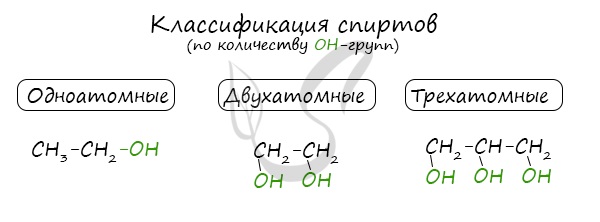
Одноатомные спирты также подразделяются в зависимости от положения OH-группы: первичные (OH-группа у первичного атома углерода),
вторичные (OH-группа у вторичного атома углерода) и третичные (OH-группа у третичного атома углерода).
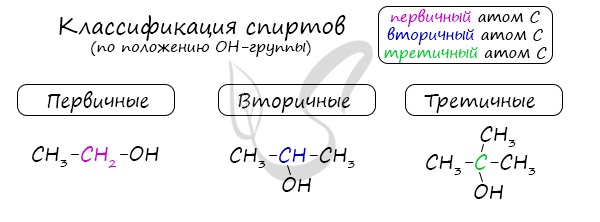
Номенклатура и изомерия спиртов
Названия спиртов формируются путем добавления суффикса «ол» к названию алкана с соответствующим числом атомов углерода: метанол,
этанол, пропанол, бутанол, пентанол и т.д.
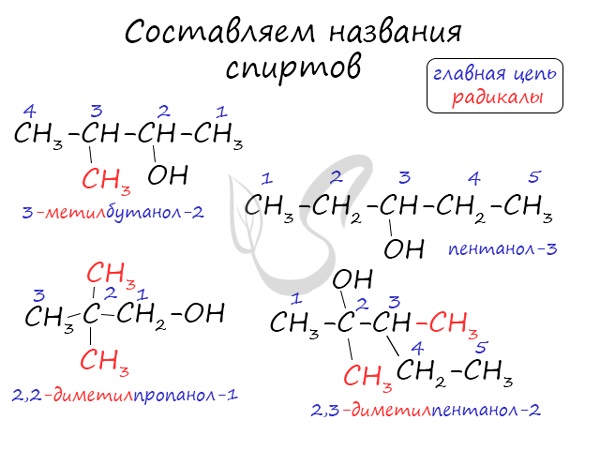
Для спиртов характерна изомерия углеродного скелета (начиная с бутанола), положения функциональной группы и межклассовая изомерия с
простыми эфирами, которых мы также коснемся в данной статье.
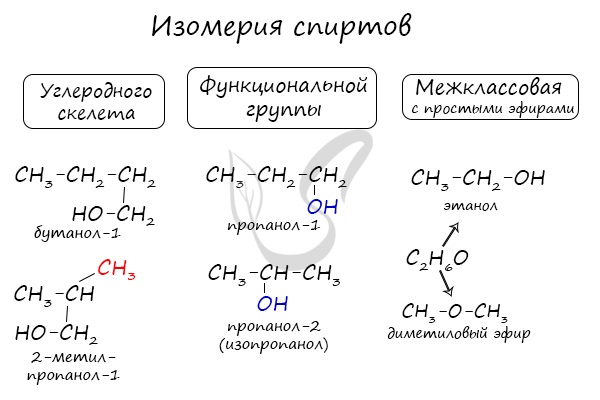
Получение спиртов
- Гидролиз галогеналканов водным раствором щелочи
- Гидратация алкенов
- Восстановление карбонильных соединений
- Получение метанола из синтез-газа
- Получение этанола брожением глюкозы
- Окисление алкенов KMnO4 в нейтральной (водной) среде
Помните, что в реакциях галогеналканов со сПИртовым раствором щелочи получаются Пи-связи (π-связи) — алкены, а в реакциях с водным раствором
щелочи образуются спирты.

Присоединения молекулы воды (HOH) протекает по правилу Марковникова. Атом водорода направляется к наиболее гидрированному атому углерода,
а гидроксогруппа идет к соседнему, наименее гидрированному, атому углерода.
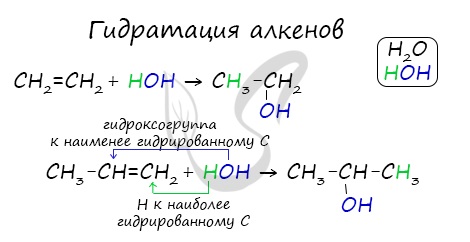
В результате восстановления альдегидов и кетонов получаются соответственно первичные и вторичные спирты.
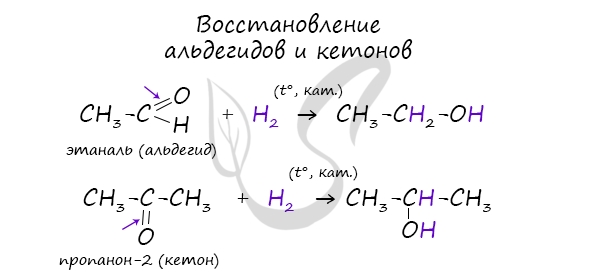
Синтез газом в промышленности называют смесь угарного газа и водорода, которая используется для синтеза различных
химических соединений, в том числе и метанола.
CO + 2H2 → (t,p,кат.) CH3-OH
В ходе брожения глюкозы выделяется углекислый газ и образуется этанол.
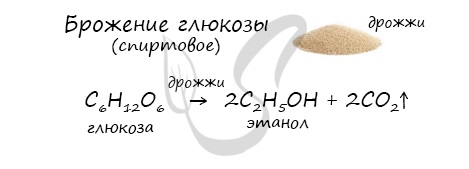
В результате такой реакции у атомов углерода, прилежащих к двойной связи, формируются гидроксогруппы — образуется двухатомный спирт (гликоль).
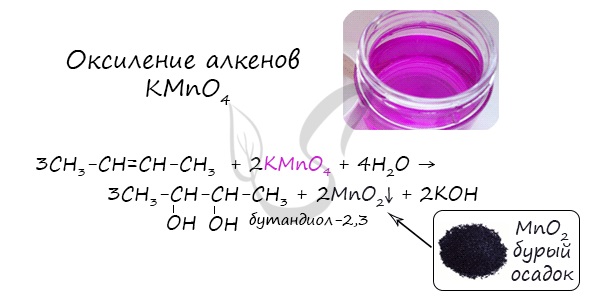
Химические свойства спиртов
Предельные спирты (не содержащие двойных и тройных связей) не вступают в реакции присоединения, это насыщенные кислородсодержащие соединения.
У спиртов проявляются новые свойства, которых мы раньше не касались в органической химии — кислотные.
- Кислотные свойства
- Реакция с галогеноводородами
- Реакции с кислотами
- Дегидратация спиртов
- Диметиловый эфир — CH3-O-CH3
- Метилэтиловый эфир — CH3-O-C2H5
- Диэтиловый эфир — C2H5-O-C2H5
- Окисление спиртов
- Качественная реакция на многоатомные спирты
- Кислотные свойства многоатомных спиртов
Щелочные металлы (Li, Na, K) способны вытеснять водород из спиртов с образованием солей: метилатов, этилатов, пропилатов и т.д.

Необходимо особо заметить, что реакция с щелочами (NaOH, KOH, LiOH) для предельных одноатомных спиртов невозможна, так как образующиеся
алкоголяты (соли спиртов) сразу же подвергаются гидролизу.
Реакция с галогеноводородами протекают как реакции обмена: атом галогена замещает гидроксогруппу, образуется молекула воды.
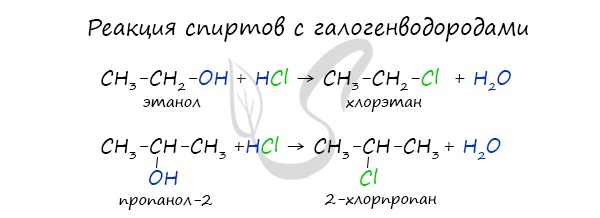
В результате реакций спиртов с кислотами образуются различные эфиры.

Дегидратация спиртов (отщепление воды) идет при повышенной температуре в присутствии серной кислоты (водоотнимающего) компонента.
Возможен межмолекулярный механизм дегидратации (при t < 140°С), в результате которого образуются простые эфиры. При более
высокой температуре (t > 140°С) механизм дегидратации становится внутримолекулярный — образуются алкены.
Названия простых эфиров формируются проще простого — по названию радикалов, входящих в состав эфира. Например:

Качественной реакцией на спирты является взаимодействие с оксидом меди II. В ходе такой реакции раствор приобретает характерное фиолетовое
окрашивание.
Замечу, что в обычных условиях третичные спирты окислению не подвергаются. Для них необходимы очень жесткие условия, при
которых углеродный скелет подвергается деструкции.

Вторичные и третичные спирты определяются другой качественной реакцией с хлоридом цинка II и соляной кислотой. В результате такой
реакции выпадает маслянистый осадок.
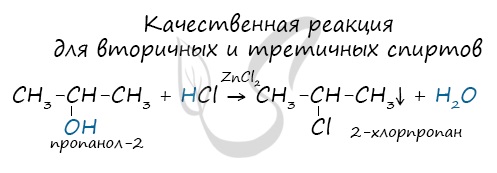
Первичные спирты окисляются до альдегидов, а вторичные — до кетонов. Альдегиды могут быть окислены далее — до карбоновых кислот, в отличие
от кетонов, которые являются «тупиковой ветвью развития» и могут только снова стать вторичными спиртами.
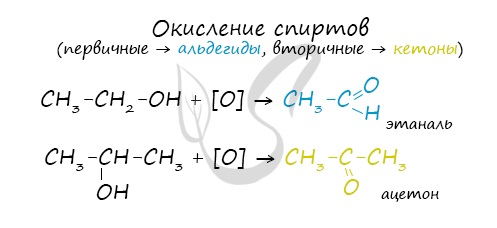
Такой реакцией является взаимодействие многоатомного спирта со свежеприготовленным гидроксидом меди II. В результате реакции раствор
окрашивается в характерный синий цвет.
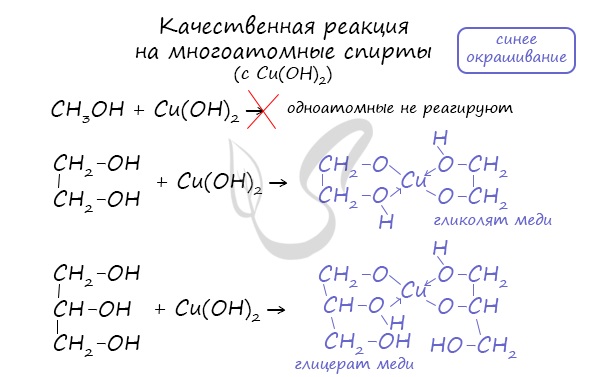
Важным отличием многоатомных спиртов от одноатомных является их способность реагировать со щелочами (что невозможно для одноатомных спиртов).
Это говорит об их более выраженных кислотных свойствах.
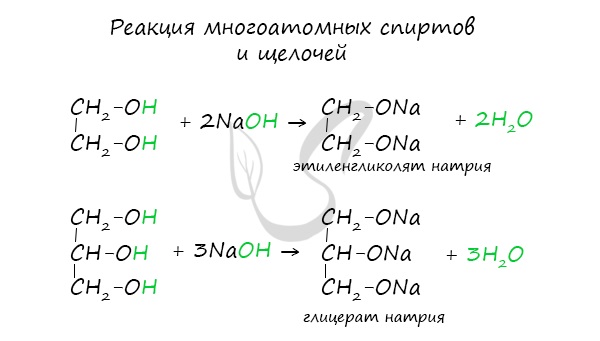
© Беллевич Юрий Сергеевич 2018-2022
Данная статья написана Беллевичем Юрием Сергеевичем и является его интеллектуальной собственностью. Копирование, распространение
(в том числе путем копирования на другие сайты и ресурсы в Интернете) или любое иное использование информации и объектов
без предварительного согласия правообладателя преследуется по закону. Для получения материалов статьи и разрешения их использования,
обратитесь, пожалуйста, к Беллевичу Юрию.
Содержание
- Определение
- Гомологический ряд, номенклатура, изомерия
- Строение молекул
- Свойства одноатомных спиртов
- Физические свойства
- Химические свойства
- Получение и применение спиртов (на примере этилового спирта)
- Многоатомные спирты
- Понятие о фенолах
- Выводы
Определение
Спирты — это производные углеводородов, в молекулах которых один или несколько атомов водорода замещены на гидроксогруппу ОН.
Если углеводородный радикал обозначить буквой R, то в общем виде формулу молекулы спирта можно изобразить так:
У атома углерода, который соединен с гидроксогруппой, все связи должны быть простыми:
Соединения, у которых гидроксогруппа находится рядом с двойной связью, неустойчивы:
По строению углеводородного радикала спирты делят на:
- предельные
в углеводородном радикале, все связи простые;
- непредельные
в углеводородном радикале, есть кратная связь;
- ароматические
имеется бензольное кольцо, т. е. в углеводородном радикале есть ароматическая связь.
По числу гидроксогрупп спирты делят на:
- одноатомные
в состав молекулы входит одна гидроксогруппа ОН;
- многоатомные
в состав молекул входит две или более (много) гидроксогрупп.
Рассмотрим строение молекул и свойства предельных одноатомных спиртов.
Гомологический ряд, номенклатура, изомерия
Для того чтобы вывести общую формулу гомологического ряда предельных одноатомных спиртов, сравним их состав и состав алканов:
В названиях спиртов гидроксогруппа обозначается суффиксом ОЛ. Этот суффикс прибавляется к названию исходного углеводорода:
Кроме этих названий (по ИЮПАК) для простейших спиртов используют рациональные названия, которые происходят от названия радикала:
Начиная с n = 3, для спиртов возможна изомерия. Она связана с положением группы ОН в молекуле:
Вопрос. Как обозначить положение группы ОН в молекуле?
Как всегда, положение группы ОН обозначают цифрой, которая соответствует номеру атома углерода, соединённому с группой ОН. Нумерацию основной цепи начинают с того конца, к которому ближе группа ОН.
Таким образом: название спирта (1) пропанол-1; название спирта (2) пропанол-2.
Поскольку спирты называют «по радикалам», эти спирты можно назвать и так: пропиловый спирт (1) и изопропиловый спирт (2).
Задание 22.1. Составьте молекулярные формулы этих спиртов и убедитесь, что это — изомеры.
Спирты изомерны простым эфирам, в молекулах которых атом кислорода соединяет два углеродных радикала (это изомерия между разными классами веществ):
Простые эфиры — это вещества, в молекулах которых два радикала соединены атомом кислорода. Поэтому их называют, исходя из названий радикалов. Например, простой эфир (3) — это диметиловый эфир.
Задание 22.2. Составьте графическую формулу изомера пропиловых спиртов, который является простым эфиром. Назовите его.
Строение молекул
Если при помощи графической формулы показать строение молекулы этилового спирта, то легко можно увидеть, что атомы водорода в ней неравноценны:
Действительно, пять атомов водорода соединены с атомами углерода, а один — с атомом кислорода. Теория Бутлерова утверждает, что «атомы в молекуле взаимно влияют друг на друга». Поэтому можно ожидать, что этот атом водорода будет отличаться от остальных пяти. Это отличие заключается в том, что связь О–Н гораздо более полярна, чем связи С–Н. Дело в том, что атом кислорода имеет бОльшую электроотрицательность, чем атом углерода, т. е. способен сильнее смещать к себе общую пару электронов. В результате, на атомах кислорода и водорода связи О–Н появляются значительные заряды (+) и (–).
Вопрос. На каком атоме появляется (+), а на каком (–)?
Величина этих зарядов меньше единицы, но они способны притягивать к себе молекулы других реагирующих веществ, т. е. активнее участвовать в химических реакциях будут наиболее полярные связи.
Вывод. Самыми полярными связями в молекуле спирта являются связи О–Н и О–С. За счёт их разрыва происходят химические реакции (спирт функционирует). Поэтому ОH — функциональная группа спиртов.
Свойства одноатомных спиртов
Физические свойства
Поскольку в молекуле спирта появились полярные связи, он, в отличие от углеводородов, будет иметь более высокие температуры кипения и плавления (если сравнивать соединения с одинаковым числом атомов углерода). Это связано с тем, что полярные молекулы сильнее притягиваются друг к другу, и для того чтобы оторвать их друг от друга (перевести жидкость в газ), нужно затратить много энергии — дополнительно нагреть. Кроме того, между молекулами спиртов возникают водородные связи (а), которые дополнительно притягивают молекулы друг к другу. Поэтому этиловый спирт — бесцветная жидкость (а этан и диметиловый эфир — газы!) с т. кип. 78 °C. Спирт хорошо растворим в воде, так как и с молекулами воды спирт образует водородные связи (б).
Водородные связи непрочные, поэтому низшие одноатомные спирты (мало атомов углерода в молекуле) — летучие жидкости с характерным запахом.
Химические свойства
Спирты могут реагировать с натрием и другими щелочными металлами. При этом атом водорода ОН-группы замещается на атом металла:
Вопрос. Неорганические вещества какого класса способны вступать в реакции замещения с металлами, в результате чего выделяется водород?
Аналогичную реакцию дают кислоты, поэтому в этой реакции спирт проявляет кислотные свойства. Но это очень слабые свойства, так как растворы спиртов не изменяют окраску индикаторов и не реагируют с растворами щелочей.
Спирты реагируют с неорганическими кислотами:
В этой реакции отщепляется молекула воды, — значит, это реакция дегидратации. При записи таких реакций формулы исходных веществ записывайте так, чтобы функциональные группы были рядом, причём атомы водорода функциональных групп ОН «смотрели» друг на друга. Так, в результате реакции дегидратации, в которой участвуют две молекулы спирта, образуется простой эфир (дегидратация межмолекулярная):
Эта реакция происходит в присутствии концентрированной серной кислоты. Если смесь спирта и концентрированной серной кислоты нагреть сильнее, то молекула воды отщепляется от одной молекулы спирта (дегидратация внутримолекулярная):
Спирты, у которых ОН-группа соединена с первым (последним) атомом углерода углеродной цепочки (первичные спирты) легко окисляются нагретым оксидом меди CuO, превращаясь в альдегиды:
При составлении этой реакции рекомендуется выделить (подчеркнуть) те атомы, которые образуют воду, и записать новую формулу без этих атомов. Спирты горят, образуя, как и углеводороды, углекислый газ и воду.
Задание 22.3. Составьте уравнение реакции горения этилового спирта.
Таким образом, для спиртов характерны реакции:
- замещения атома водорода ОН-группы;
- дегидратации (отщепления воды);
- окисления.
Все эти реакции идут с участием ОН-группы функциональной группы спиртов.
Задание 22.4. Составьте уравнения таких реакций для пропанола-1 (пропилового спирта). Уравнения реакций составляйте по аналогии с вышеперечисленными.
Получение и применение спиртов (на примере этилового спирта)
Этанол и другие спирты можно получить из алкенов.
Вопрос. При помощи какой реакции можно это осуществить (при затруднении см. урок 19.3)?
Задание 22.5. Составьте уравнение этой реакции.
Полученный таким способом спирт используют в технических целях: в качестве растворителя, для получения каучука, пластмасс и др. Кроме того, спирт используют как горючее.
Пищевой и медицинский спирты получают брожением глюкозы:
В лаборатории этиловый спирт можно получить гидролизом (взаимодействием с водой) хлорэтана:
Для того чтобы эта реакция стала необратимой, используют водный раствор щёлочи.
Задание 22.6. Составьте уравнения реакций:
- пропен + вода;
- 1-хлорпропан + NaOH (водный).
Назовите полученные вещества.
Многоатомные спирты
Многоатомные спирты содержат две и более гидроксогруппы в молекуле. При этом каждый атом углерода в молекулах спиртов может соединяться только с одной гидроксогруппой ОН, в противном случае образуются неустойчивые соединения:
Задание 22.7. Составьте формулы многоатомных спиртов, в молекуле которых:
- два атома углерода и две гидроксогруппы;
- три атома углерода и три гидроксогруппы.
У вас получились формулы простейших многоатомных спиртов:
Вопрос. Как в названии спирта обозначить число гидроксогрупп?
Названия по IUPAC этих спиртов составляют, используя уже известные правила, т. е. к названию углеводорода добавляют суффикс ОЛ, а перед ним указывают число ОН-групп при помощи префиксов ди- или три-. Например, этиленгликоль получит название: этандиол.
Задание 22.8. Назовите по правилам IUPAC глицерин.
Вопрос. Как вы считаете, какой из спиртов будет иметь большую температуру кипения — глицерин или пропанол-1? А растворимость в воде?
Многоатомные спирты за счёт многочисленных ОН-групп образуют многочисленные водородные связи и друг с другом, и с водой. Поэтому они имеют бОльшие температуры кипения и бОльшую растворимость в воде по сравнению с соответствующими одноатомными спиртами. Так, глицерин — бесцветная, густая жидкость, без запаха; он смешивается с водой в любых соотношениях и способен поглощать влагу из воздуха. Более того, безводный глицерин может отнимать воду из живых клеток кожи, вызывая ожоги. Растворы глицерина, наоборот, смягчают кожу.
Химические свойства глицерина и других многоатомных спиртов очень похожи на свойства одноатомных спиртов: они реагируют с натрием и НСl, образуют эфиры, могут окисляться. Например, глицерин реагирует с азотной кислотой:
Нитроглицерин входит в состав сильнейшей взрывчатой смеси динамита. Его раствор используется как лекарство.
Но в химических свойствах многоатомных спиртов есть и существенные отличия. Так, они могут растворять осадок гидроксида меди II, образуя ярко-синий раствор:
Реакция происходит при обычных условиях, причём полученное соединение очень прочное: не изменяет свой цвет даже при кипячении. Одноатомные спирты такую реакцию не дают.
Вывод. Реакция растворения голубого осадка гидроксида меди II с образованием ярко-синего раствора — это качественная реакция на многоатомные спирты.
Задание 22.9. Составьте уравнения реакций этиленгликоля:
- с азотной кислотой;
- с Сu(ОН)2.
Подсказка. При составлении уравнений этих реакций записывайте формулы многоатомных спиртов так, чтобы цепочки атомов углерода располагались вертикально, а группы ОН были рядом, причём атомы водорода функциональных групп ОН «смотрели» друг на друга.
Глицерин находит широкое применение в кожевенной промышленности (смягчает кожу), используется в медицине, входит в состав невысыхающих красок. Кроме того, глицерин, точнее, остаток его молекулы входит в состав любого жира. Поэтому глицерин часто получают из природных жиров (уравнение реакции в уроке 25).
Понятие о фенолах
К фенолам относятся вещества, в молекулах которых гидроксогруппа ОН непосредственно связана с бензольным кольцом:
В этой молекуле ОН-группа и бензольное кольцо взаимно влияют друг на друга. Поэтому фенол по свойствам отличается и от спиртов, и от бензола. Рассмотрим примеры такого влияния.
Бензольное кольцо влияет на ОН-группу, делая её более полярной, чем у спиртов. Поэтому фенол, в отличие от спиртов, реагирует с растворами щелочей:
или
В данной реакции фенол проявляет свойства кислоты. Отсюда его второе название — карболовая кислота («карболка»). Растворы фенола изменяют окраску индикатора.
Гидроксогруппа влияет на бензольное кольцо. Фенол очень легко вступает в реакции замещения, причём, как и для толуола, реакция происходит в положениях 2, 4, 6 по отношению к гидроксогруппе:
В отличие от спиртов и бензола фенол обесцвечивает бромную воду даже при нормальных условиях. Реакция протекает аналогично предыдущей.
Задание 22.9. Составьте уравнение реакции фенола с бромом и сравните эту реакцию с реакцией толуола с бромом.
Фенол легко окисляется на воздухе, при этом его белые кристаллы розовеют. Фенол сильно ядовит, так как изменяет структуру и свойства белков — основу всего живого. Кроме того, попадая в воду, он окисляется растворённым в ней кислородом. В результате содержание кислорода в водоёме уменьшается, и обитатели его погибают. Для того чтобы обнаружить фенол в водоёме и любом растворе, используют качественную реакцию с FeCl3: при добавлении этого реактива к смеси, содержащей фенол, появляется фиолетовое окрашивание.
Фенол получают из производных бензола и каменноугольной смолы. В любом случае вначале исходное вещество или смесь превращают в фенолят, а затем выделяют чистый фенол при помощи кислоты:
Фенол применяют для дезинфекции и получения красителей и полимеров.
Выводы
Спирты и фенолы — это производные углеводородов, содержащие функциональную группу ОН. Для таких веществ характерны реакции замещения атома водорода в гидроксогруппе.
Спирты за счёт функциональной группы ОН образуют простые и сложные эфиры (см. урок 25), а фенолы реагируют и за счёт функциональной группы ОН, и за счёт ароматического ядра.
Гидроксисоединения – это органические вещества, молекулы которых содержат, помимо углеводородной цепи, одну или несколько гидроксильных групп ОН.
Гидроксисоединения делят на спирты и фенолы.
Строение, изомерия и гомологический ряд спиртов
Химические свойства спиртов
Способы получения спиртов
Если гидроксогруппа ОН соединена с бензольным кольцом, то вещество относится к фенолам.
Общая формула предельных нециклических спиртов: CnH2n+2Om, где m ≤ n.
Классификация спиртов
По числу гидроксильных групп:
- одноатомные спирты — содержат одну группу -ОН. Общая формула CnH2n+1OH или CnH2n+2O.
- двухатомные — содержат две группы ОН. Общая формула CnH2n(OH)2 или CnH2n+2O2.
- трехатомные спирты — содержат три группы ОН. Общая формула CnH2n-1(OH)3 или CnH2n+2O3.
Двухатомные спирты с двумя и тремя гидроксогруппами у одного атома углерода R‒CH(OH)2 или R-C(OH)3 неустойчивы, от них легко отрывается вода и образуется карбонильное соединение.
Классификация по числу углеводородных радикалов у атома углерода при гидроксильной группе
- Первичные спирты – группа ОН соединена с первичным атомом углерода. Например, этанол СН3–СН2–ОН.
- Вторичные спирты – группа ОН соединена с вторичным атомом углерода. Например, пропанол-2: СН3–СН(СН3)–ОН.
- Третичные спирты – группа ОН соединена с третичным атомом углерода. Например, 2-метилпропанол-2: (СН3)3С–ОН.
- Метанол не относится ни к первичным, ни к вторичным, ни к третичным спиртам.
Классификация по строению углеводородного радикала
- Предельные спирты – группа ОН соединена с предельным радикалом. Например, пропанол-1: СН3–СН2–СН2–ОН.
- Непредельные спирты – группа ОН соединена с непредельным радикалом. Например, алкенолы: СН2=СН–СН2–ОН.
Непредельные спирты, в которых гидроксильная группа соединена с атомом углерода при двойной связи (алкенолы), неустойчивы и изомеризуются в соответствующие карбонильные соединения.
- Ароматические спирты – содержат в радикале ароматическое кольцо, не связанное непосредственно с группой ОН. Например, бензиловый спирт.
Строение спиртов и фенолов
В молекулах спиртов, помимо связей С–С и С–Н, присутствуют ковалентные полярные химические связи О–Н и С–О.
Электроотрицательность кислорода (ЭО = 3,5) больше электроотрицательности водорода (ЭО = 2,1) и углерода (ЭО = 2,4).
Электронная плотность обеих связей смещена к более электроотрицательному атому кислорода:
Атом кислорода в спиртах находится в состоянии sp3-гибридизации.
В образовании химических связей с атомами C и H участвуют две 2sp3-гибридные орбитали, а еще две 2sp3-гибридные орбитали заняты неподеленными электронными парами атома кислорода.
Поэтому валентный угол C–О–H близок к тетраэдрическому и составляет почти 108о.
Водородные связи и физические свойства спиртов
Спирты образуют межмолекулярные водородные связи. Водородные связи вызывают притяжение и ассоциацию молекул спиртов:
Поэтому спирты – жидкости с относительно высокой температурой кипения (температура кипения метанола +64,5оС). Температуры кипения многоатомных спиртов и фенолов значительно выше.
Таблица. Температуры кипения некоторых спиртов и фенола.
| Название вещества | Температура кипения |
| Метанол | 64 |
| Этанол | 78 |
| Пропанол-1 | 92 |
| Бутанол-1 | 118 |
| Этиленгликоль | 196 |
| Фенол | 181,8 |
Водородные связи образуются не только между молекулами спиртов, но и между молекулами спиртов и воды. Поэтому спирты очень хорошо растворимы в воде. Молекулы спиртов в воде гидратируются:
Чем больше углеводородный радикал, тем меньше растворимость спирта в воде. Чем больше ОН-групп в спирте, тем больше растворимость в воде.
Низшие спирты (метанол, этанол, пропанол, изопропанол, этиленгликоль и глицерин) смешиваются с водой в любых соотношениях.
Номенклатура спиртов
- По систематической номенклатуре к названию углеводорода добавляют суффикс «-ОЛ» и цифру, указывающую номер атома углерода, к которому присоединена гидроксильная группа.
Нумерация ведется от ближайшего к ОН-группе конца цепи.
- По радикально-функциональной номенклатуре названия спиртов составляют от названий углеводородных радикалов, соединенных с группой ОН, с добавлением слова «спирт».
Например: СН3ОН – метиловый спирт, С2Н5ОН – этиловый спирт и т.д.
- В названиях многоатомных спиртов количество групп ОН указывают суффиксами -диол в при наличии двух ОН-групп, -триол при наличии трех ОН-групп и т.д. После этого добавляют номера атомов углерода, связанных с гидроксильными группами.
Например, пропандиол-1,2 (пропиленгликоль):
Изомерия спиртов
Структурная изомерия
Для спиртов характерна структурная изомерия – изомерия углеродного скелета, изомерия положения гидроксильной группы и межклассовая изомерия.
Структурные изомеры — это соединения с одинаковым составом, которые отличаются порядком связывания атомов в молекуле, т.е. строением молекул.
Изомеры углеродного скелета характерна для спиртов, которые содержат не менее четырех атомов углерода.
Например. Формуле С4Н9ОН соответствуют четыре структурных изомера, из них два различаются строением углеродного скелета
Межклассовые изомеры — это вещества разных классов с различным строением, но одинаковым составом. Спирты являются межклассовыми изомерами с простыми эфирами. Общая формула и спиртов, и простых эфиров — CnH2n+2О.
Например. Межклассовые изомеры с общей формулой С2Н6О этиловый спирт СН3–CH2–OH и диметиловый эфир CH3–O–CH3
| Этиловый спирт | Диметиловый эфир |
| СН3–CH2–OH | CH3–O–CH3 |
Изомеры с различным положением группы ОН отличаются положением гидроксильной группы в молекуле. Такая изомерия характерна для спиртов, которые содержат три или больше атомов углерода.
Например. Пропанол-1 и пропанол-2
Химические свойства спиртов
Спирты – органические вещества, молекулы которых содержат, помимо углеводородной цепи, одну или несколько гидроксильных групп ОН.
Химические реакции гидроксисоединений идут с разрывом одной из связей: либо С–ОН с отщеплением группы ОН, либо связи О–Н с отщеплением водорода. Это реакции замещения, либо реакции отщепления (элиминирования).
Свойства спиртов определяются строением связей С–О–Н. Связи С–О и О–Н — ковалентные полярные. При этом на атоме водорода образуется частичный положительный заряд δ+, на атоме углерода также частичный положительный заряд δ+, а на атоме кислорода — частичный отрицательный заряд δ–.
Такие связи разрываются по ионному механизму. Разрыв связи О–Н с отрывом иона Н+ соответствует кислотным свойствам гидроксисоединения. Разрыв связи С–О соответствует основным свойствам и реакциям нуклеофильного замещения.
С разрывом связи О–Н идут реакции окисления, а с разрывом связи С–О — реакции восстановления.
- слабые кислотные свойства, замещение водорода на металл;
- замещение группы ОН
- отрыв воды (элиминирование) – дегидратация
- окисление
- образование сложных эфиров — этерификация
1. Кислотные свойства
Спирты – неэлектролиты, в водном растворе не диссоциируют на ионы; кислотные свойства у них выражены слабее, чем у воды.
1.1. Взаимодействие с раствором щелочей
При взаимодействии спиртов с растворами щелочей реакция практически не идет, т. к. образующиеся алкоголяты почти полностью гидролизуются водой.
Равновесие в этой реакции так сильно сдвинуто влево, что прямая реакция не идет. Поэтому спирты не взаимодействуют с растворами щелочей.
Многоатомные спирты также не реагируют с растворами щелочей.
1.2. Взаимодействие с металлами (щелочными и щелочноземельными)
Спирты взаимодействуют с активными металлами (щелочными и щелочноземельными). При этом образуются алкоголяты. При взаимодействии с металлами спирты ведут себя, как кислоты.
Например, этанол взаимодействует с калием с образованием этилата калия и водорода.
Видеоопыт взаимодействия спиртов (метанола, этанола и бутанола) с натрием можно посмотреть здесь.
Алкоголяты под действием воды полностью гидролизуются с выделением спирта и гидроксида металла.
Например, этилат калия разлагается водой:
CH3OH > первичные спирты > вторичные спирты > третичные спирты
Многоатомные спирты также реагируют с активными металлами:
Видеоопыт взаимодействия глицерина с натрием можно посмотреть здесь.
1.3. Взаимодействие с гидроксидом меди (II)
Многоатомные спирты взаимодействуют с раствором гидроксида меди (II) в присутствии щелочи, образуя комплексные соли (качественная реакция на многоатомные спирты).
Например, при взаимодействии этиленгликоля со свежеосажденным гидроксидом меди (II) образуется ярко-синий раствор гликолята меди:
Видеоопыт взаимодействия этиленгликоля с гидроксидом меди (II) можно посмотреть здесь.
2. Реакции замещения группы ОН
2.1. Взаимодействие с галогеноводородами
При взаимодействии спиртов с галогеноводородами группа ОН замещается на галоген и образуется галогеналкан.
Например, этанол реагирует с бромоводородом.
Видеоопыт взаимодействия этилового спирта с бромоводородом можно посмотреть здесь.
третичные > вторичные > первичные > CH3OH.
Многоатомные спирты также, как и одноатомные спирты, реагируют с галогеноводородами.
Например, этиленгликоль реагирует с бромоводородом:
2.2. Взаимодействие с аммиаком
Гидроксогруппу спиртов можно заместить на аминогруппу при нагревании спирта с аммиаком на катализаторе.
Например, при взаимодействии этанола с аммиаком образуется этиламин.
2.3. Этерификация (образование сложных эфиров)
Одноатомные и многоатомные спирты вступают в реакции с карбоновыми кислотами, образуя сложные эфиры.
Например, этанол реагирует с уксусной кислотой с образованием этилацетата (этилового эфира уксусной кислоты):
Многоатомные спирты вступают в реакции этерификации с органическими и неорганическими кислотами.
Например, этиленгликоль реагирует с уксусной кислотой с образованием ацетата этиленгликоля:
2.4. Взаимодействие с кислотами-гидроксидами
Спирты взаимодействуют и с неорганическими кислотами, например, азотной или серной.
Например, при взаимодействии этанола с азотной кислотой образуется сложный эфир этилнитрат:
Например, глицерин под действием азотной кислоты образует тринитрат глицерина (тринитроглицерин):
3. Реакции замещения группы ОН
В присутствии концентрированной серной кислоты от спиртов отщепляется вода. Процесс дегидратации протекает по двум возможным направлениям: внутримолекулярная дегидратация и межмолекулярная дегидратация.
3.1. Внутримолекулярная дегидратация
При высокой температуре (больше 140оС) происходит внутримолекулярная дегидратация и образуется соответствующий алкен.
Например, из этанола под действием концентрированной серной кислоты при температуре выше 140 градусов образуется этилен:
В качестве катализатора этой реакции также используют оксид алюминия.
Отщепление воды от несимметричных спиртов проходит в соответствии с правилом Зайцева: водород отщепляется от менее гидрогенизированного атома углерода.
Например, в присутствии концентрированной серной кислоты при нагревании выше 140оС из бутанола-2 в основном образуется бутен-2:
3.2. Межмолекулярная дегидратация
При низкой температуре (меньше 140оС) происходит межмолекулярная дегидратация по механизму нуклеофильного замещения: ОН-группа в одной молекуле спирта замещается на группу OR другой молекулы. Продуктом реакции является простой эфир.
Например, при дегидратации этанола при температуре до 140оС образуется диэтиловый эфир:
4. Окисление спиртов
Реакции окисления в органической химии сопровождаются увеличением числа атомов кислорода (или числа связей с атомами кислорода) в молекуле и/или уменьшением числа атомов водорода (или числа связей с атомами водорода).
В зависимости от интенсивности и условий окисление можно условно разделить на каталитическое, мягкое и жесткое.
Первичный спирт → альдегид → карбоновая кислота
Метанол → формальдегид → углекислый газ
Вторичные спирты окисляются в кетоны: вторичные спирты → кетоны
Типичные окислители — оксид меди (II), перманганат калия KMnO4, K2Cr2O7, кислород в присутствии катализатора.
Легкость окисления спиртов уменьшается в ряду:
метанол < первичные спирты < вторичные спирты < третичные спирты
Продукты окисления многоатомных спиртов зависят от их строения. При окислении оксидом меди многоатомные спирты образуют карбонильные соединения.
4.1. Окисление оксидом меди (II)
Cпирты можно окислить оксидом меди (II) при нагревании. При этом медь восстанавливается до простого вещества. Первичные спирты окисляются до альдегидов, вторичные до кетонов, а метанол окисляется до метаналя.
Например, этанол окисляется оксидом меди до уксусного альдегида
Видеоопыт окисления этанола оксидом меди (II) можно посмотреть здесь.
Например, пропанол-2 окисляется оксидом меди (II) при нагревании до ацетона
Третичные спирты окисляются только в жестких условиях.
4.2. Окисление кислородом в присутствии катализатора
Cпирты можно окислить кислородом в присутствии катализатора (медь, оксид хрома (III) и др.). Первичные спирты окисляются до альдегидов, вторичные до кетонов, а метанол окисляется до метаналя.
Например, при окислении пропанола-1 образуется пропаналь
Видеоопыт каталитического окисления этанола кислородом можно посмотреть здесь.
Например, пропанол-2 окисляется кислородом при нагревании в присутствии меди до ацетона
Третичные спирты окисляются только в жестких условиях.
4.3. Жесткое окисление
При жестком окислении под действием перманганатов или соединений хрома (VI) первичные спирты окисляются до карбоновых кислот, вторичные спирты окисляются до кетонов, метанол окисляется до углекислого газа.
При нагревании первичного спирта с перманганатом или дихроматом калия в кислой среде может образоваться также альдегид, если его сразу удаляют из реакционной смеси.
Третичные спирты окисляются только в жестких условиях (в кислой среде при высокой температуре) под действием сильных окислителей: перманганатов или дихроматов. При этом происходит разрыв углеродной цепи и могут образоваться углекислый газ, карбоновая кислота или кетон, в зависимости от строения спирта.
| Спирт/ Окислитель | KMnO4, кислая среда | KMnO4, H2O, t |
| Метанол СН3-ОН | CO2 | K2CO3 |
| Первичный спирт R-СН2-ОН | R-COOH/ R-CHO | R-COOK/ R-CHO |
| Вторичный спирт R1-СНОН-R2 | R1-СО-R2 | R1-СО-R2 |
Например, при взаимодействии метанола с перманганатом калия в серной кислоте образуется углекислый газ
Например, при взаимодействии этанола с перманганатом калия в серной кислоте образуется уксусная кислота
Например, при взаимодействии изопропанола с перманганатом калия в серной кислоте образуется ацетон
4.4. Горение спиртов
Образуются углекислый газ и вода и выделяется большое количество теплоты.
CnH2n+1ОН + 3n/2O2 → nCO2 + (n+1)H2O + Q
Например, уравнение сгорания метанола:
2CH3OH + 3O2 = 2CO2 + 4H2O
5. Дегидрирование спиртов
При нагревании спиртов в присутствии медного катализатора протекает реакция дегидрирования. При дегидрировании метанола и первичных спиртов образуются альдегиды, при дегидрировании вторичных спиртов образуются кетоны.
Например, при дегидрировании этанола образуется этаналь
Например, при дегидрировании этиленгликоля образуется диальдегид (глиоксаль)
Получение спиртов
1. Щелочной гидролиз галогеналканов
При взаимодействии галогеналканов с водным раствором щелочей образуются спирты. Атом галогена в галогеналкане замещается на гидроксогруппу.
Например, при нагревании хлорметана с водным раствором гидроксида натрия образуется метанол
Например, глицерин можно получить щелочным гидролизом 1,2,3-трихлорпропана:
2. Гидратация алкенов
Гидратация (присоединение воды) алкенов протекает в присутствии минеральных кислот. При присоединении воды к алкенам образуются спирты.
Например, при взаимодействии этилена с водой образуется этиловый спирт.
Гидратация алкенов также протекает по ионному (электрофильному) механизму.
Для несимметричных алкенов реакция идёт преимущественно по правилу Марковникова.
Например, при взаимодействии пропилена с водой образуется преимущественно пропанол-2.
3. Гидрирование карбонильных соединений
Присоединение водорода к альдегидам и кетонам протекает при нагревании в присутствии катализатора. При гидрировании альдегидов образуются первичные спирты, при гидрировании кетонов — вторичные спирты, а из формальдегида образуется метанол.
Например, при гидрировании этаналя образуется этанол
Например: при гидрировании ацетона образуется изопропанол
Например, гидрирование диальдегида – один из способов получения этиленгликоля
4. Окисление алкенов холодным водным раствором перманганата калия
Алкены реагируют с водным раствором перманганата калия без нагревания. При этом образуются двухатомные спирты (гликоли).
5. Промышленное получение метанола из «синтез-газа»
Каталитический синтез метанола из монооксида углерода и водорода при 300-400°С и давления 500 атм в присутствии смеси оксидов цинка, хрома и др.
Сырьем для синтеза метанола служит «синтез-газ» (смесь CO и H2), обогащенный водородом:
CO + 2H2 ⇄ CH3OH
6. Получение этанола спиртовым брожением глюкозы
Для глюкозы характерно ферментативное брожение, то есть распад молекул на части под действием ферментов. Один из вариантов — спиртовое брожение.
7. Гидролиз жиров – способ получения многоатомных спиртов
Под действием кислоты жиры гидролизуются до глицерина и карбоновых кислот, которых входили в молекулу жира.
Например: при гидролизе тристеарата глицерина образуется глицерин и стеариновая кислота
При щелочном гидролизе жиров образуется глицерин и соли карбоновых кислот, входивших в состав жира.
Например: при щелочном гидролизе тристеарата глицерина образуется глицерин и соль стеариновой кислоты (стеарат)

